Some posts on this site contain affiliate links. If you book or buy something through these links, I earn a small commission (at no extra cost to you). Take a look at my privacy policy for more information.
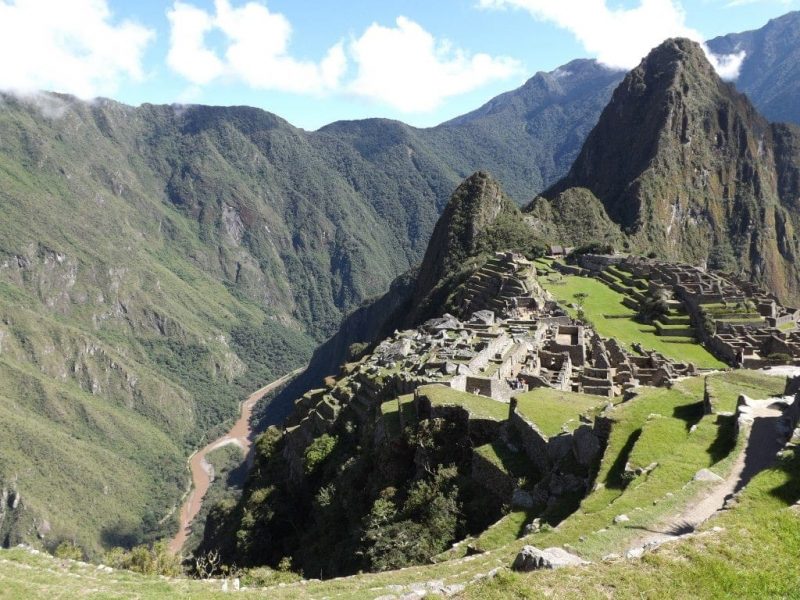
Wayyyyyyy back in 2014, I spent five months backpacking through South America with my then-boyfriend. After starting in Colombia – the second country on our backpacking trip was Peru.
To get there overland, we sailed down the Amazon River from Leticia in Colombia to Iquitos in Peru. It was a proper adventure – slow, uncomfortable at times, but with incredible views of the Amazon rainforest and the feeling that we were seeing something that few people back home ever would!
Throughout the trip, I wrote blog posts and shared them almost in real-time as we went. Those posts are now nearly a decade old, so are probably too out of date to be of any use to other travellers.
They’re also embarrassingly bad: I like to think I’ve improved a lot as a writer in the last decade! This was before I knew anything about blogging or became a full-time blogger, before I knew what I wanted this blog to be. I was just bashing out nerdy little diary-style blog entries on the fly, sometimes trying (without much success) to be all creative and poetic like a high-brow travel journalist, at other times just sounding like an excited child.
Realistically, these blog posts don’t have a place on my site any more. But that South America trip was a huge chapter in my life – as well as in the history of this blog. These blog posts are part of the journey that brought me to where I am today. So instead of deleting them all, I’ve gathered them all up, in order, onto one page.
Honestly – I’m only keeping these blog posts here for me, because they have so much sentimental value! I’m only writing this intro in case anyone stumbles upon this page and wonders why they’re suddenly immersed in a bunch of childish diaries (many of which start with what I had for breakfast and go downhill from there). Don’t judge me, I was young and excited!!
So without any more self-deprecating rambling, here are my Peru diaries in all their pure, naive glory…
- One Day Amazon Jungle Tour in Iquitos Peru
- Reaching the North Coast: Chiclayo
- Sipan Tombs and Tucume at Chiclayo
- Chan Chan, Trujillo
- Chan Chan Photos
- Huacas del Sol y de la Luna, Trujillo
- Lima’s Centre and San Francisco Catacombs
- Taking the Peru Hop Bus from Lima to Cusco Bus
- Ballestas Islands in Paracas
- Adrenaline Overload in Huacachina
- Nazca Lines Flight
- Cusco Shopping, Sightseeing and Massages
- Inca Jungle Trek to Machu Picchu
- Machu Picchu
- Free Walking Tour Cusco
- Three-Day Colca Canyon Trek, Peru
- Colca Canyon Trek, Day One
- Colca Canyon Trek, Day Two
- Colca Canyon Trek, Day Three
- Arequipa Walking Tour
- Floating Islands, Lake Titicaca
One Day Amazon Jungle Tour in Iquitos Peru
18 March 2014
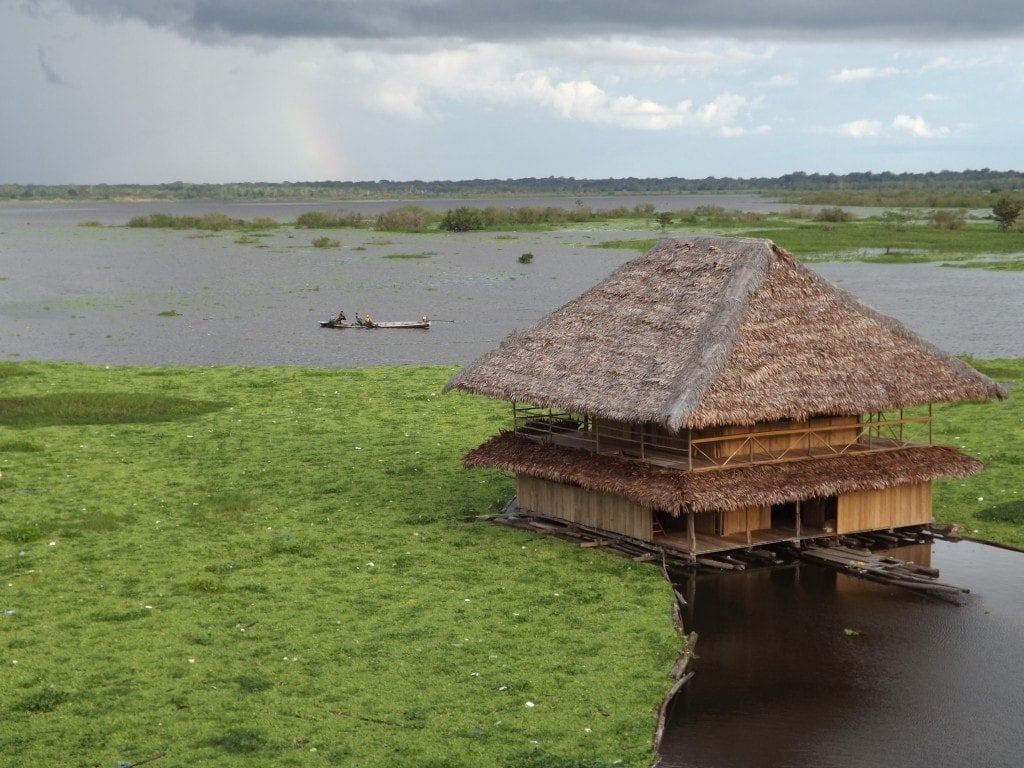
Iquitos, a surprisingly large town in the very heart of the Amazon rainforest in Peru, is one of the biggest cities in the world that’s unreachable by road.
We had sailed down the Amazon river from Colombia to reach it, and now found ourselves in a bizarre town filled with architecture that must have been grand and beautiful once but had been decaying since the rubber boom and now looked strangely sad and lonely.
We spent our first day catching up with the irritating basics like laundry and internet banking that get so easily neglected whilst on the road, but at the same time managed to explore some of the town, which brought to colourful reality the book I’d been reading before our arrival, Nicholas Shakespeare’s The Vision of Elena Silves.
The market port of Belen, the floating wooden houses built on rafts surrounded by thick greenery growing straight on the river’s surface, the bizarre metal house of Casa de Fierro built by Gustave Eiffel and transported to Iquitos by a rubber baron in 1890, all brought the dreamlike pages of Shakespeare’s novel to life and seemed drenched in a surreal and terrible history.
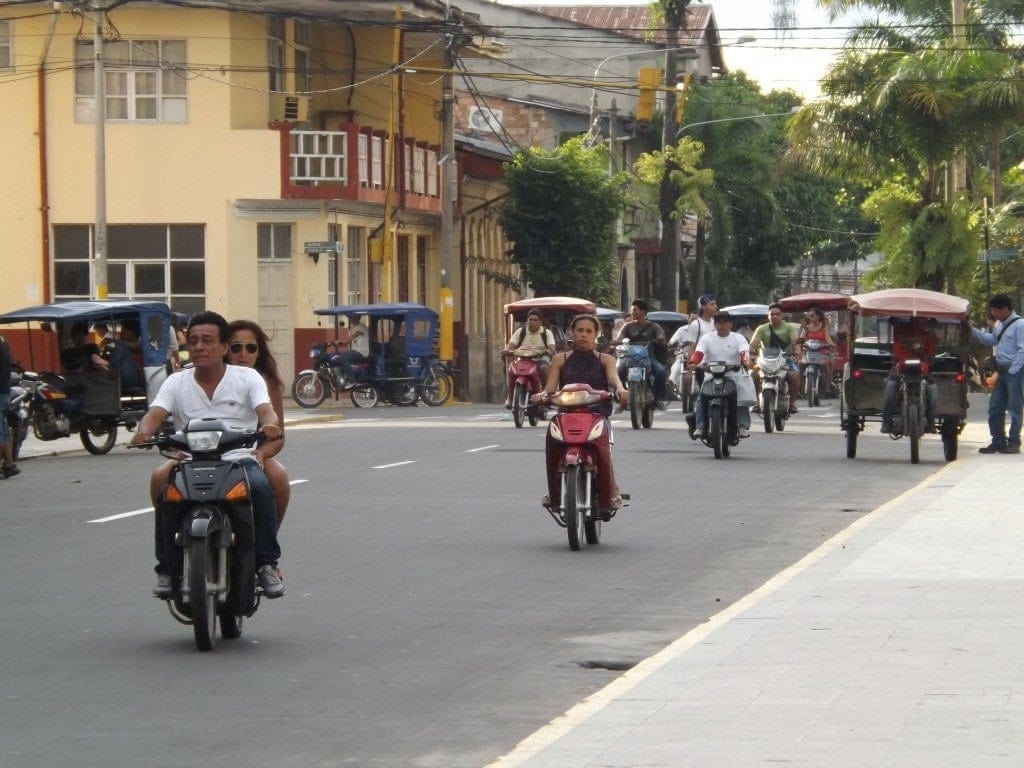
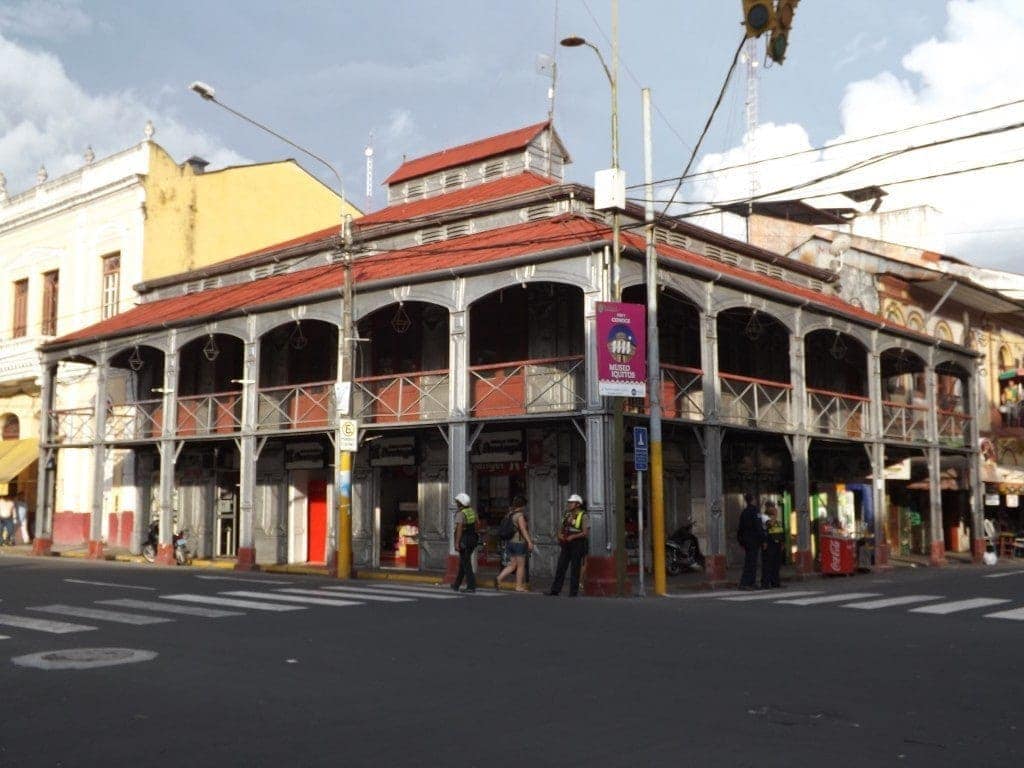
One Day Amazon Jungle Tour from Iquitos
After our catch-up day, we wanted to book a tour into the jungle we’d come to see. Our first ‘Amazon tour’ had been a slight disappointment, so we asked Cop, the adorable, motherly Thai owner of our hostal and our new best friend, for a recommendation; and she walked us down the road to the office of Wimba Tours.
The next day, they took us out for a full day tour, starting with two hour’s boat ride down river. En route, our enthusiastic and lovely guide Alfredo would not stop giving us facts, pointing out trees and listing what ailments their sap would cure (everything from tapeworms to diabetes, in most cases).
We stopped where the small estuary near Iquitos meets the Amazon itself, forming a dead straight line between the dark water of the estuary, which is turned almost black by the vegetation growing in it, and the tea-coloured brown of the Amazon. Almost everyone on board but us spotted a grey river dolphin, which prompted Alfredo to list all the differences between the grey and pink dolphins. He was such an interesting guide, although unfortunately, I can’t remember most of the endless facts he produced for us.
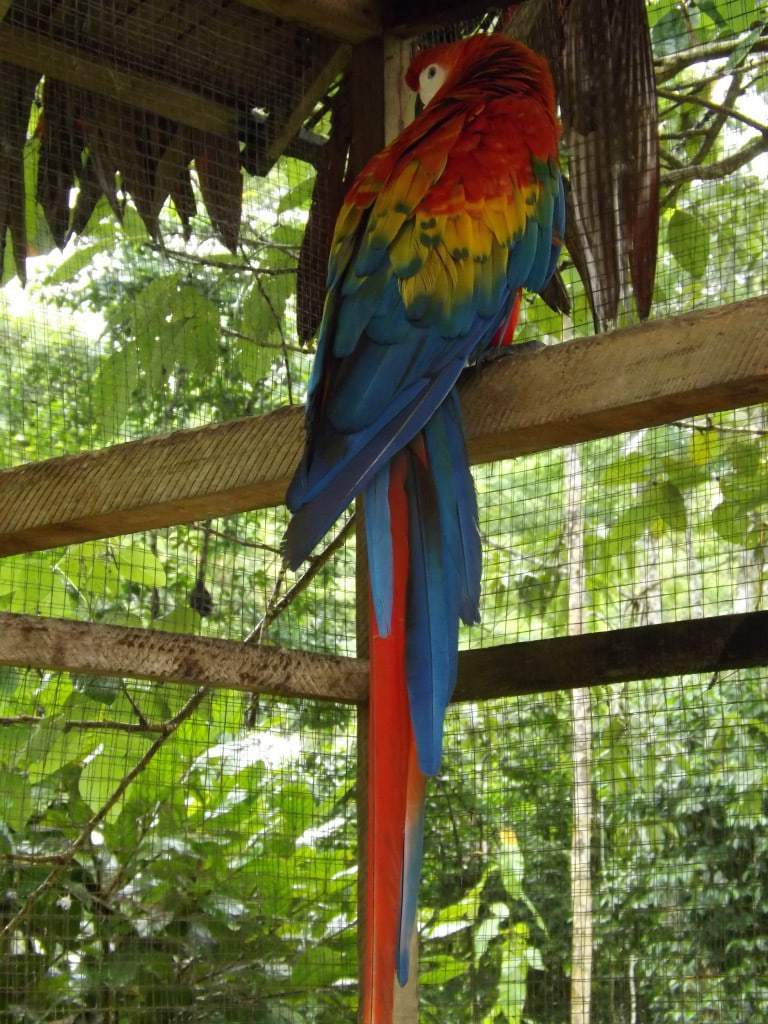
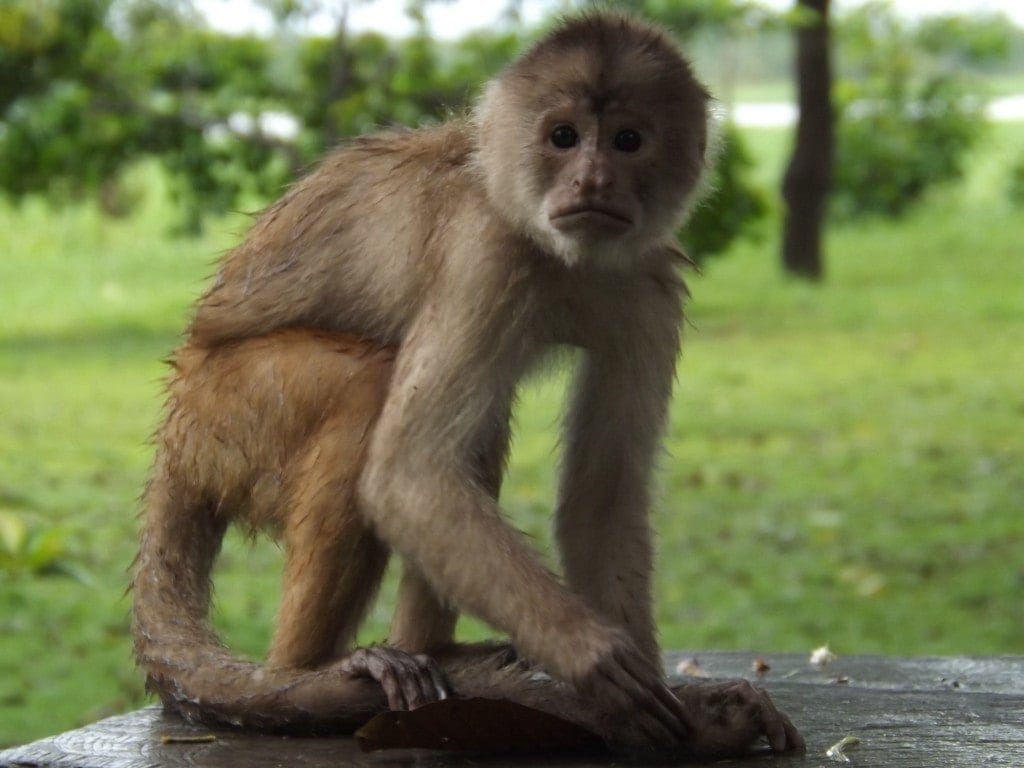
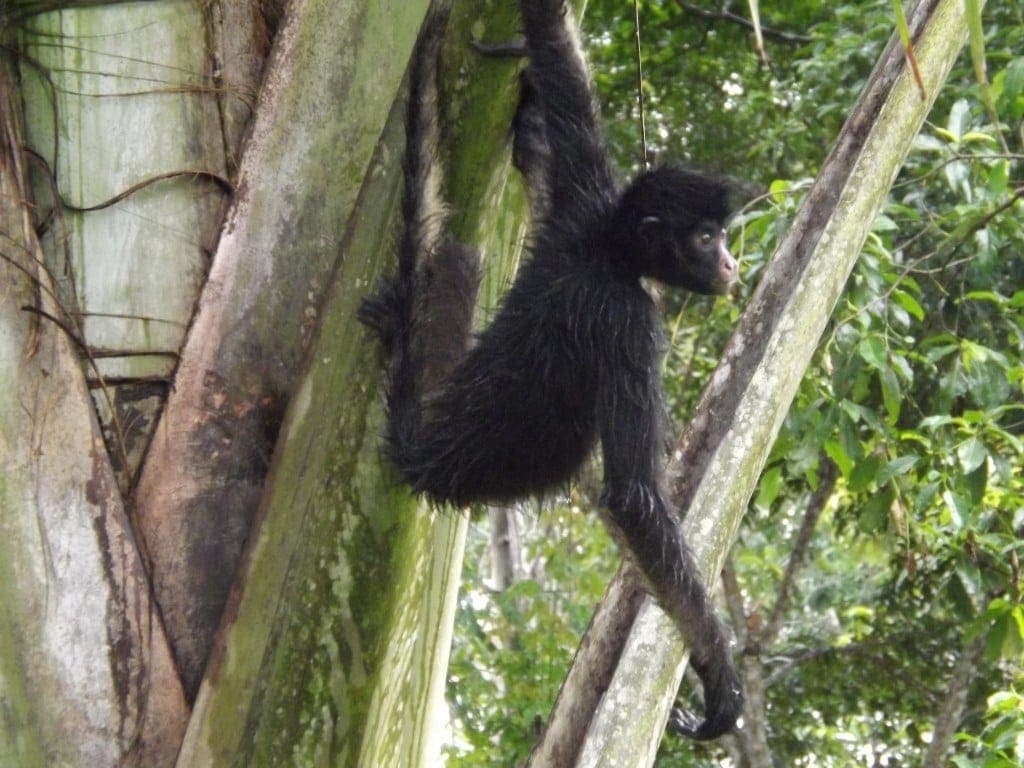
Animal Rescue Centre
It had been raining heavily all morning, a welcome break from the rainforest’s humidity, and unfortunately, it hadn’t ended by the time we reached our first stop; an animal rescue centre on the edge of the Amazon.
Guillermo, the animal carer who runs the shelter, showed us around in the grey drizzle, and at first glimpse we appeared to be standing in an empty, uninteresting clearing. Suddenly, we spotted movement, and at Guillermo’s whistle they came closer: a group of white and brown capuchin monkeys and lanky spider monkeys, swinging playfully from low hanging tree branches and showing off for us.
Proximity to the humans who feed them had made the animals bolder, but by no means tame, and some of the monkeys approached us cautiously, trying to check bags for food, although on the whole they hung back and played in the trees.
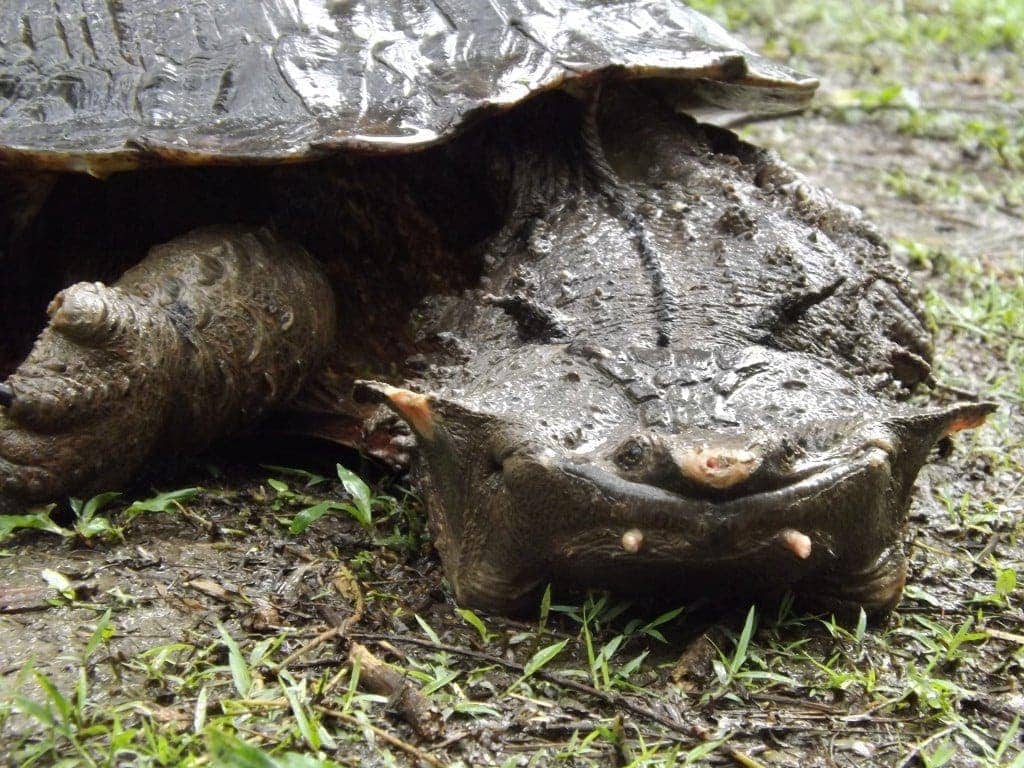
Besides the monkeys, there were colourful parrots who refused to acknowledge us or move into the rain from the shelter of their hut, and an enormous prehistoric turtle, which sat still on the wet ground with what looked like a smile on it’s bizarre, warty face. We were all most excited by Rosita, a baby sloth who happily let all of us hold her, smiling serenely like a stuffed bear in our arms. She looked animatronic, moving slowly and lazily to scratch her head, holding my finger with her three claws in a surprisingly strong grip, but she was adorable and I struggled to hand her back over to Guillermo when the time came to move on.
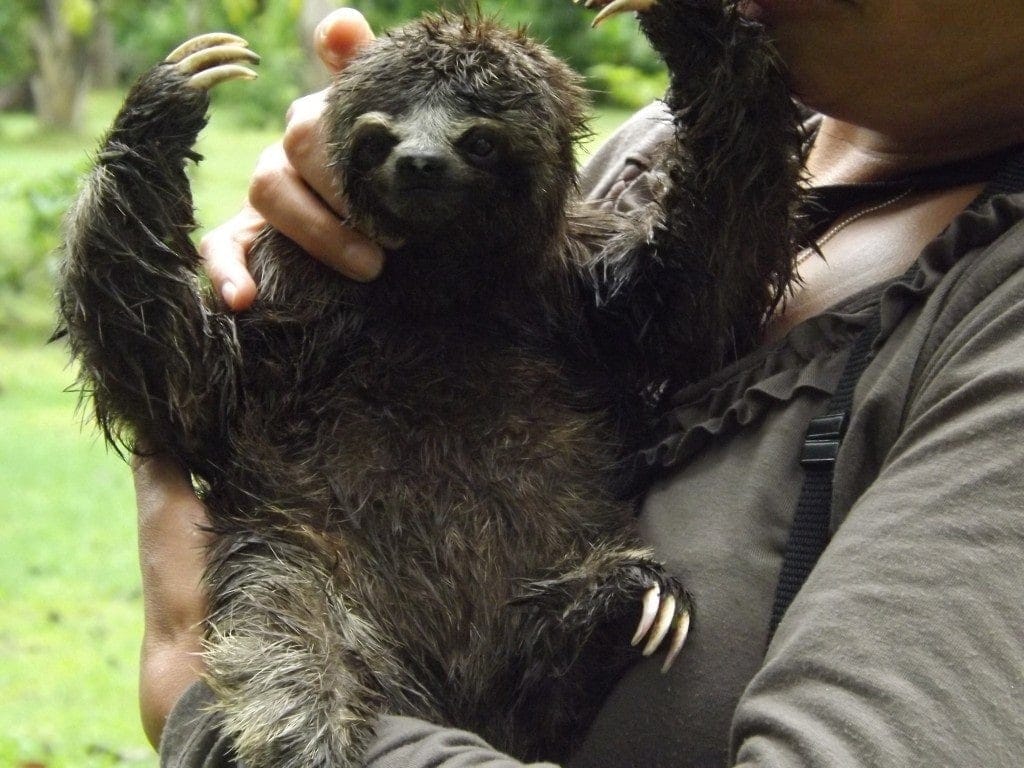
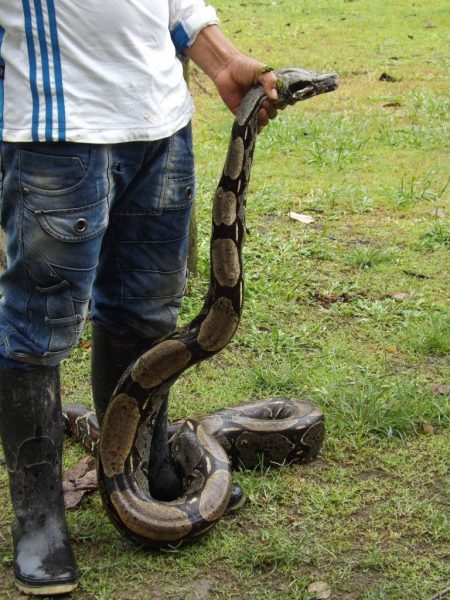
One of the last stops at the rescue centre was beside a big, swamp-like pond of dark water covered in green vegetation. Guillermo stuck an arm into the water and wriggled about a bit while we looked on dubiously, trying to work out what could be in the pond. Another turtle? Fish? Suddenly, with a whirl of impossibly quick movement, Guillermo jerked back, yanking something long and dark and thrashing out of the water. It was a huge anaconda, about two and a half meters long, which sat docilely enough once Guillermo had a strong grip on it’s head, but whose strong body writhed slowly around me when I posed for a photo, so that I could feel the strength and silent power in it’s coils. From the grip Guillermo kept on the snake, I could tell it was dangerous, even though they don’t bite, and as much as I love snakes even I was a little scared by such a huge, powerful serpent.
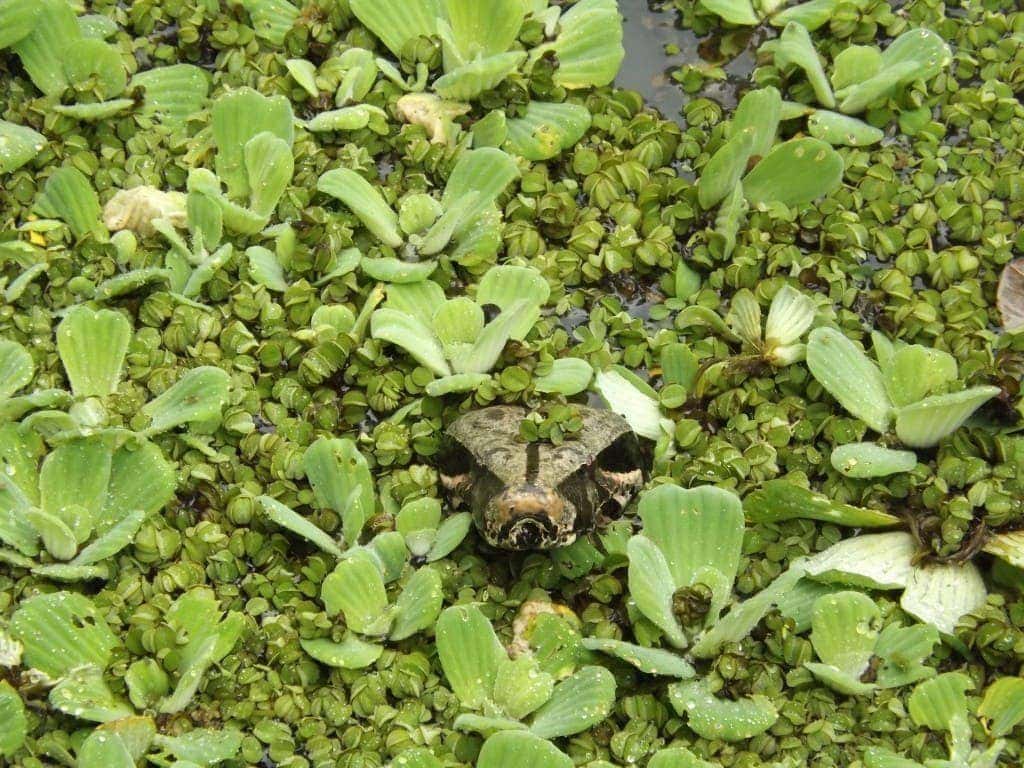
Before leaving, we tried some ‘jungle wine’, a dangerously strong alcohol containing twigs and tree bark which the locals assured us would cure all manor of diseases – they recommended a shot every morning – and watched one of the bolder monkeys steal a piece of fruit and a plastic cup, pretending to drink from it. After a chat with some of the local guys who work at the centre, mainly about the potency of the homemade jungle wine – which we bought a bottle of – it was time to head back to the boat for the next stage of our river tour.
Meeting the Yagua
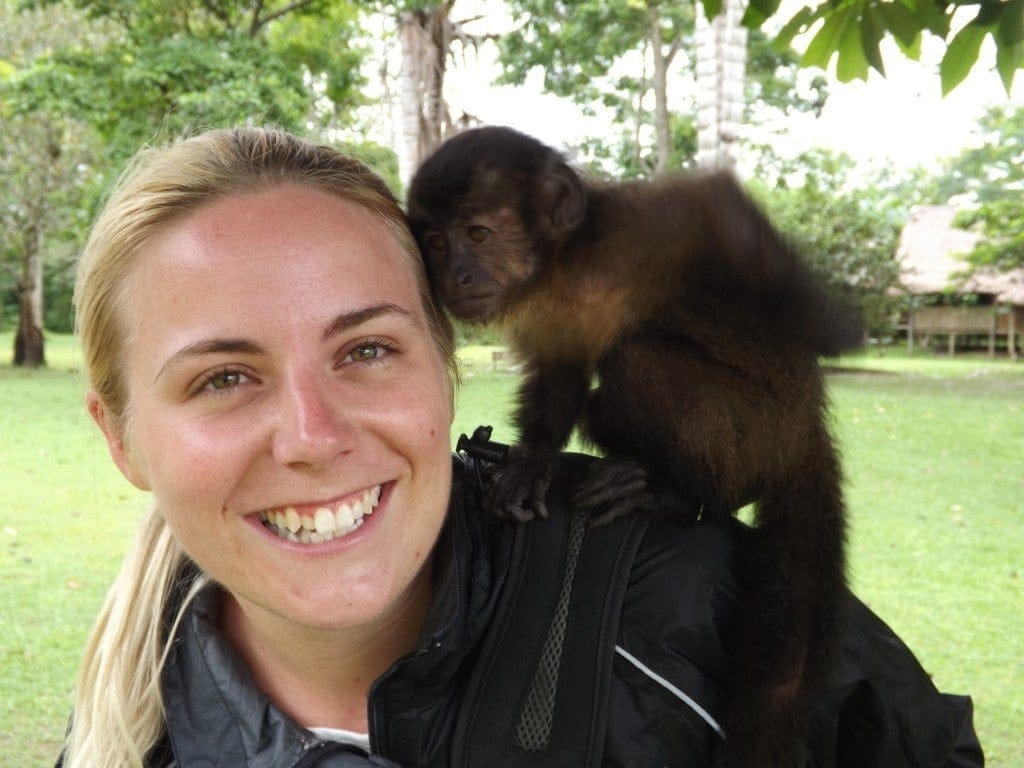
After the amazing animal rescue centre on the edge of the Amazon river, I didn’t think our day tour into the jungle outside Iquitos could get any better. We pulled up next at a small village alongside the river, and walked inland a bit before boarding a motorized canoe. The river here was formed by flooding from the Amazon; Alfredo, our awesome guide, explained that in summer this whole area of forest was dry and you can walk along it to Wimba Lodge – the jungle lodge which the Wimba tour company use as a base – but during winter the river lever rises dramatically and floods the forest.
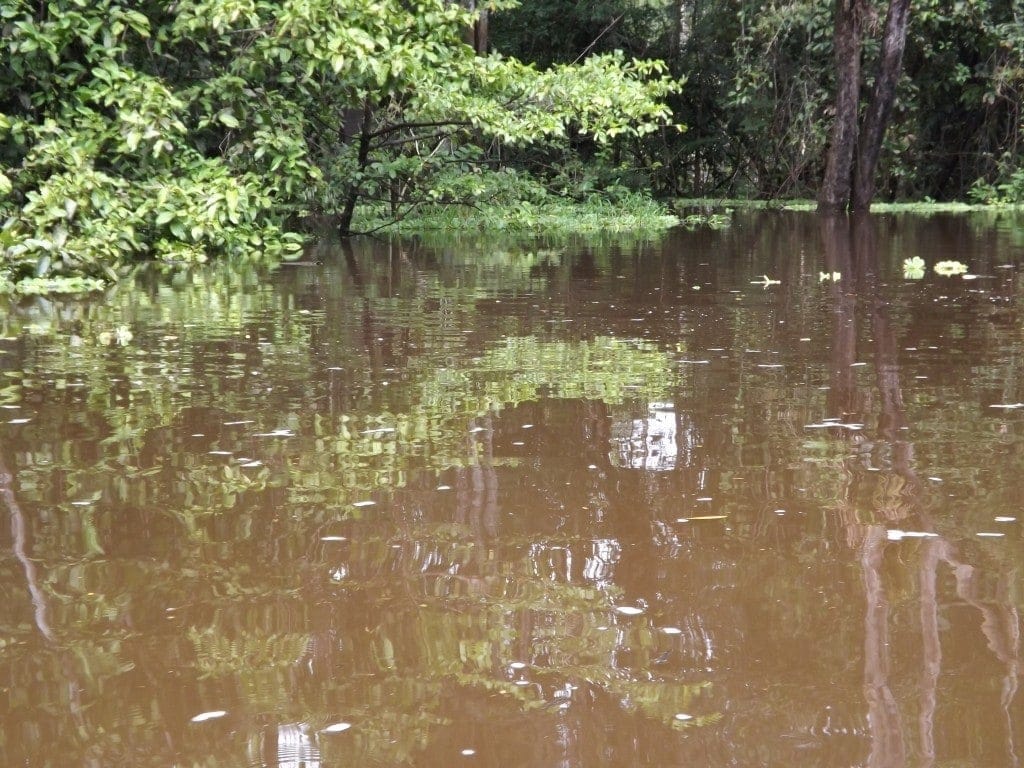
We cruised along the river, the glassy black water perfectly reflecting the trees growing straight out of it. Besides the birds and the sound of the oars, there was total silence, apart from occasional splashes as fruit fell from the branches overhead into the still water. Alfredo told us that in places it could be twenty foot deep, or more, and with the thought of fish swimming past forest trees the silent, calm water below us seemed filled with mystery.
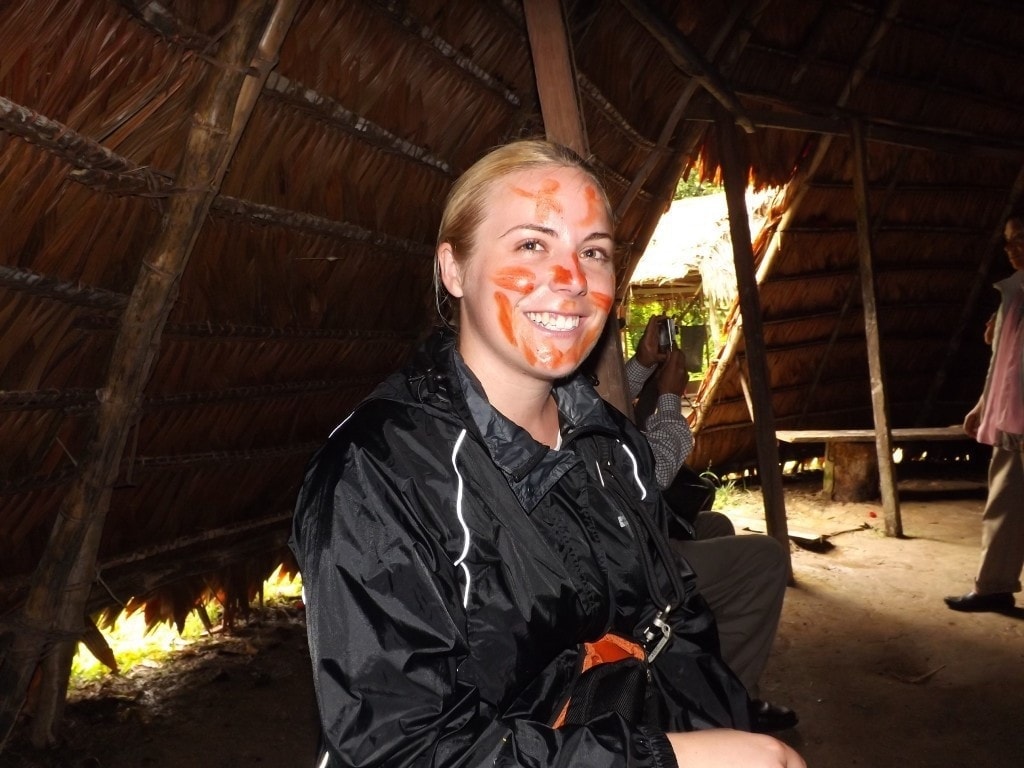
As we pulled up at a muddy bank, Alfredo began calling out towards a damp clearing, a strange word I didn’t recognise. From somewhere beyond the trees came an answer, and as we clambered up the slope a small group of wooden huts, thatched with palm fronds, came into view.
The clearing and huts, coated in drizzle under a grey sky, seemed deserted, so it was Alfredo who introduced us to the village of the Yaguas – the native tribe of the area. Inside the largest hut – a huge cone-shaped thing with a high ceiling used for meetings, rituals and ceremonies – we were introduced to the chief, his gut hanging over his grass skirt, his weathered face smiling.
The chief, who didn’t speak a word of Spanish or English, painted our faces with a bright red dye in swirling patterns which indicated if the person was single, married, or looking. The Yaguas seem to disagree with the idea of dating before marriage, so Sam and I were given the symbols for a married couple to avoid confusion.
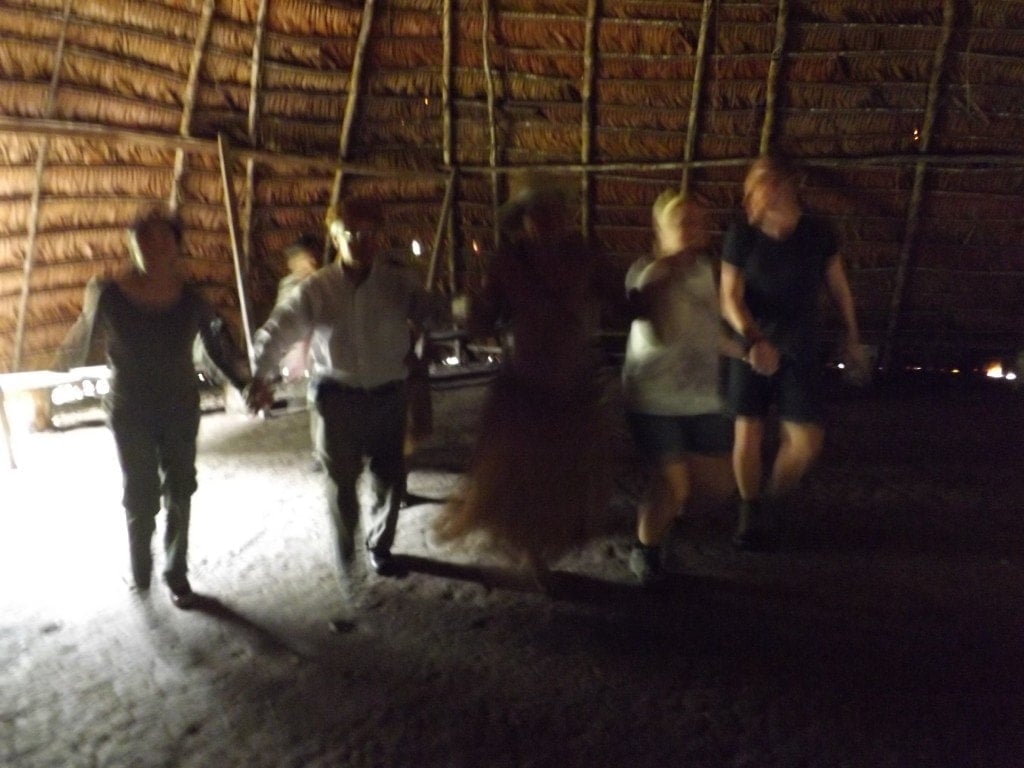
Whilst we were being painted, another tribe member shuffled in; ancient, wrinkled, and clearly very out of it, the village’s shaman looked a lot like someone who has taken a few too many hallucinogenic drugs in his time. Anything between 80 and 200 years old, the shaman barely looked at us, flinched away from the chief when he tried to paint his face, and didn’t seem to know what was going on. Even so, he played some traditional music for us while we danced with the chief: a halting, galloping march in a line holding hands round and round the hut.

It was a bizarre experience, but very fun, and it quickly got stranger as we were led outside for a demonstration in the tribe’s traditional hunting method, the blow dart gun. The chief produced an enormously long pipe, which he used to blow spindly wooden darts across the clearing into a wooden sculpture of a man; first hitting him between the eyes, then in the throat, and finally right on the end of the unfortunate guys’s exaggerated genitalia.
After the chief’s impressive performance, we all had a go, and discovered that it is so much harder than it looks. It took me three tries to even blow the dart out of the end of the gun, but when I finally managed I did get the wooden guy right in the throat, so I was pretty proud of myself!
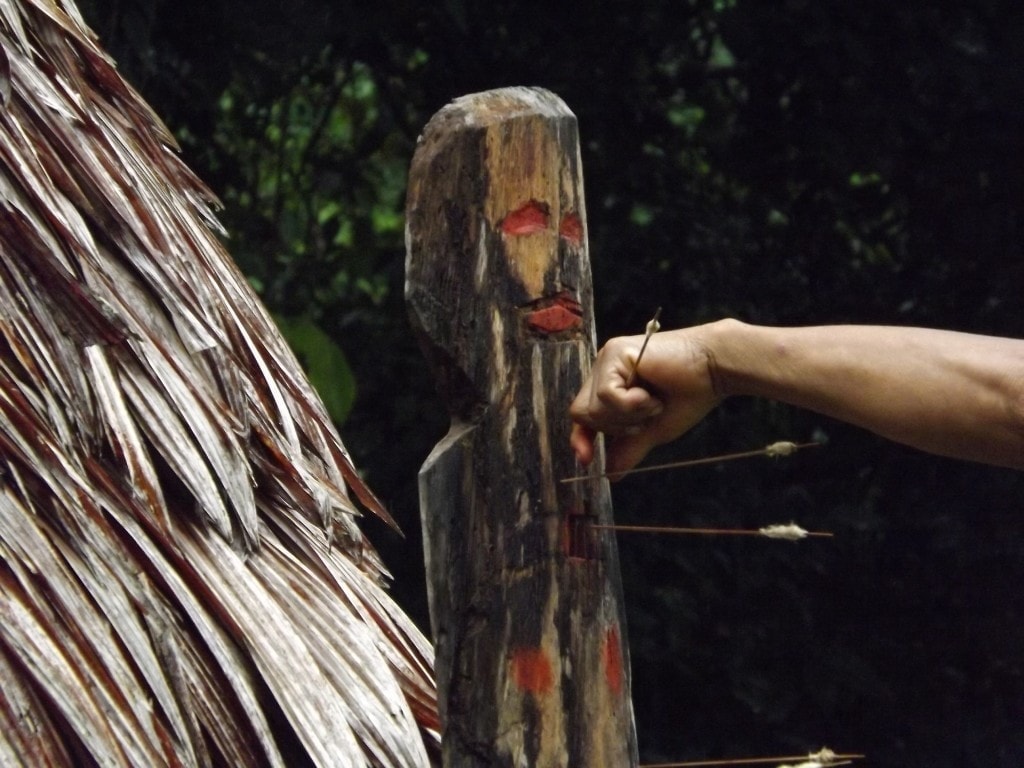
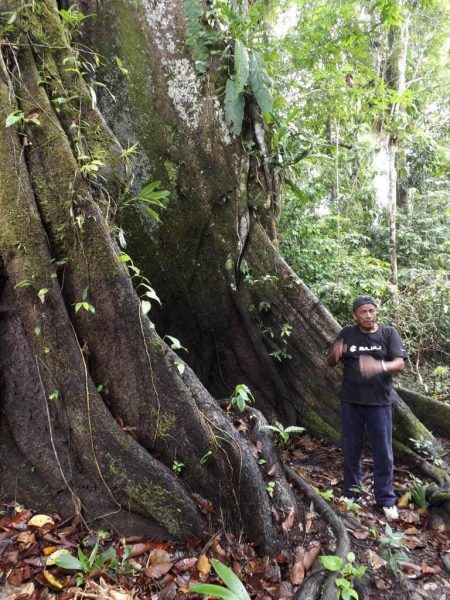
Piranha Fishing
We left the Yaguas and headed to Wimba Lodge, a beautiful wooden lodge in the heart of the jungle, for a delicious lunch of fried dorado (golden catfish) with rice.
After lunch, we got into another canoe – this time with no motor- and paddled down the river into the forest. We stopped briefly to check out a wimba tree on the shore, an enormous tree about ten foot wide and goodness knows how tall (Alfredo did tell us, but unfortunately he told us so much that day, that I’ve only retained a tiny portion of it). The last part of the day’s schedule was a spot of piranha fishing from the canoe, but sadly we’d run quite late so we only had about ten minutes or so, and none of us caught anything. It was still really cool to sit in the silence of the river-forest, surrounded by black water with no idea what was lurking amongst the trees beneath the surface.
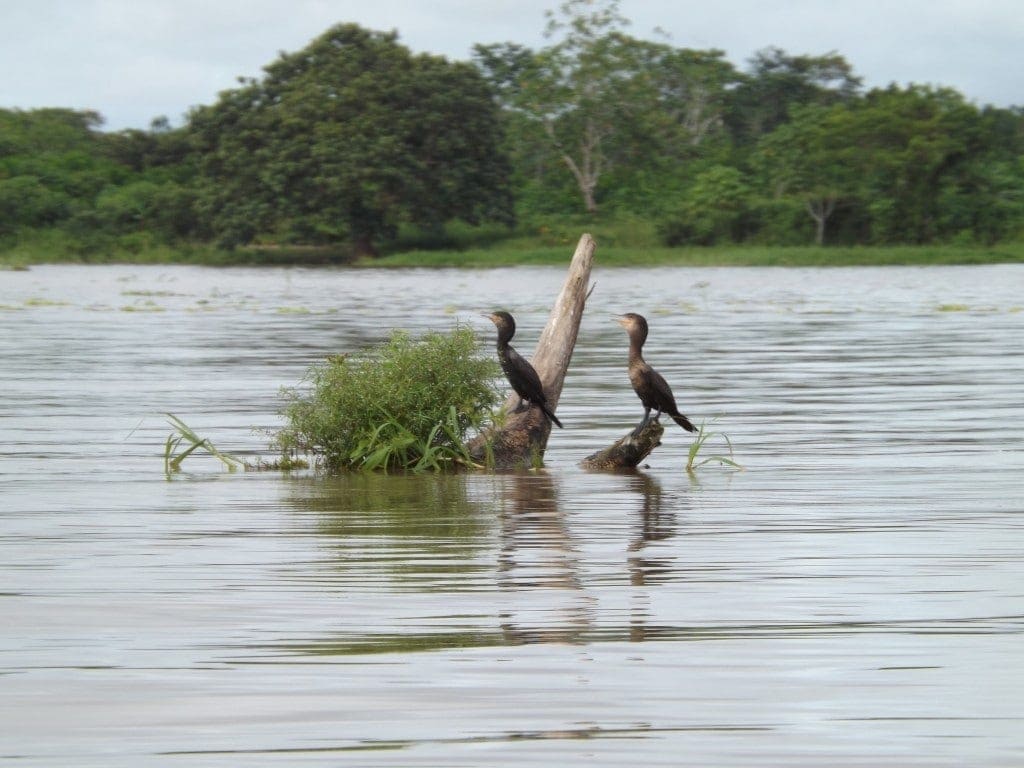
The journey back upriver to Iquitos took almost two hours, but by this time the sun had come out and we were blessed with an impossibly beautiful blue sky lined with sculpted clouds that reflected on the Amazon’s surface. We glimpsed a few river dolphins, and along the bank I caught sight of a flash of dark movement which the guides said was a catfish.
It was a fantastic day, filled with wildlife and beauty, which gave us the tiniest glimpse of the powerful, mysterious Amazon. Wimba were a great tour company; friendly, reasonably priced and helpful – plus Alfredo was a brilliant guide – and I’m happy to recommend them for anyone heading to Iquitos.
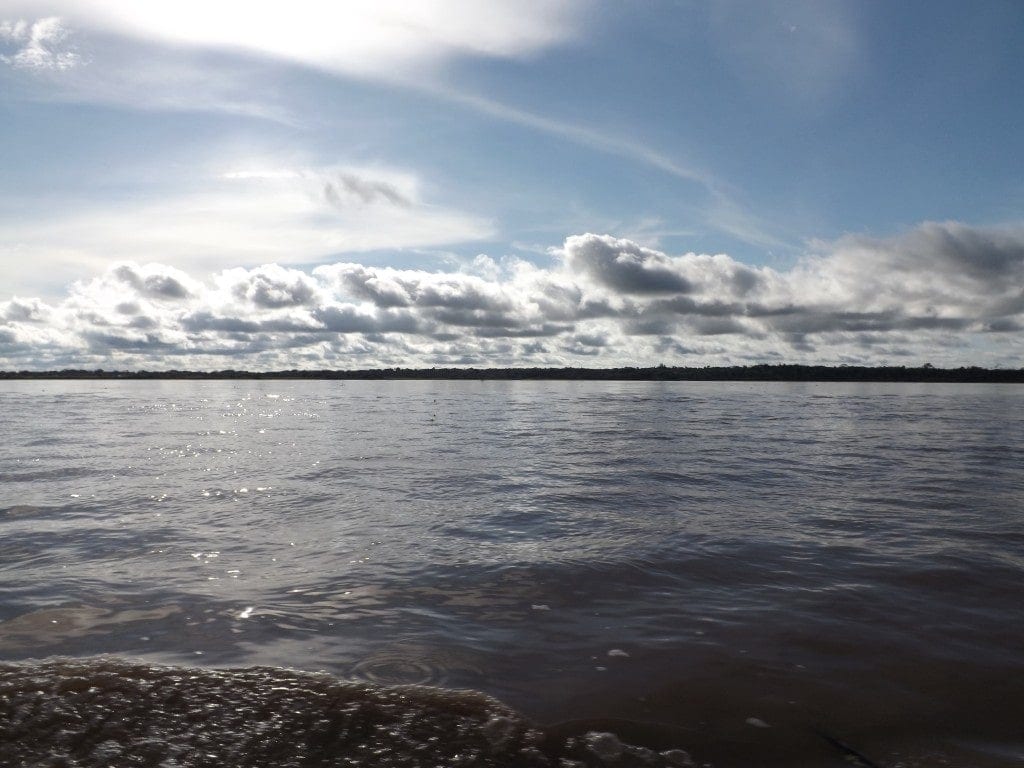
Reaching the North Coast: Chiclayo
22nd March 2014
After days in the intense green jungle of Peru’s Amazon, waking up to the north coast was something of a shock.
The town of Chiclayo in the north of Peru is in an arid area of barren desert and sparse, struggling sugar plantations, and everything is dry, dusty, beige, brown; a sharp contrast to the hot, wet, lush greens of the rainforest and the emerald mountains of the Amazon Basin we’d just left.
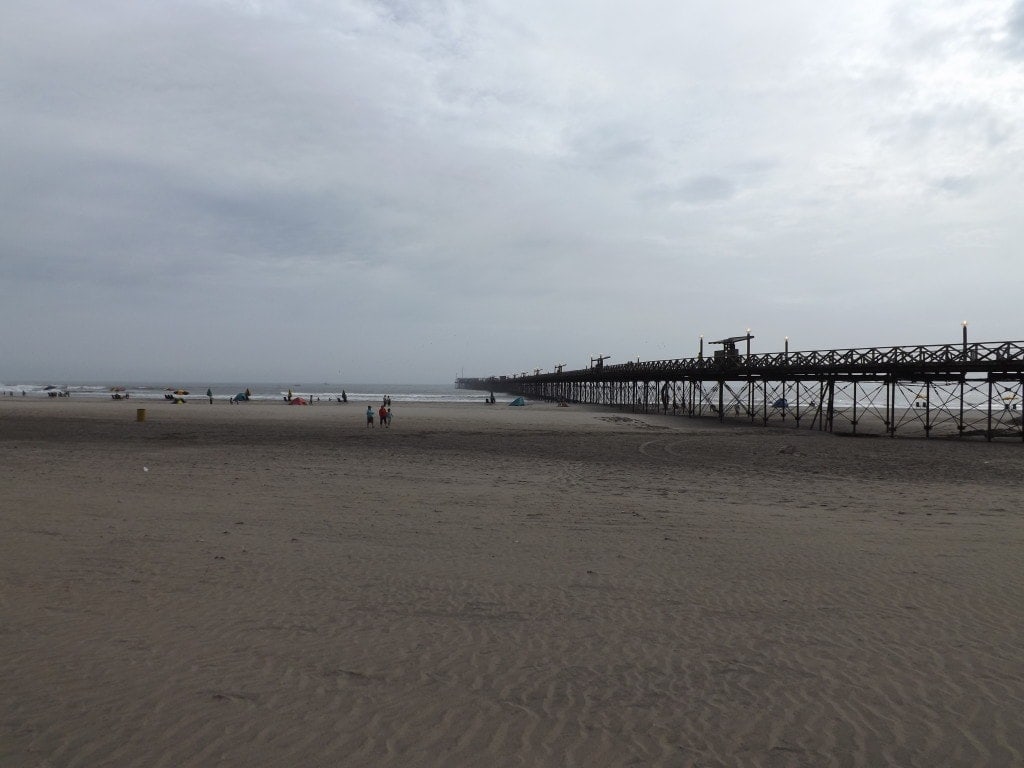
The night bus from Moyobamba, winding through sharply cornered mountain roads, had been an unpleasant experience, so we spent most of our first morning in Chiclayo in bed.
Once again, we found ourselves in another “less travelled” town with no hostels and seemingly no other travellers, so we were staying in a cheap private room in a small hotel near the city centre. Once we were feeling more alive, we headed out into the city to explore.
Although it’s slightly off the beaten path, Chiclayo is actually pretty cool and we found a few places to explore. Our experience of the town would have been a lot more enjoyable if we had been able to share it with some other travellers, but although it wasn’t the most fun-packed destination there were a few interesting sights.
We started with the Mercado Morado, a sprawling market not far from our hotel which appeared to be selling everything. The market takes up about one block, and has corners for everything from fresh meat and veg, to clothes, cleaning products, knock-off designer goods, and pirate DVDs.
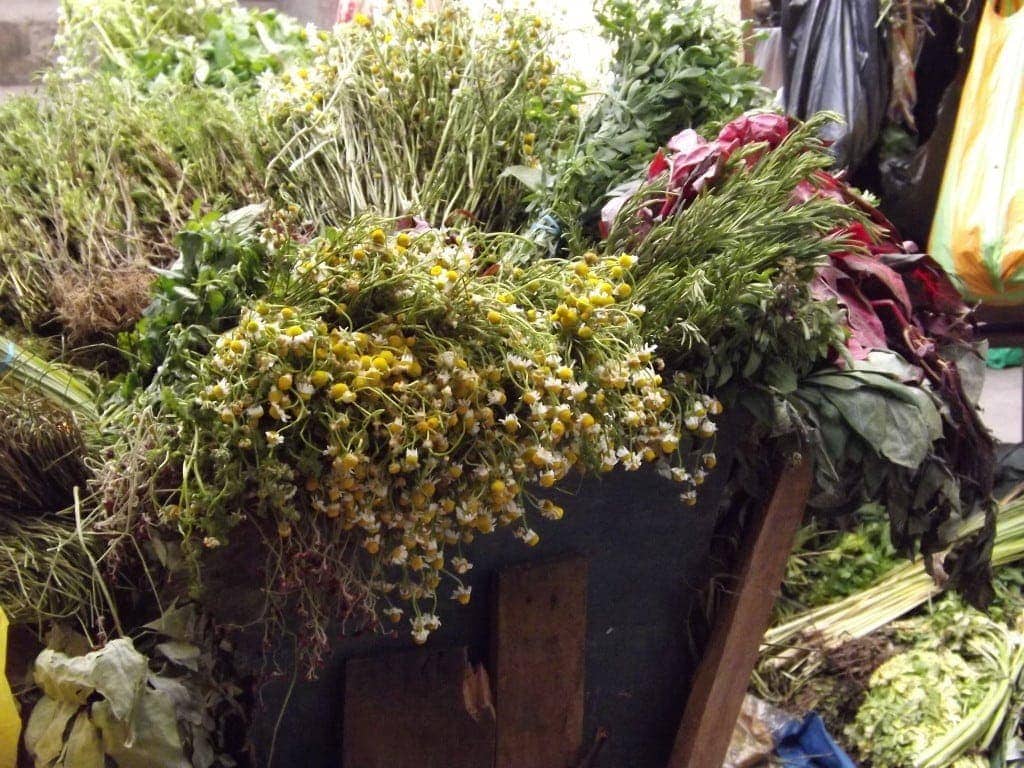
On the whole, it’s a pretty ordinary market, but the interest lies in the Mercado de Brujas or ‘Witch Doctor’s Market’; a section of narrow paths between stalls laden with an eclectic mix of traditional medicines, artefacts and spells from dozens of different cultures and religions.
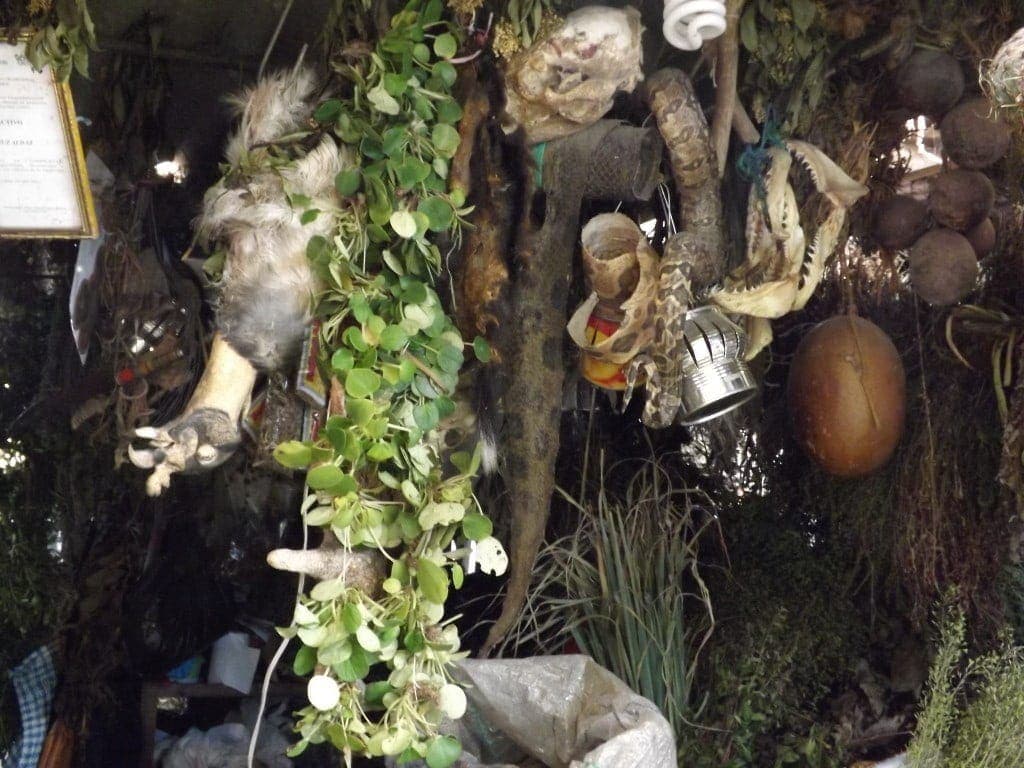
Dried herbs, Chinese waving cats, crucifixes and other Christian icons, snake skins, bones, furs, voodoo dolls, herbal teas, shrunken heads, beads, bronze frog ornaments, teeth, quartz, crystals, amulets filled with bark and seeds, and – on every stall – numerous packages advertising libido boosts and “good sex”.
It was a very bizarre experience: a little intimidating being excessively stared at as we wandered through the market, pretty strange watching a seemingly ordinary middle-aged woman buy a voodoo doll, and very overwhelming to be offered something by every shopkeeper we passed; everything from spells for safe travels to cannabis and cocaine.
From the market, we hopped in a taxi to the nearest beach – Pimentel, about twenty minute’s drive from the centre of town. Although we were still pretty close to the equator, strong winds from the Pacific meant that it was a little too chilly for swimming, but I dipped my toes in anyway. It was actually my first ever experience of the Pacific ocean, and although I joked to Sam about writing it into a poetically profound experience, I can’t say it was any different from any other ocean I’ve been in! Pimentel isn’t a particularly pretty beach, but it’s clean and has a nice, antique wooden pier which has recently been restored. We took a walk along it, watching fishermen in traditional caballitos – reed canoes – being stalked by huge, baggy-beaked pelicans, and laughing at a group of local boys leaping off the end of the pier into the freezing water about two storeys below.
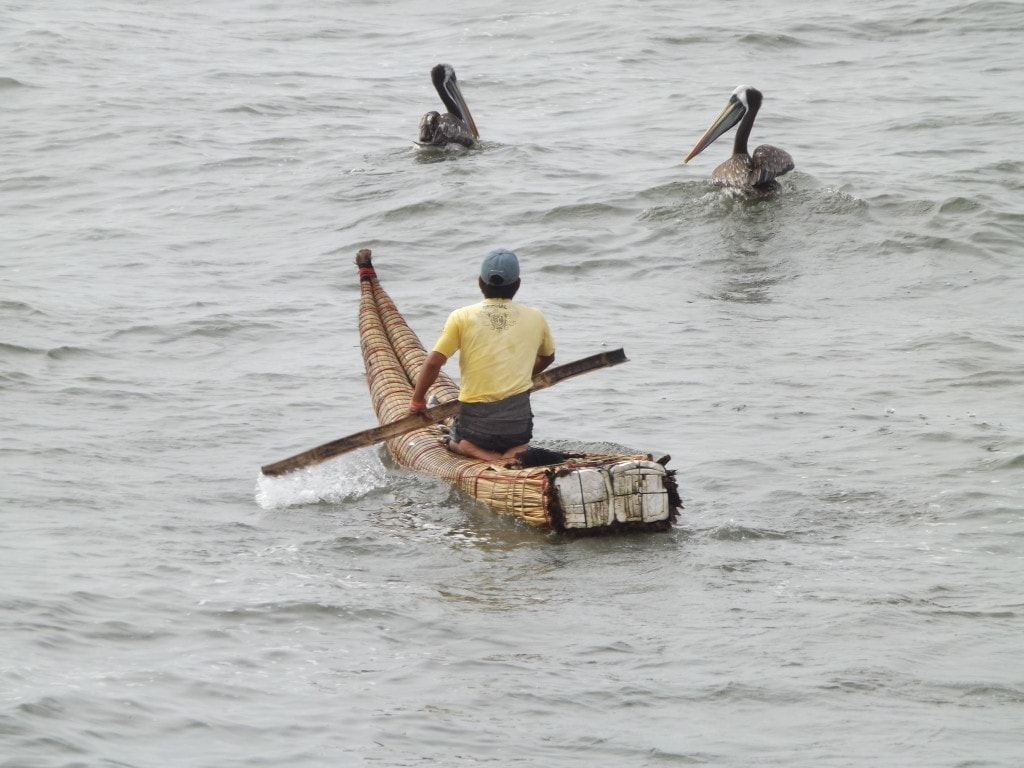
Although it felt good to be out of the jungle, we were still experiencing the bizarre seclusion that comes from not meeting any other travellers, so neither of us felt particularly taken with Chiclayo.
Still, it was an interesting city with a strong sense of past lurking in its creepy Witch Doctor’s market, the fishing canoes that have stayed the same for hundreds of years, and the many pre-inca ruins in the surrounding area which seem to have deeply infiltrated the culture of Chiclayo, so we decided to stay one more day to explore those sights and learn a little bit more about the area’s history.
Sipan Tombs and Tucume at Chiclayo
23rd March 2014
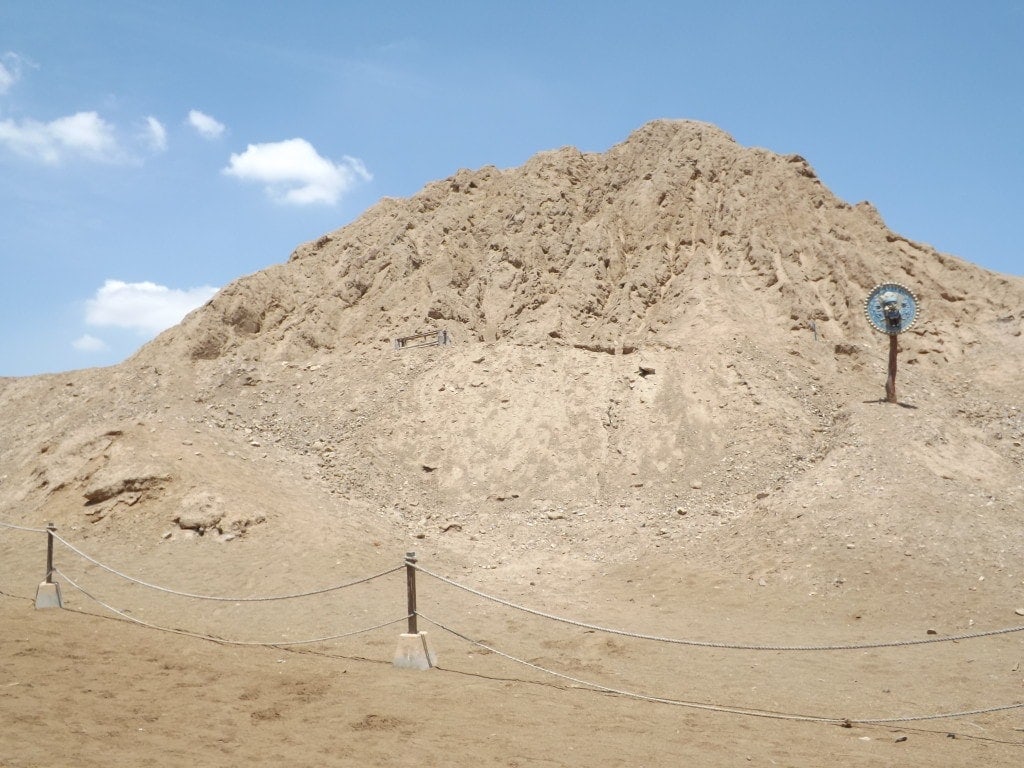
Our second day in Chiclayo was spent seeing the two sights that most people come to this dusty coastal town for – the tombs of Lord Sipan, and the ruined city of Tucume.
Learning from our mistake in Tarapoto, we decided not to try to get to these sights ourselves, and instead booked a reasonably priced day tour with Moche Tours (S./50 or about £10 each).
Stupidly, though, we decided not to pay the extra S./30 (about £6) for an English guide (I’m not really sure what the thought process was there) so found ourselves in a big group of Peruvian tourists led by a pretty fast speaking Spanish guide. My understanding of Spanish is ok – much better than my speaking – but I still only grasped about 30% of the information – and was only able to pass on a fraction of that to Sam in a muted whisper.
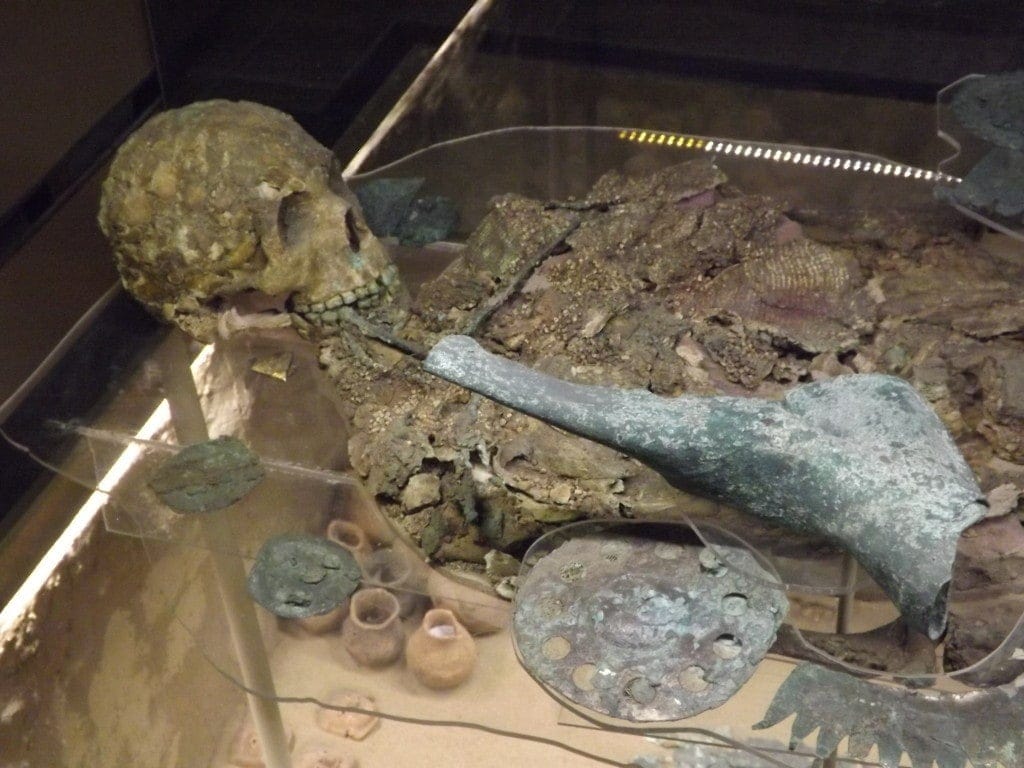
Still, the tour was very thorough and worth it, despite not understanding most of it! We drove first to the site museum at the Sipan Tombs; a small, dark museum where all the information is written in Spanish.
Most of the artefacts here are replicas of the originals found at the archaeological site, although there are a few originals, including a couple of skeletons laid out as they were found – surrounded by copper armour, gold ornaments, clay pots, and the skeletons of unfortunate lamas, women and children which were sacrificed alongside the buried lords and warriors.
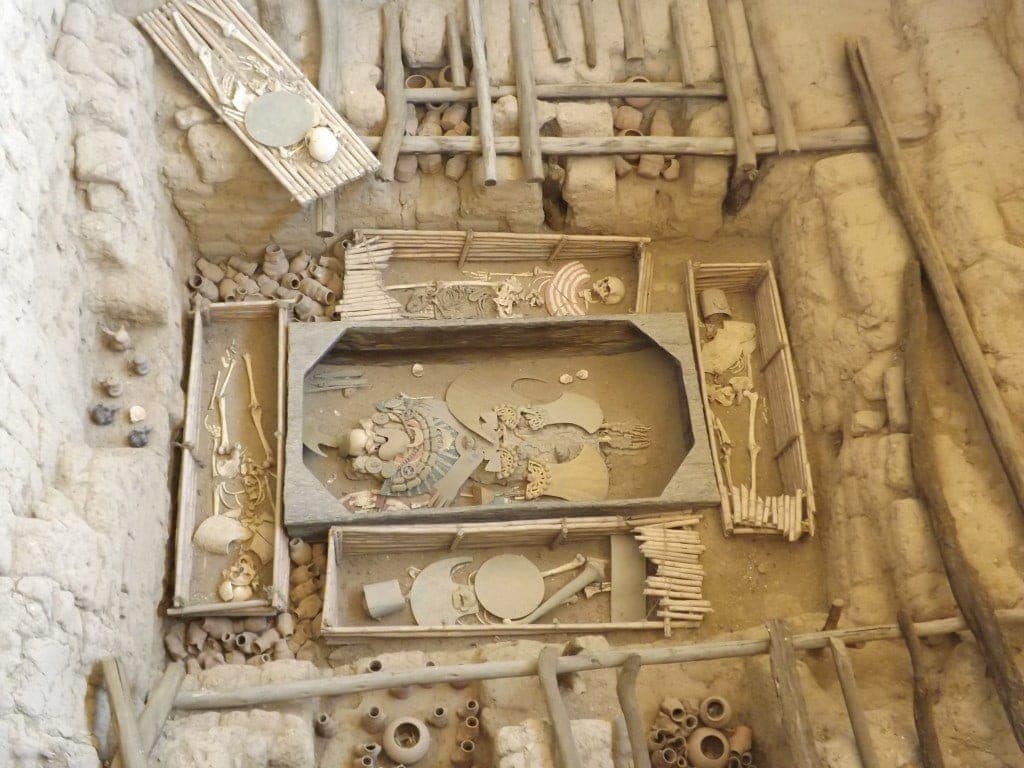
After the museum, we headed out into the baking desert sun to the archaeological site itself. This is a big, dusty plane where the air is parched and hot and where I felt my skin burning after a few seconds of exposure.
Fortunately, the dig site was covered with a tin roof, so we hurried into the shade to look at the excavated tombs. The Sipan site, which dates from the time of the Moche people around 100 AD, is pretty interesting; fourteen tombs of adobe construction forming a pyramid shape, with the tomb of El Senor de Sipan at the top – where he was buried with his 40 wives and concubines, two guards, and a favoured warrior.
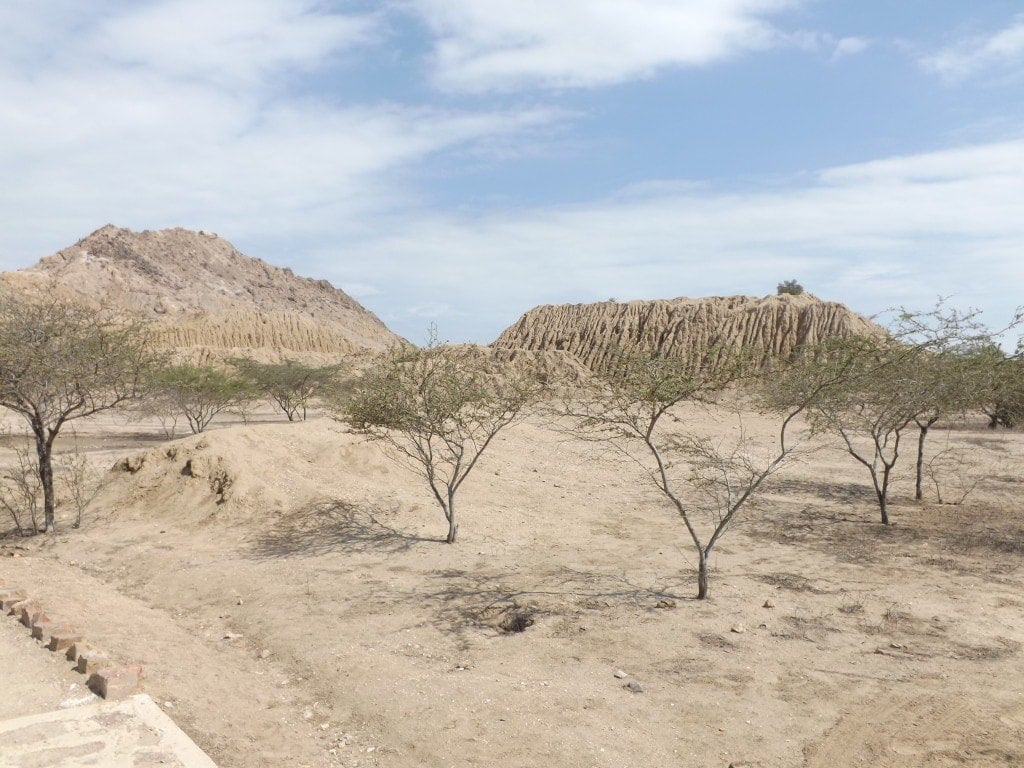
From Sipan we ventured to Lambeyaque for a lunch of the area’s traditional dish, Arroz con Pato (duck with rice), before heading out to the ruined city of Tucume.
Another Moche site, this city later formed an important centre, possibly capital, of the successive occupations of the area by the Lambayeque/Sican (800-1350 AD), Chimú (1350–1450 AD) and Inca (1450–1532 AD) peoples.
The site is another barren, dry landscape, this time composed of twenty-six pyramids of brown earth, so covered by sand and time that they are more like mounds or small hills. We climbed halfway up the huge hill at the centre of the site for a view across the pyramids, but the heat was so intense and the dry plane was completely without shade, so it wasn’t a fully enjoyable experience.

After the baking heat, the last stop at the cool, air-conditioned Tumbas Museum in Lambeyaque was very welcome! This is considered the best museum of the area, with the largest collection of original Moche tools, clay pots, and ornaments from the Sipan dig site. The museum is set over three floors, and since all the artefacts inside are originals and need protecting, Tumbas is kept pretty dark and we weren’t allowed to take our cameras in, in case we disobeyed the ‘no flash’ rules.
This was a really interesting final stop, with loads of beautiful artefacts – some well preserved and others painstakingly restored – including hundreds of clay pots carved into figures or animals, many of which give a good idea of what the Moche culture was like – from fishing and agriculture to their beliefs about birth and death. There were also lots of beautiful copper and turquoise ornaments and jewellery, like big plate-shaped earrings or mouthpieces bedecked with dangling pieces of copper, which were used to distort the chief’s voice so that he sounded like a true ‘speaker for the gods’.
Thanks to all the heat and walking, though, we were both exhausted and had to sneak off to find a quiet bench, skipping the end of the Spanish tour we couldn’t understand. All the exhibits had translations in Spanish, meaning we left this museum with the most understanding about what we were looking at, which made up for not understanding most of the day. In spite of a lot of the information being lost in translation, and a little too much heat, it was a really interesting day and a great introduction to one of Peru’s earlier cultures.
Chan Chan, Trujillo
25th March 2014
Chan Chan in Trujillo was one of my favourite discoveries in Peru. Unfortunately, half the post was accidentally deleted at some point. So this is what I managed to recover…
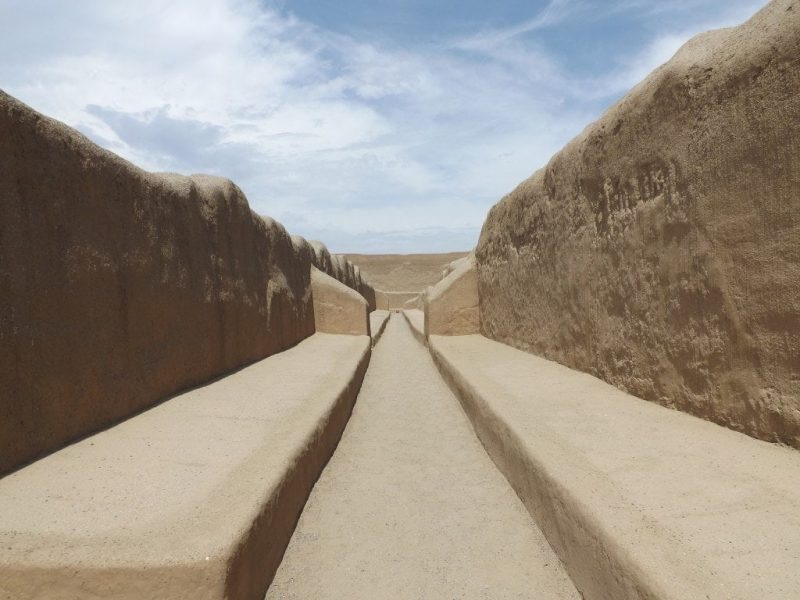
We had a small mishap at the entrance, when the guard noticed that the tickets we’d been sold back at the Huaca del Dragon had been stamped with yesterday’s date by accident, but eventually he let us in, and we found ourselves in a huge, relatively quiet building of high, sandy clay walls.
The first room is an enormous courtyard, with crisp, even walls decorated with lines and a repeated pattern along the bottom of animals that looked like birds with big tails, while at the opposite side of the courtyard was a wide door flanked by two statues.
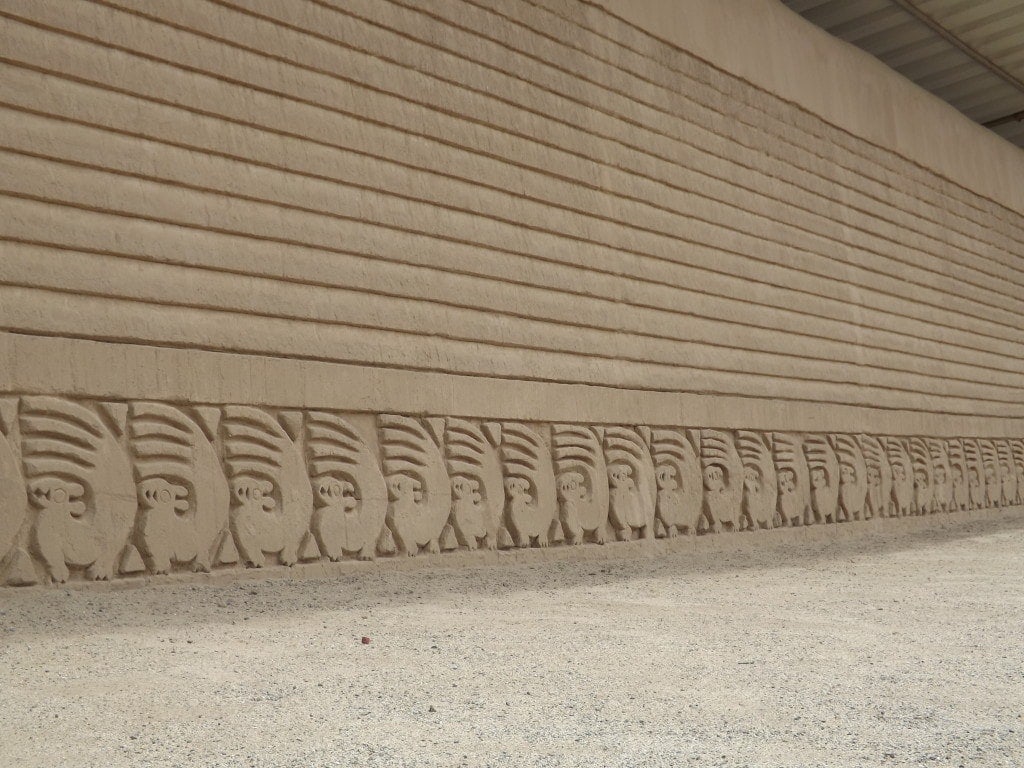
We wandered through the palace, down long corridors between thick adobe walls, always covered with beautiful carvings of fish, birds, or human figures, as well as geometric patterns and shapes. The restoration work is still ongoing, and we spied a few archaeologists working on a wall behind the open section of the palace.
One girl we met actually said that one of the archaeologists, proud of his work and deciding that as an architect she must have an interest in such things, had shown her round the whole palace, taking her into sections where work was not yet completed to show her the restorations, which sounded really interesting. Not being young single girls, Sam and I didn’t get such treatment, but what we saw of the palace was still really interesting.
Towards the back of the structure, we discovered a large area with a swampy, reed-filled lake surrounded by grass and plants, which was built into the palace itself and is surrounded by the same thick adobe walls that make up Chan Chan. The contrast of this bizarre green space with the dry, beige walls and earth surrounding was really strange, and this was one of the more interesting parts of the city.
Chan Chan Photos
The ruins at Chan Chan were really impressive, and brought to life a rich and interesting section of Peru’s history, so I was pleased that we had discovered them on our tour of Peru’s coast. After the sandy mounds and crumbling tombs at Tucume and Sipan, I had not expected to find such well preserved carvings and murals, so I was absolutely blown away by what we found at Chan Chan.
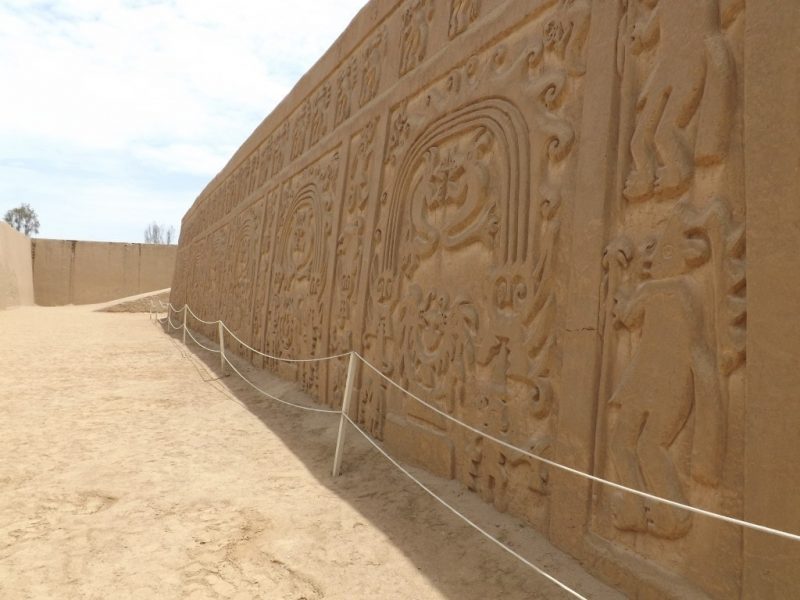
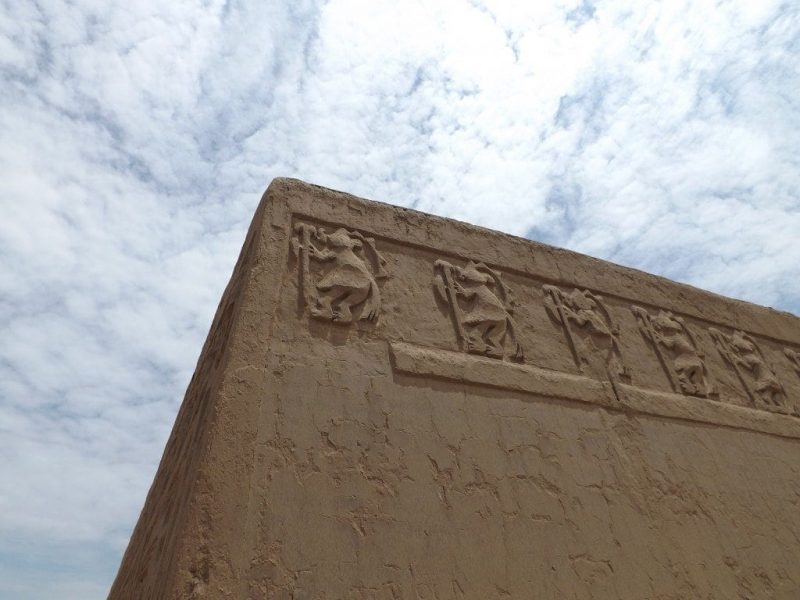
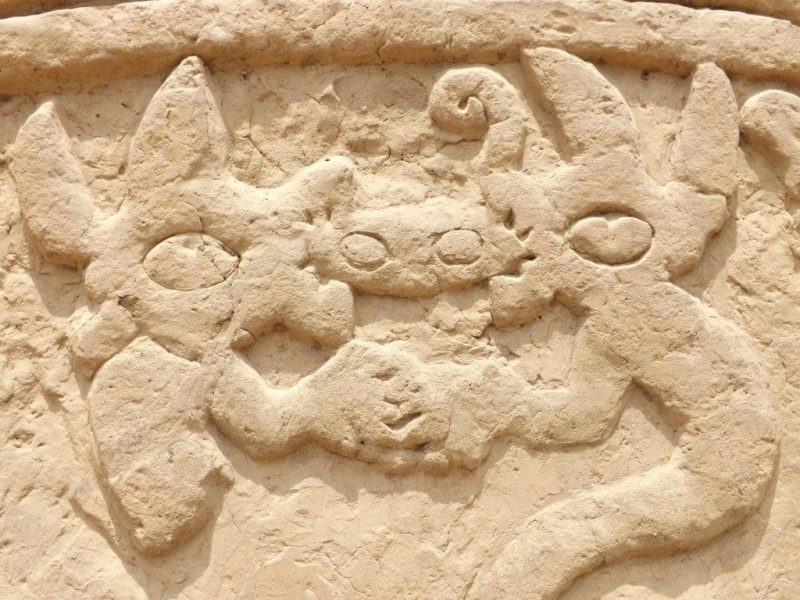
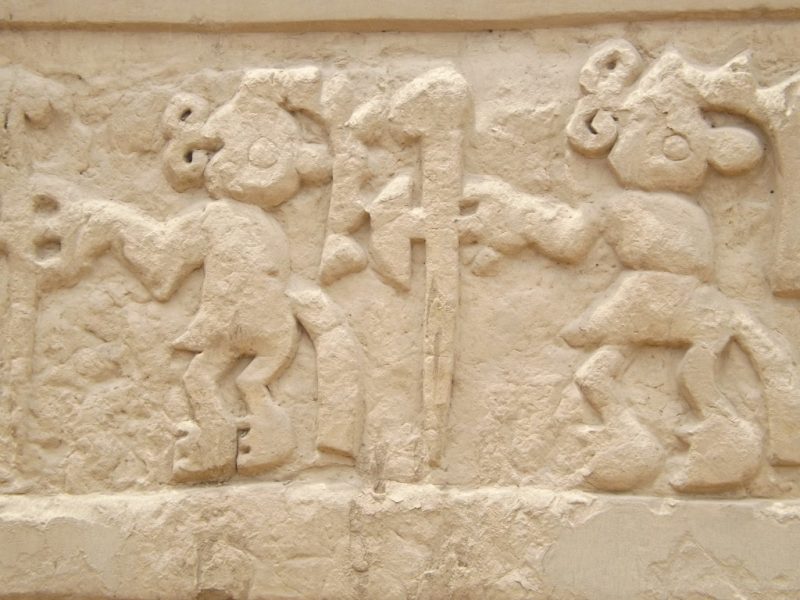
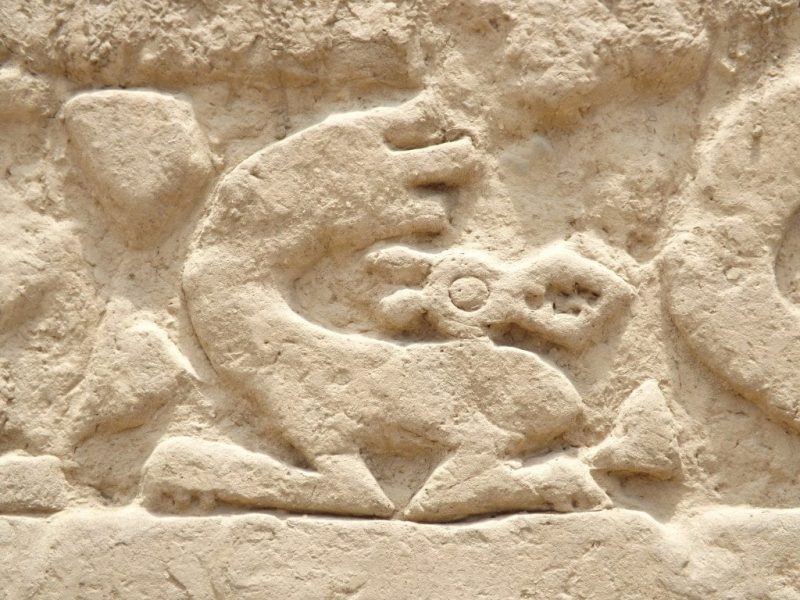
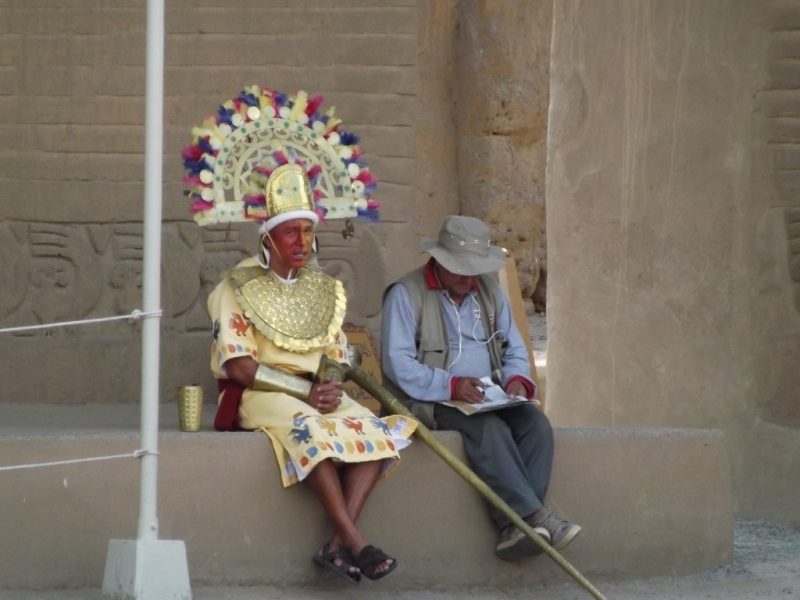
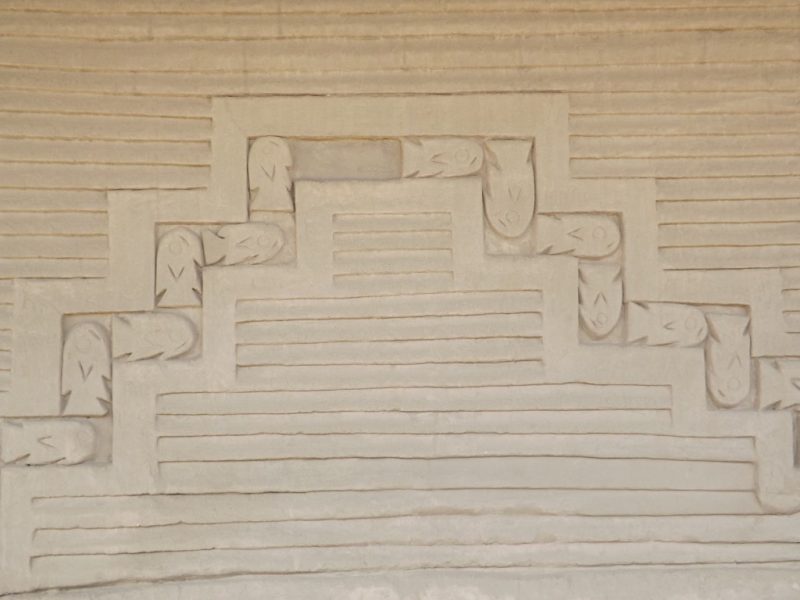
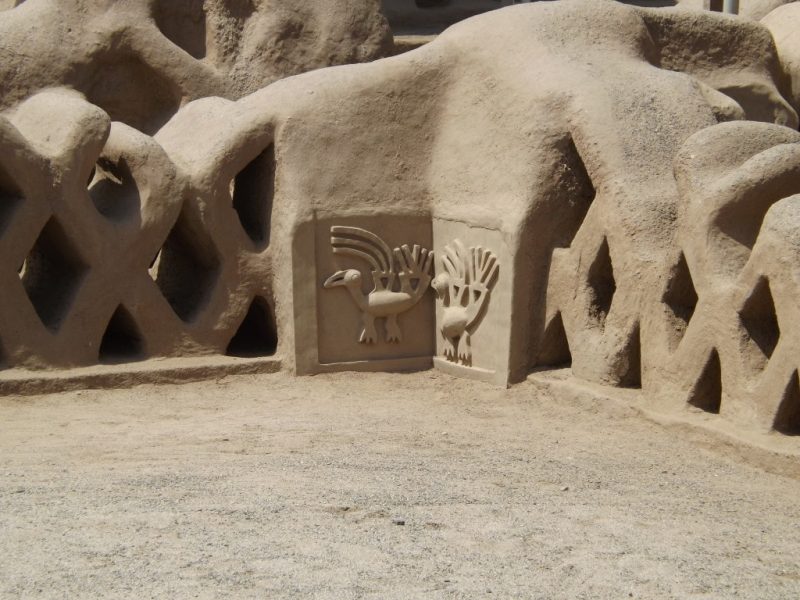

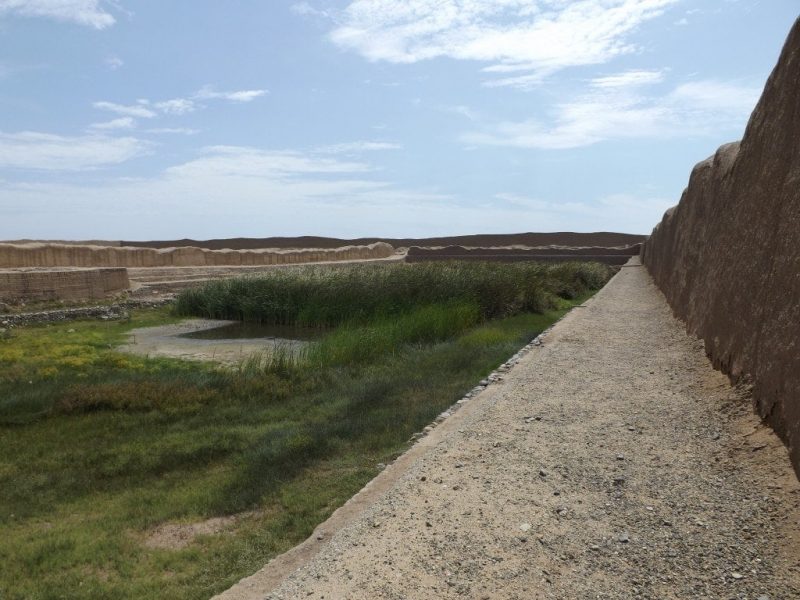
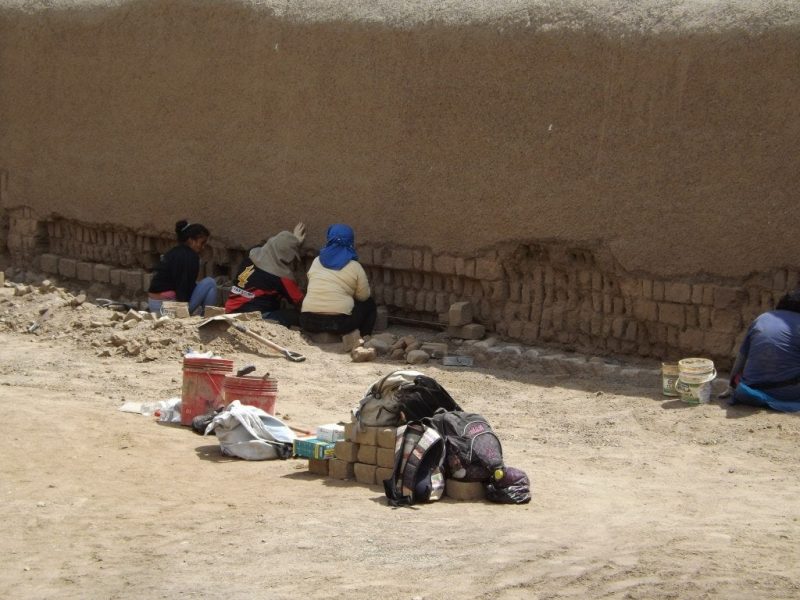
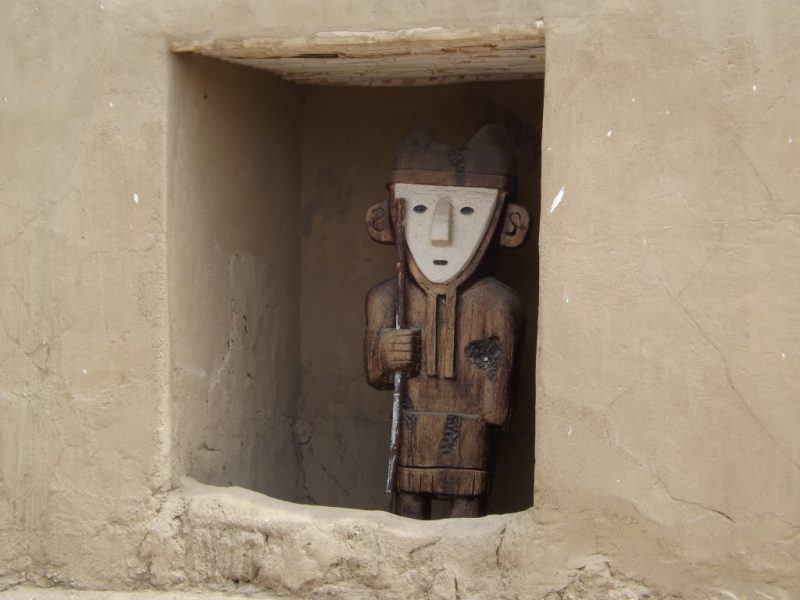
Huacas del Sol y de la Luna, Trujillo
26th March 2014
Trujillo, a bright a modern city on Peru’s north coast, is famous for ruins. Not only is the impressive adobe city of Chan Chan situated alongside the city, but on the other side can be found Las Huacas del Sol y de la Luna, two huge and fantastically preserved Moche temples.
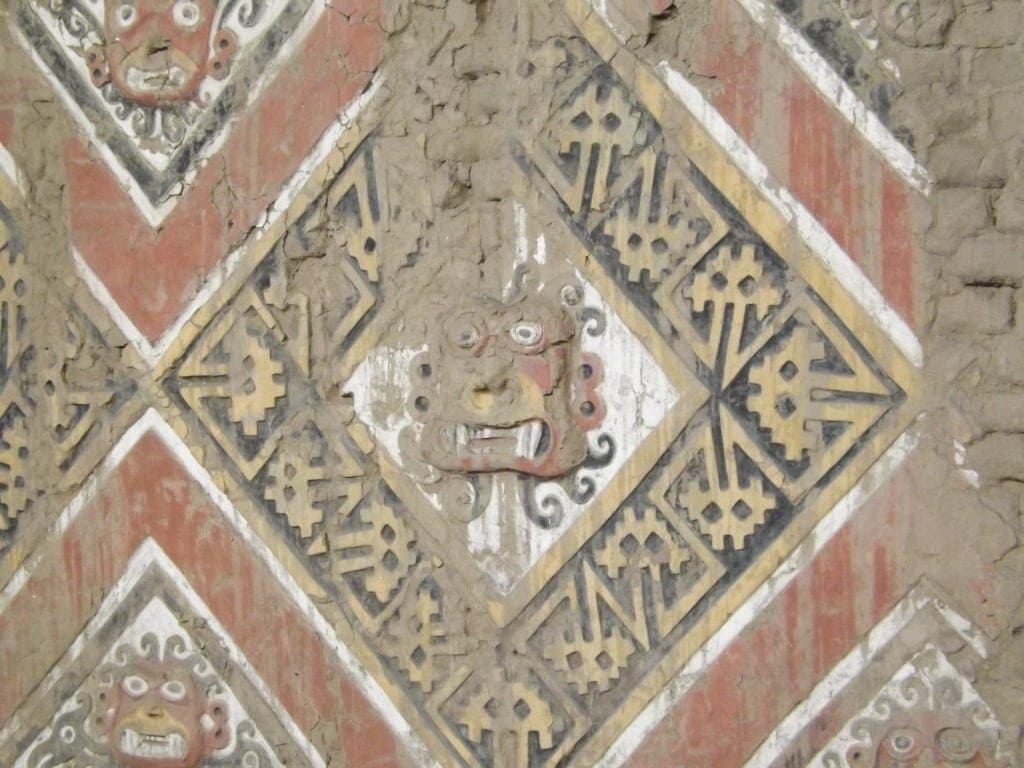
So, the day after our exploration of the Chan Chan site, we hopped in a taxi from Trujillo’s city centre and headed to these temples about ten minutes outside of town.
Excavation is still continuing on the Huaca del Sol (Temple of the Sun), so you can only explore the interior of the Huaca de la Luna (Temple of the Moon).
Both temples form a part of the Moche capital city of Cerro Blanco, a few ruins of which survive between the temples, and although the Huaca del Sol is the bigger temple, it was ransacked and partially destroyed by the Spanish conquistadors so it has provided a lot less information than the Huaca de la Luna.
The Huaca del Sol was an administrative type building belonging to the government or chiefs of the city, while the Huaca de la Luna was the religious centre and has the more interesting history.
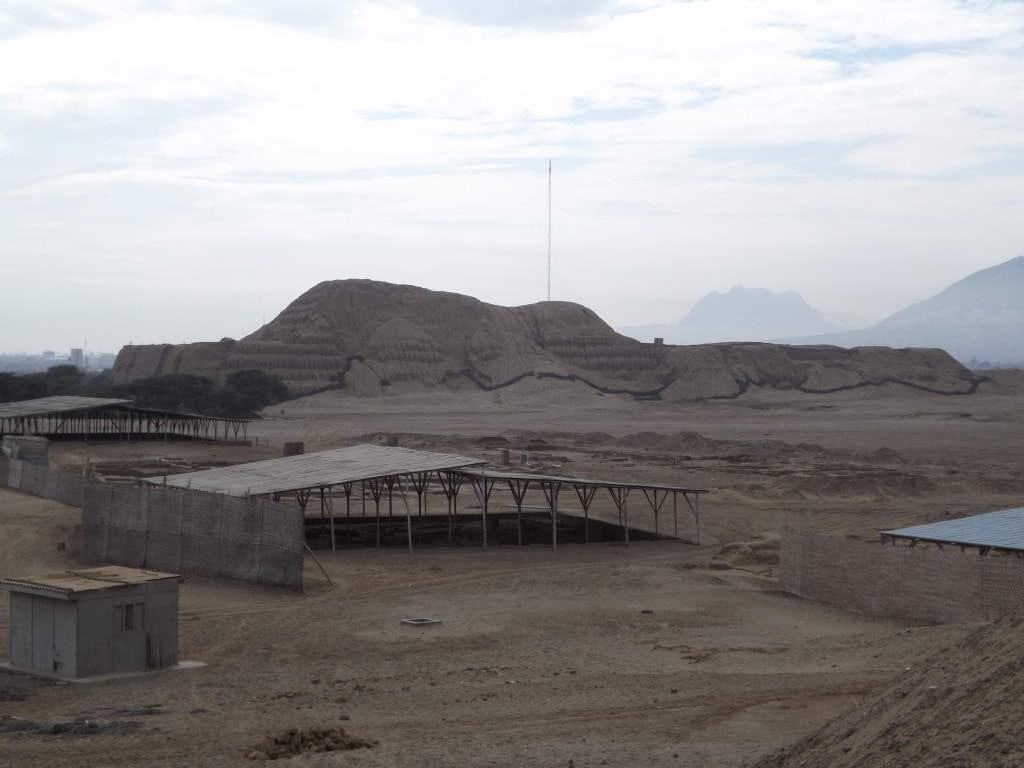
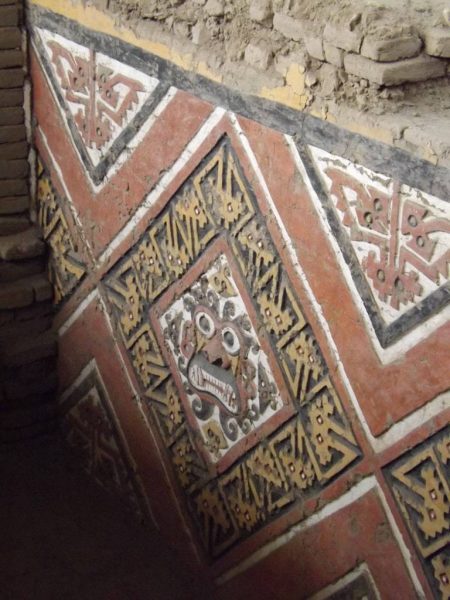
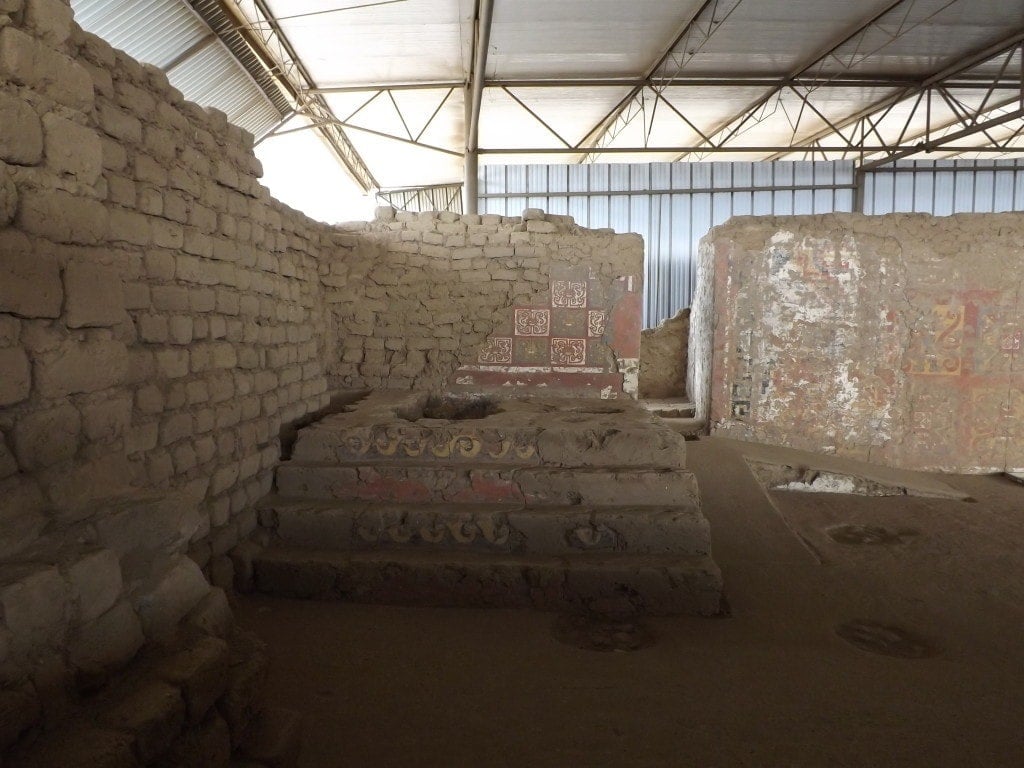
We headed first into the museum, a large and well-designed building which put the museum of the Chan Chan site to shame, with tons of fantastic, detailed information and decent English translations (which makes learning so much easier!).
There are hundreds of artefacts at the museum, including lots of well-made pottery which was discovered in the temples and which has been used to decipher lots of information about the temples and the way of life of the Moche people.
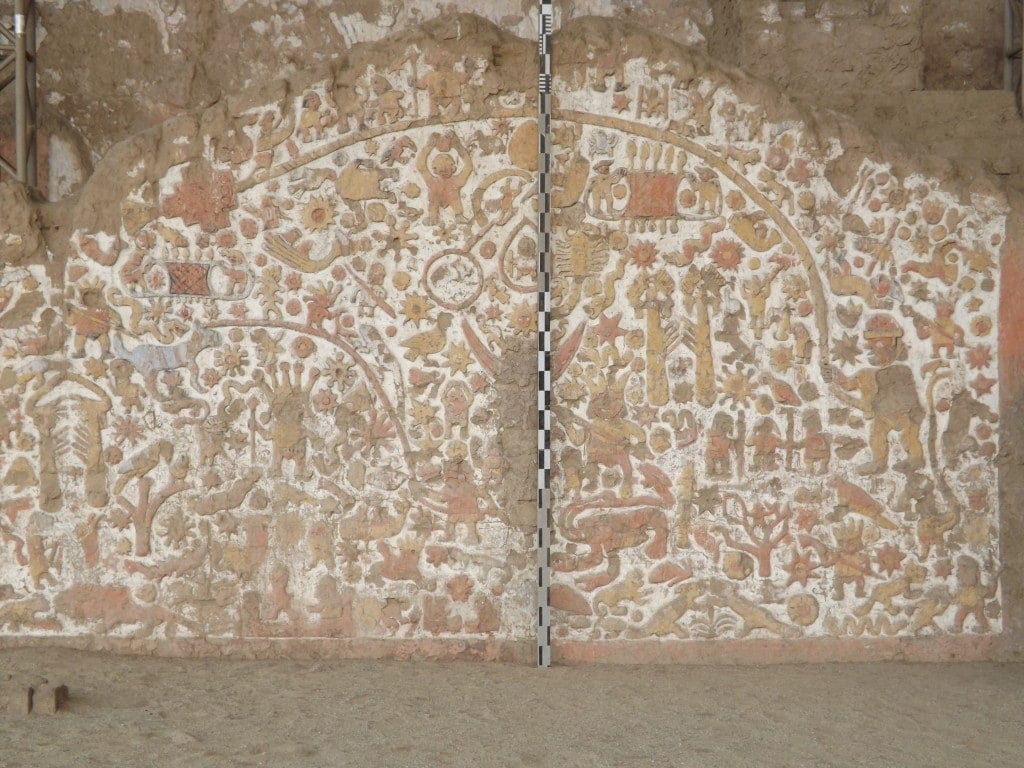
We were particularly interested in learning about the human sacrifices which took place at the temple. There were two kinds; one ritual to appease the gods and maintain order, which was carried out regularly, and a more sporadic ritual to placate the anger of the gods during times of bad weather, such as the El Niño phenomenon which visits Peru every nine years.
Both types of sacrifices began with ritual fighting between warriors, in which the winner was the first to remove his opponent’s helmet and grab his hair. The losers were stripped and tied up, and then led to the priests in the temple.
After a few days spent “preparing” the unlucky losers were sacrificed to the gods. For the ‘normal’ ritual, the sacrifices would have their throats cut and the blood collected in a cup to be presented to the gods, then their bodies were buried. For the El Niño rituals, after their throats were cut the sacrifices’ bodies would be cut into pieces, and left on the side of the mountain for the mountain gods.
There was also a lot of information in the museum about the tombs found inside the temple, and how the items discovered with them helped to identify the bodies and what role they played in society. For example, the body of a woman was discovered surrounded by lots of pottery of a higher quality than usual, and also potter’s tools, suggesting that she was a highly skilled and revered potter given a tomb within the temple.
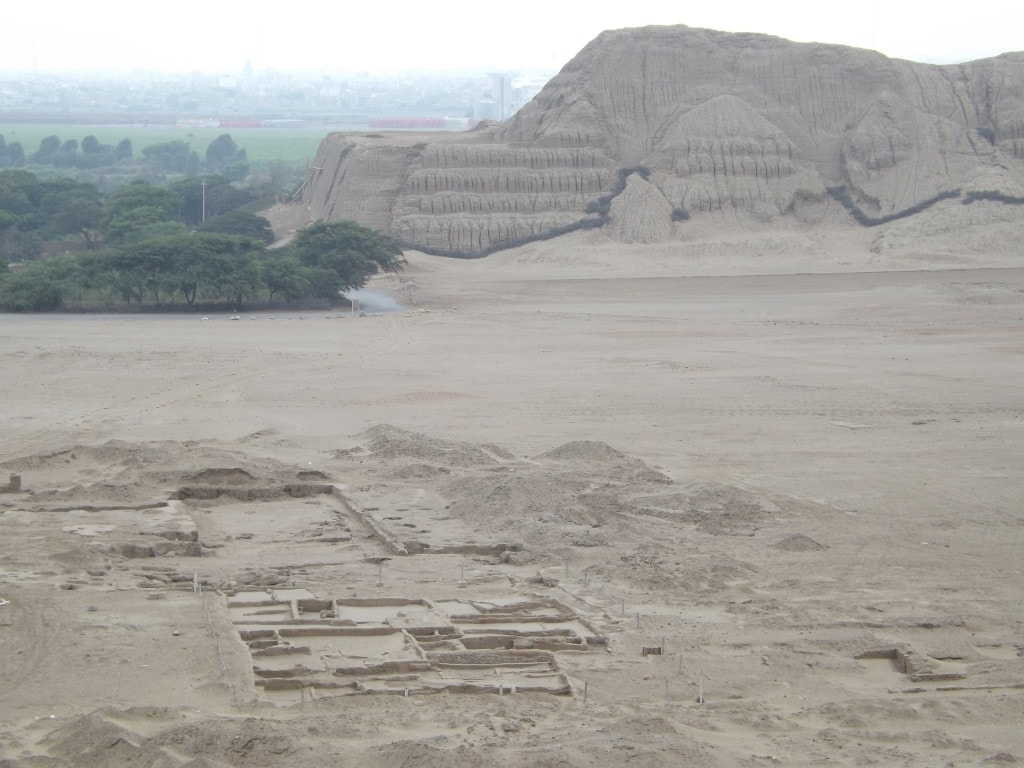
After the museum, we headed across the site to the Huaca de la Luna. You can only enter as part of a guided tour, and as the next English tour wasn’t for an indefinite amount of time (between twenty and ninety minutes depending on who we asked) we tagged along with the Spanish tour instead. Luckily, we weren’t the only non-Spanish speakers on the tour, so the guide spoke slowly and clearly and I actually managed to understand quite a bit of the information – unlike our tour in Chiclayo a few days before.
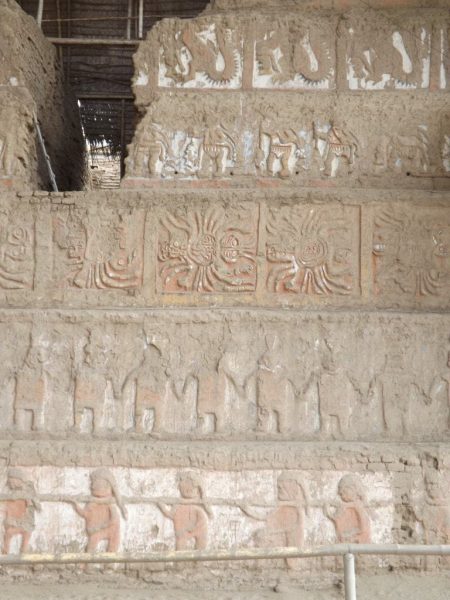
The interesting thing about the Huacas del Sol y de la Luna is how well the temples have been preserved. The Huaca de la Luna was actually built over by the Moche people, who would build a tomb, carve and decorate the walls, then seal it up inside adobe brick walls. The several layers of the temple, plus the mound of sand it was buried under until its discovery, have preserved the walls and carvings really well – including the original paintwork in red, yellow, white and blue, which still survives. Since the temple dates from the Moche civilisation of 100 – 800 AD and has been buried under a sandy pyramid since then, this was particularly impressive; especially considering that many parts have not been restored at all and have been left as they were found.
The site of the Huacas del Sol y de la Luna was definitely the most impressive ruins we visited in Northern Peru, especially because the fantastic museum and clear tour guide meant that we learnt a lot more about the history and culture of the pre-Inca Moche civilisation that built them than we did at Chan Chan or the sites at Chiclayo.
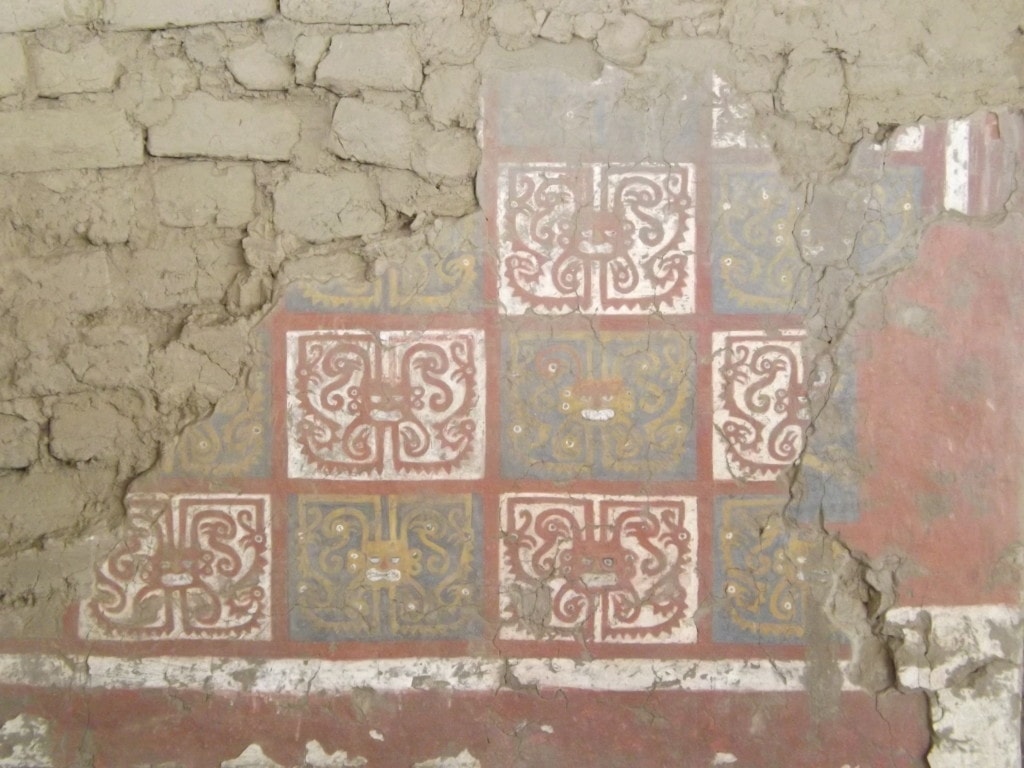
Lima’s Centre and San Francisco Catacombs
27th-31st March 2014
Although we spent five nights in Lima – a long time by most standards – we didn’t actually do much sightseeing in Peru’s capital.
After two weeks of continuous, often stressful, travel first through the Amazon and then down Peru’s arid north coast, we were exhausted, and used our time in Lima to relax, catch up with things, and spend some much-needed time socialising (because, after two weeks alone together, Sam and I were frankly sick of one another!).
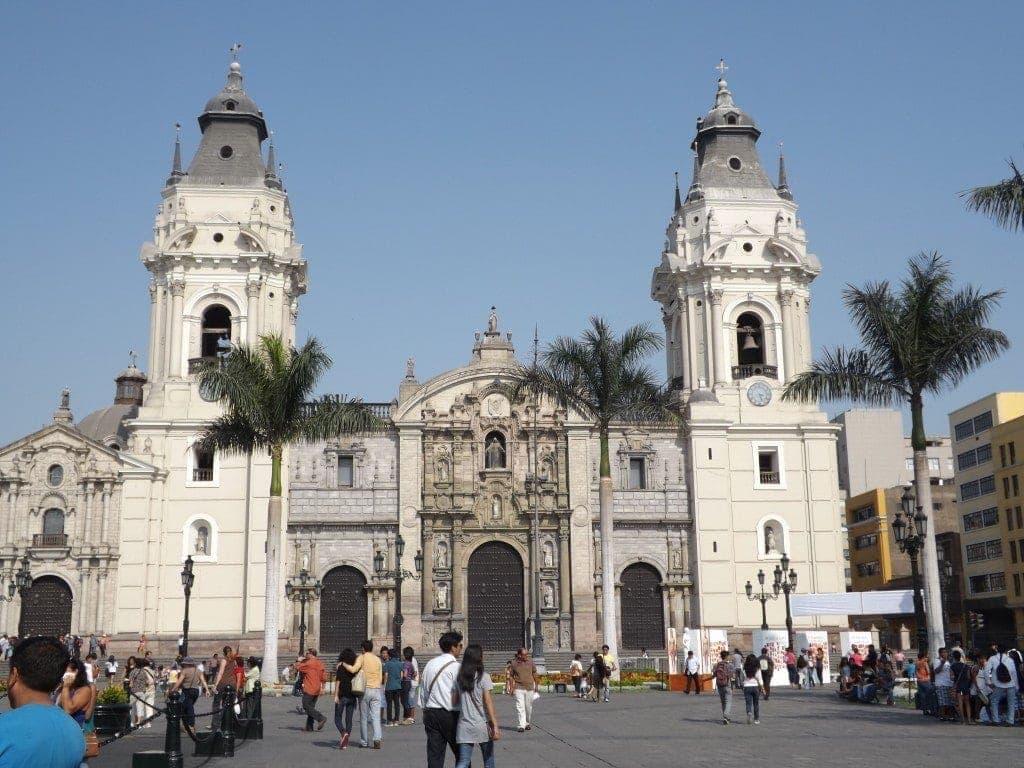
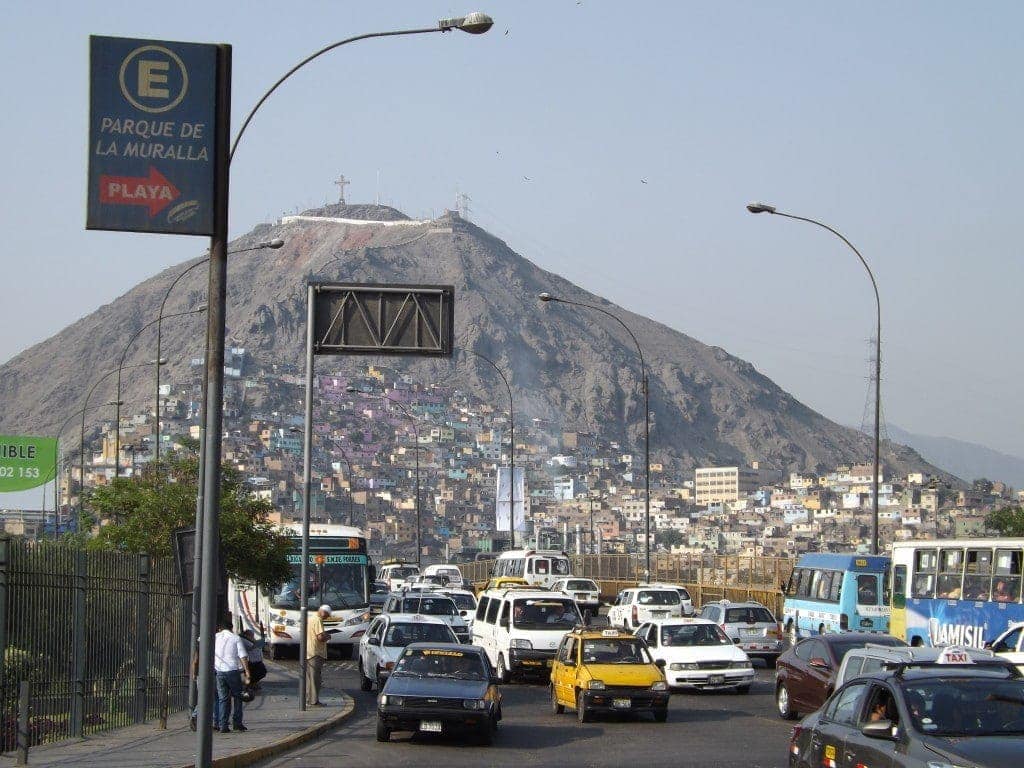
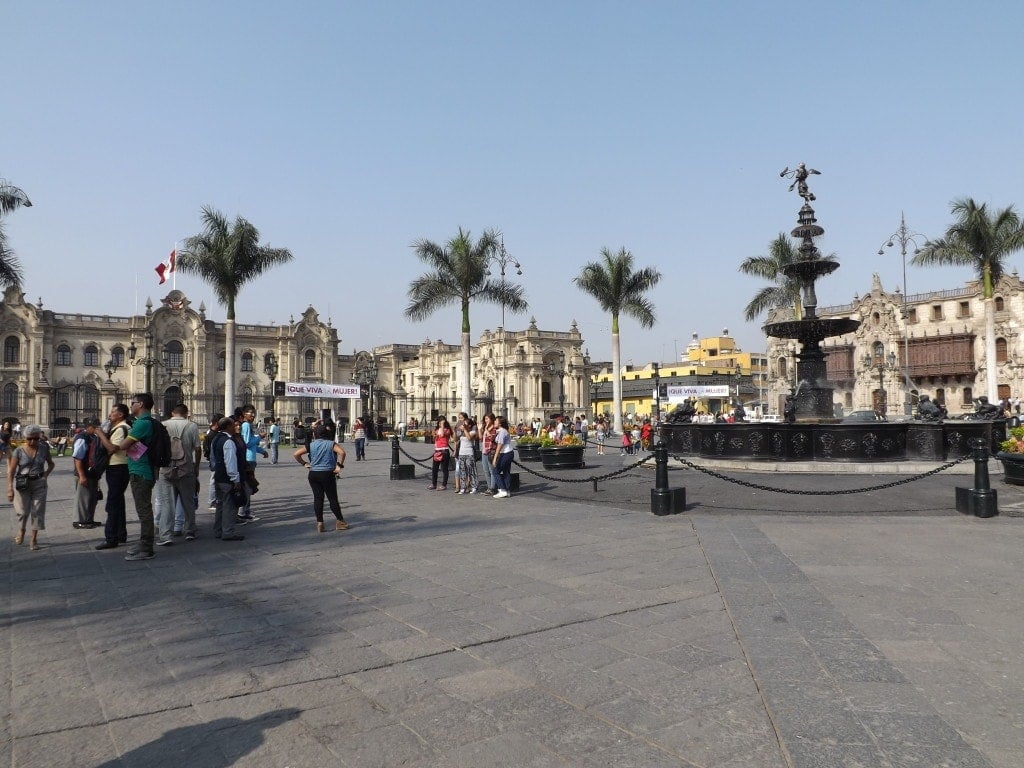
However, we did manage to leave the clean and modern Miraflores district for a little culture and history on one day during our time in Lima, and headed out into the heart of the old city.
We started in the Plaza de Armas, where a small festival was being held in honour of women: “Que Viva la Mujer” included a big stage with various Peruvian music acts, as well as exhibitions around the plaza promoting things like body confidence.
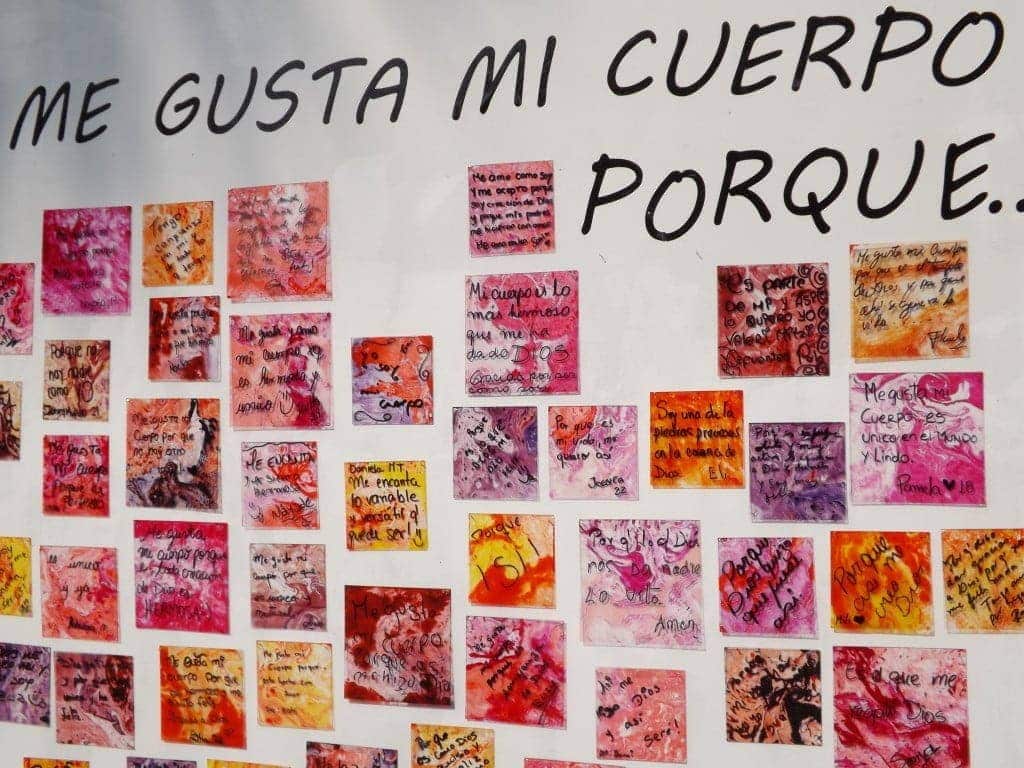
I really liked the idea behind big boards which had been set up with statements in Spanish like “I love my body because…” and then space for passers by to write in their answers.
We walked around the old neighbourhood and up to the river, before heading to the old church and monastery of San Francisco. We sat on the steps in front of this beautiful building, with its crumbling yellow façade, and soaked up the brilliant, warm sunshine – chatting with a man from Cusco who introduced himself and shared some old Cusco currency with us!
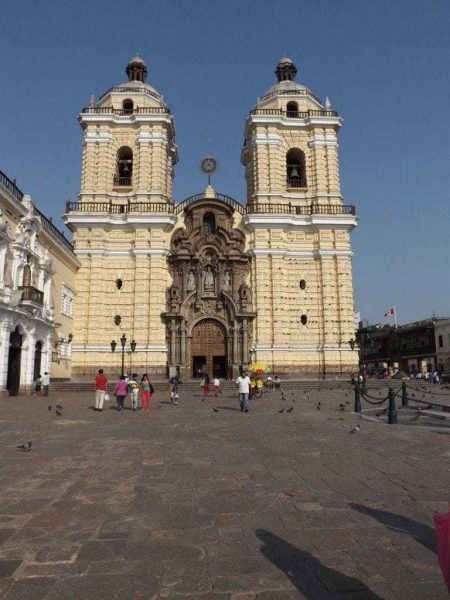
Inside the monastery, we paid just S./7 (less than £2) each for a guided tour, which turned out to be completely amazing. Our tour guide was a lovely, tiny Peruvian woman about half my height, who was absolutely adorable; really kind and so enthusiastic about the tour she was giving. She spoke English with a sweet, clumsy accent (using unique phrases like “he was capturate”) and gushed about everything in the monastery with infectious passion.
Tour highlights included the library; a narrow, Harry Potter-esque room filled with crumbling, dusty books on floor-to-ceiling shelves – complete with tiny winding staircases to reach the upper shelves – and some beautiful antique chairs which had all been ‘made to measure’ in size and shape for the specific monk who would spend his life in that chair studying.
The choir room was also pretty impressive, with an enormous, ornately carved wooden structure which held huge song books on four sides and which could be spun so that every one of the hundred or so monks could read the music. The last section of the tour, through the catacombs underneath the church, was creepy but fascinating.
Our wonderful tour guide told us that the catacombs are far bigger than the section that has been excavated, as all the churches in the area are connected to the same set of narrow underground passageways. In deep wells and other mass graves, hundreds of years worth of skulls and bones had been sorted and arranged by archaeologists, while in other graves the bones had been left untouched because moving them would cause too much damage. With low ceilings and lots of dark corners, it was a pretty claustrophobic experience, but really interesting to look around.
Taking the Peru Hop Bus from Lima to Cusco Bus
31st March – 8th April 2014
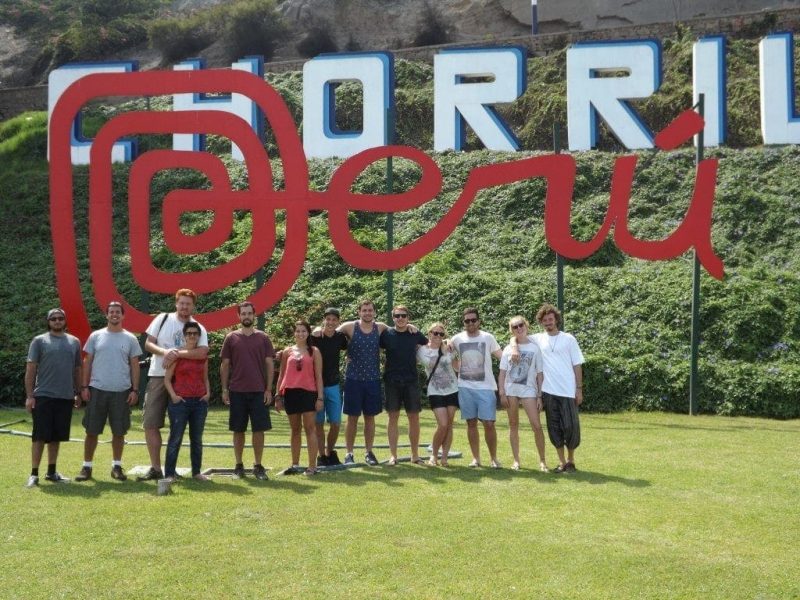
We travelled overland from Lima to Peru with Peru-Hop, a hop-on, hop-off bus tour with stops in Paracas, Huacachina
I wrote up the 9-day bus tour separately – click here if you want to read about those adventures. And if you’re considering booking a similar trip, click here to read my Peru Hop review.
Ballestas Islands in Paracas
1st April 2014 (one of the stops on our Peru Hop tour)
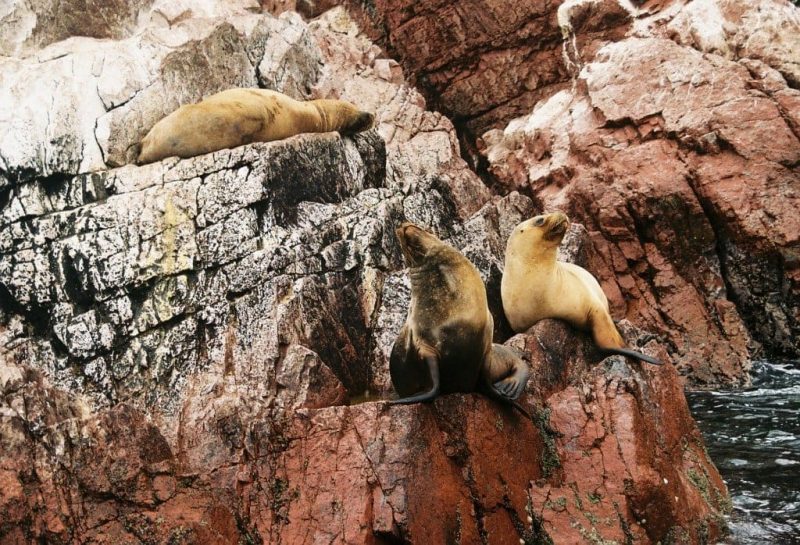
One of the main attractions in Paracas is the Ballestas Islands just off the coast, about a 40-minute ride by motorboat.
Dubbed the ‘Galapagos Islands of Peru’ by hopeful tourist agencies, this small, rocky archipelago wasn’t quite the abundant nature reserve Ecuador has to offer, but it was still really impressive.
Ballestas Islands Tour, Paracas
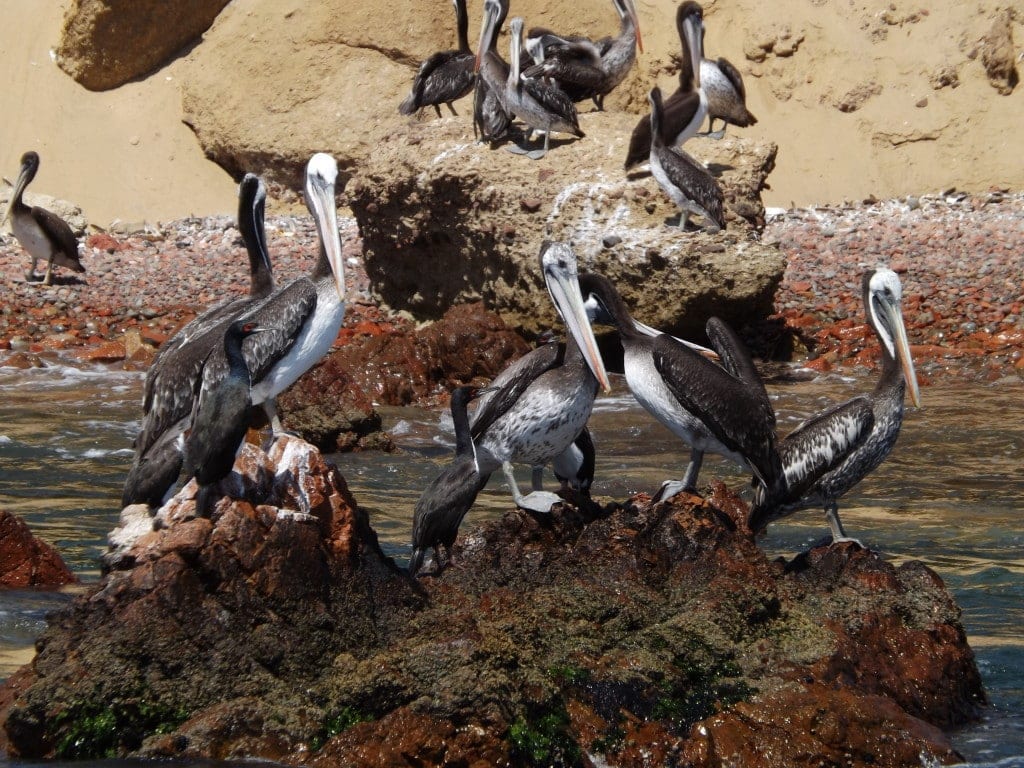
Since people aren’t allowed on the islands, there are no ferries and you can only visit as part of a tour, which we organised through Peru Hop – who we were travelling with between Lima and Cusco. The tour lasted about three hours and cost $20USD each, although I have a feeling there are cheaper tours on offer so do some research when you arrive if you’re looking to save money.
We headed down to the port at about 10am with a guide from the agency, who met us at our hostel in order to make sure that we didn’t somehow get lost on the five minute walk through the minuscule town to the port, and found ourselves on a pretty big boat with some thirty or so other tourists.
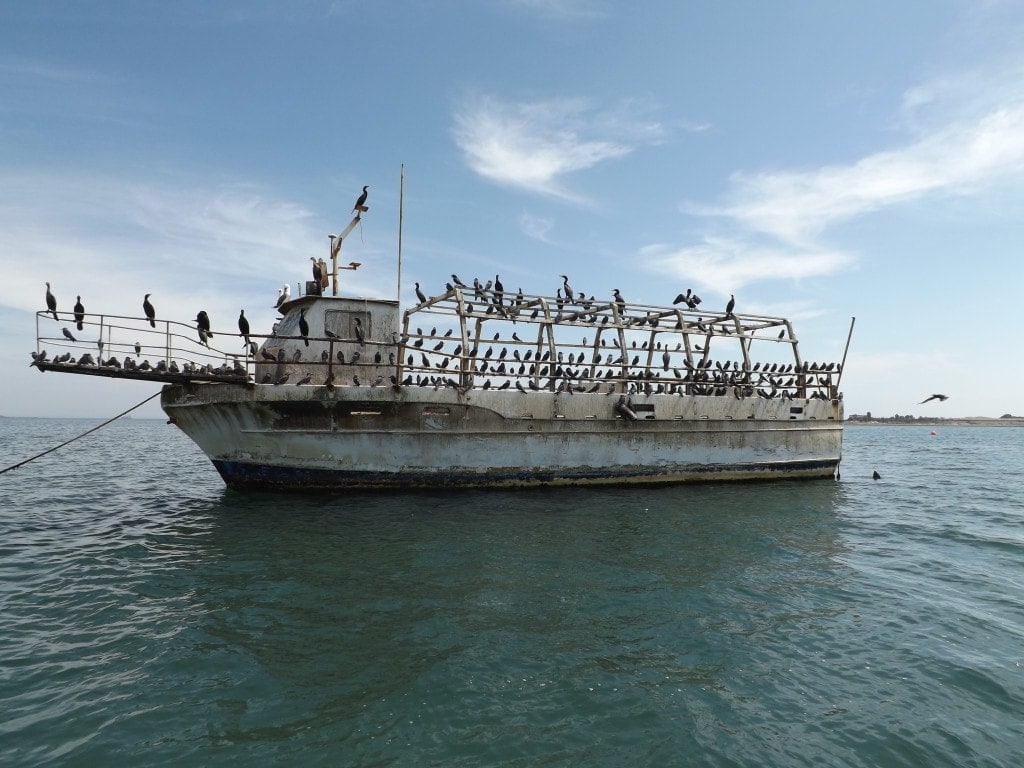
The tour was amazing. Stopping first at an abandoned boat in the harbour which is now home to hundreds of seabirds – and their rather foul-smelling poop – we then headed to the red sandy peninsula which juts out into the sea alongside Paracas, creating a natural harbour. This is home to still more seabirds, including huge colonies of pelicans – which we got a fantastically close view of – as well as a huge, old image of a candelabra carved into the cliffside by a pre-Inca civilisation.
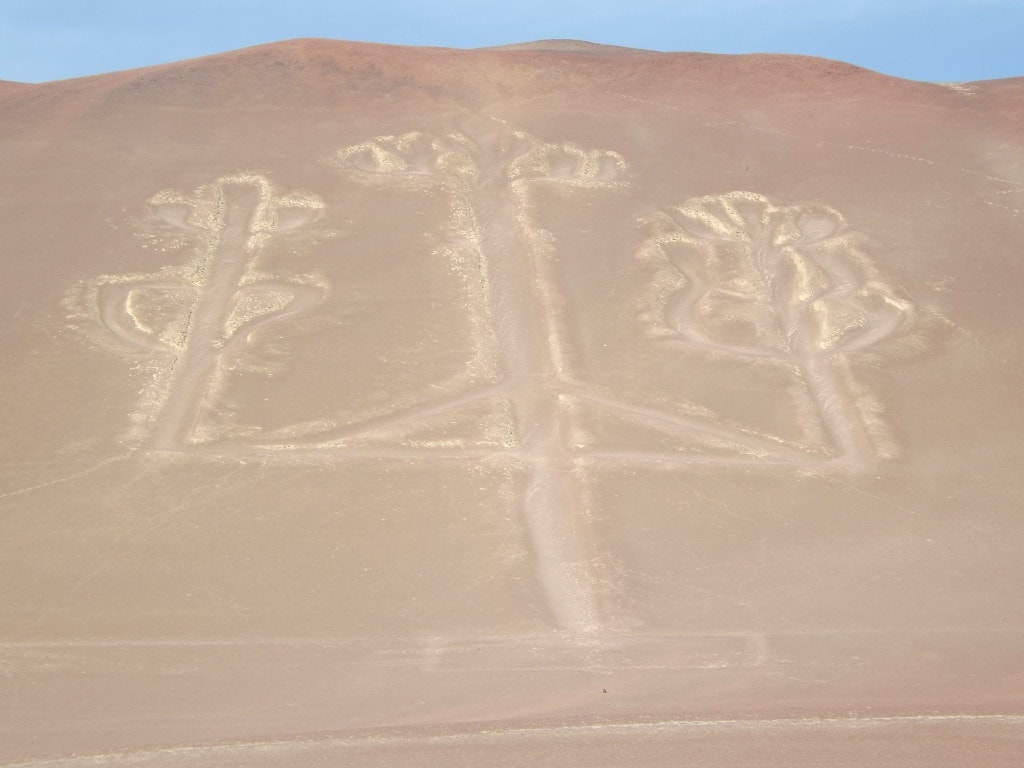
Reaching the Ballestas Islands
After the viewing tour of the peninsula, we sped out into the open sea to reach the Ballestas Islands, and I mean really sped; the boat bounced heavily over the waves and sent up a huge wall of spray which drenched the people sitting on the other side of the boat, while we looked on smugly, not realising that we would get the exact same treatment on the return journey.
After about twenty minutes or so, we reached the small archipelago of tiny, rocky islands, and found ourselves confronted with a group of gulls so thick that at first glance I thought the tops of the cliffs were covered with a greyish-coloured grass – until I realised it was moving.
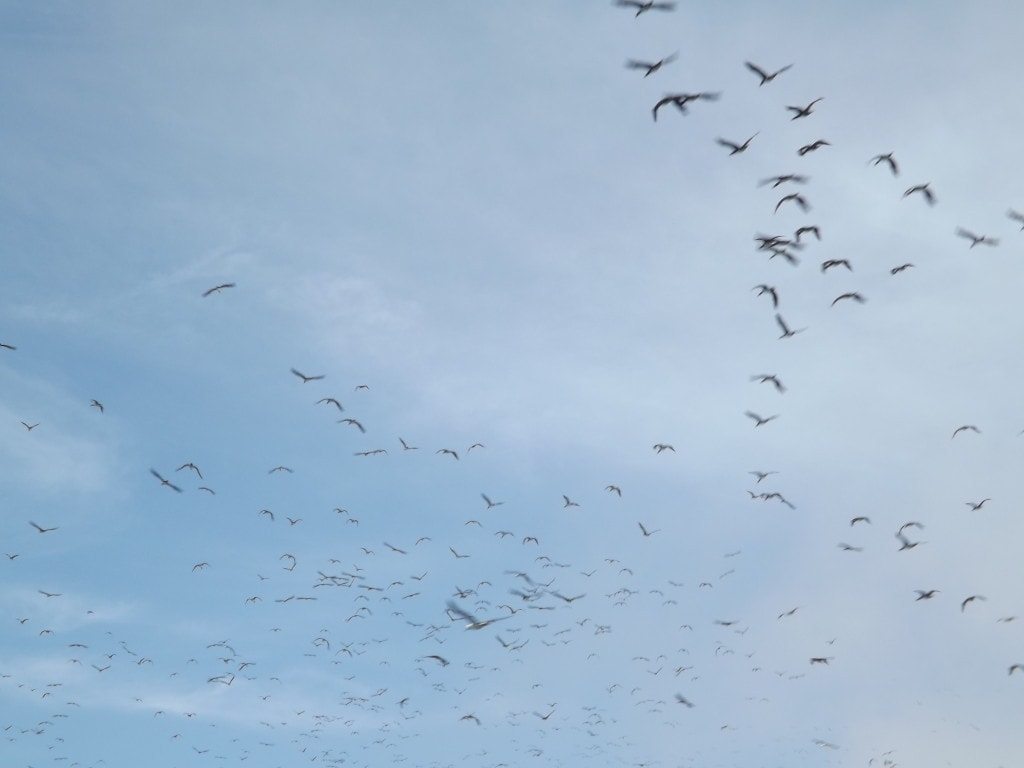
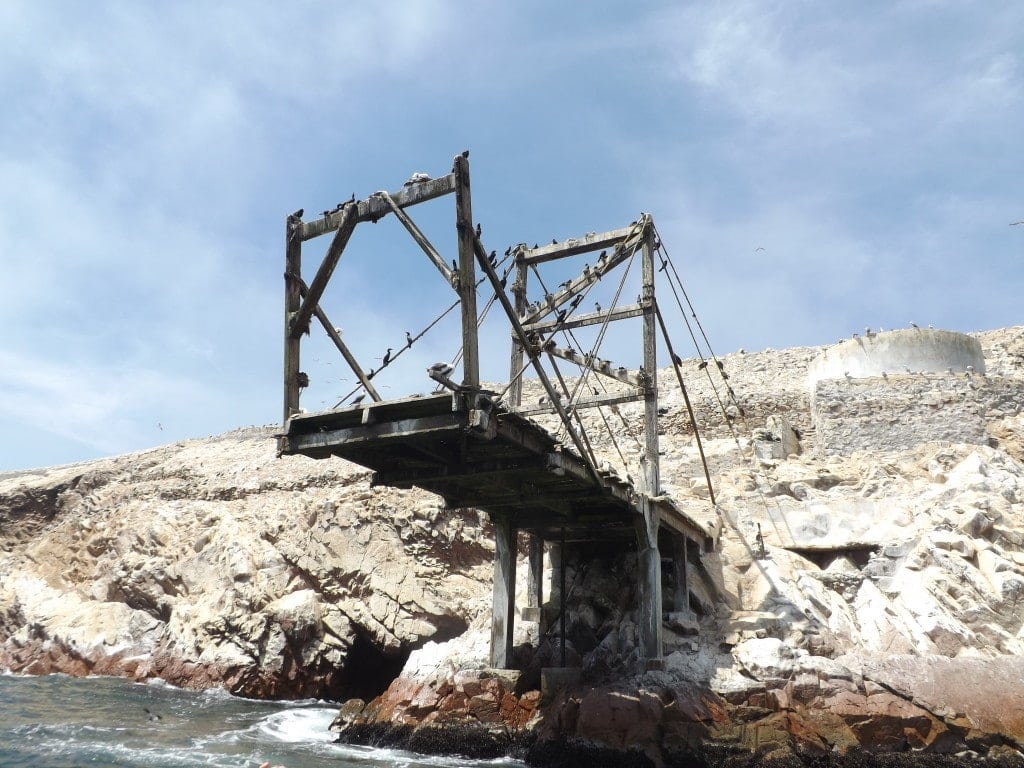
There were endless seagulls and pelicans, together making a loud noise of hollering and hooting, and coating the cliff-sides in the grey guano, the nitrogen-rich bird poo which makes such a good fertiliser that it was Peru’s primary export in the nineteenth century. Although now, guano is only mined three months of the year to improve sustainability and to leave the wildlife in peace.
I lost track of all the names given to us by the tour guide, but according to my good pal Google, the birds inhabiting or feeding on the islands include Peruvian Pelicans, Peruvian Boobies, Blue-footed Boobies, Neotropic Cormorants, Red-legged Cormorants, Guanay Cormorants, Turkey Vultures, Gray Gulls, Franklin’s Gulls, Band-tailed Gulls, Elegant Terns and Inca Terns.
Paracas Sea Lions
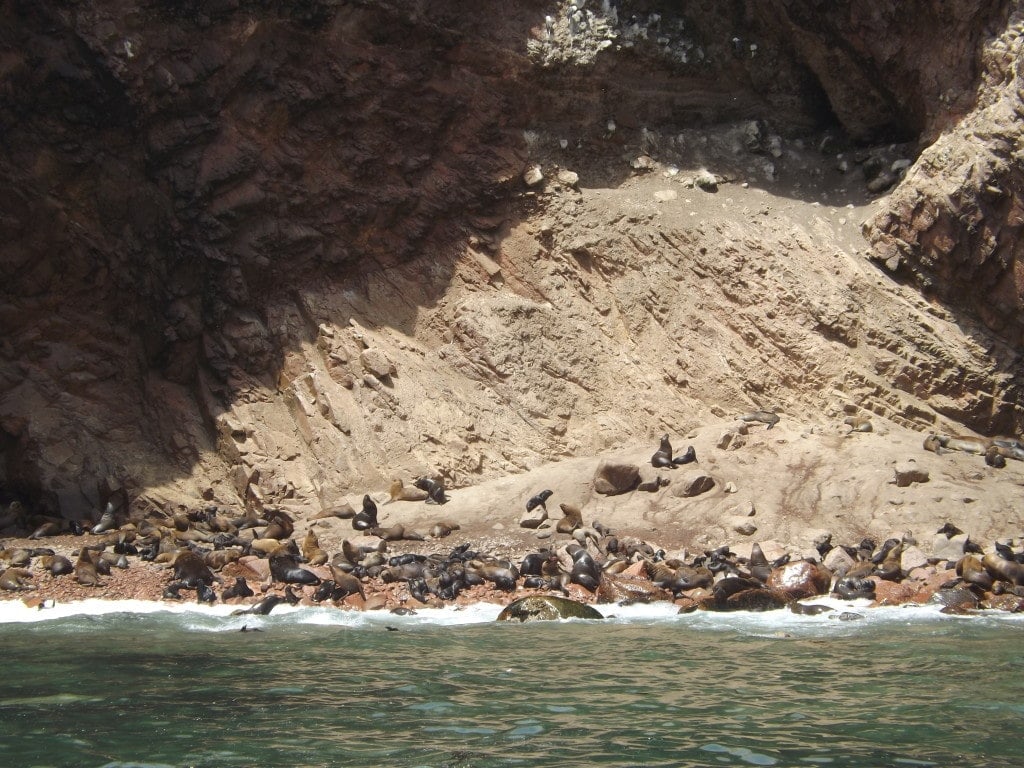
Rounding the first rocky outcrop of the island, and approaching a mysterious network of jagged cliffs, caves and natural tunnels, we started to hear the whooping barks of the animals which the Islas Ballestas are famous for. An enormous amount of sea lions make their home here, thriving because of an abundance of food and no natural predators (the water is too cold for sharks).
With around 4,000 sea lions inhabiting the island in families or harems (usually multiple females to a male), the beaches were quite literally covered in their chubby, brown bodies and the air resounded with the sounds of their wails and barks.
Sea Lion Pups!
We arrived a month or two after the breeding season, meaning that from our nearby position on the boat we were able to glimpse hundreds of babies on the beaches, playing in the shallow surf or being fed by their mothers. All the racket is thanks to these adorable little guys; the only way for a mother to recognise her young out of the multitudes on the beach when returning from a fishing trip, is by a unique bark sound which mother and baby can both recognise.
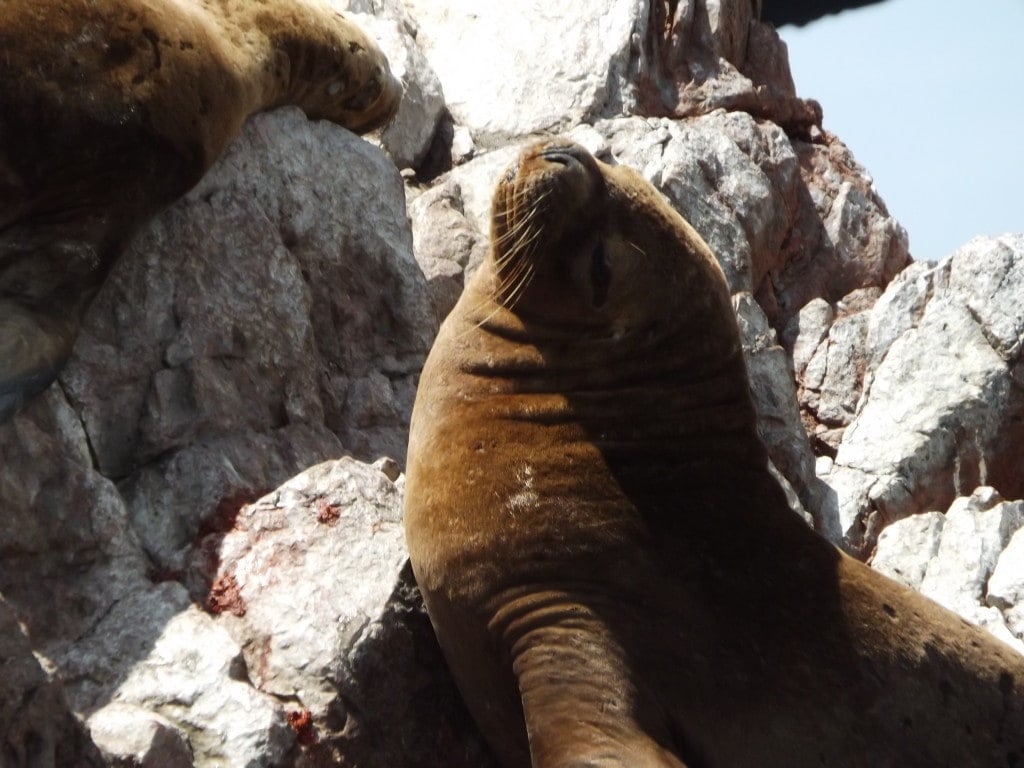
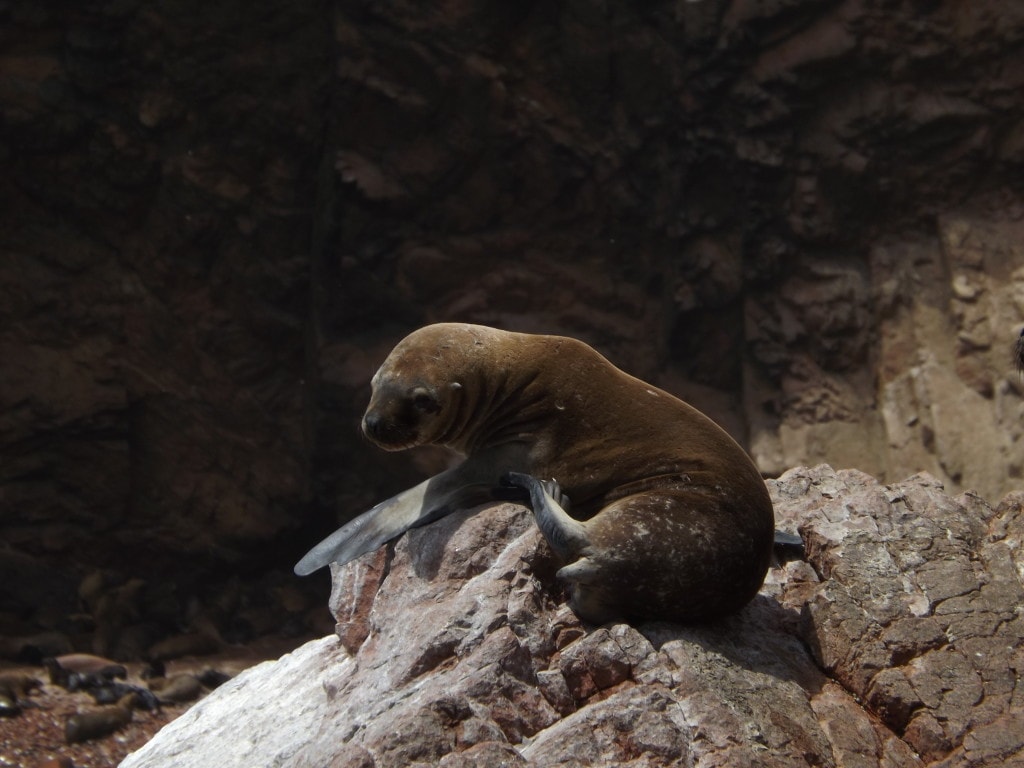
We also saw many female sea lions taking a little break from their noisy, playful young by swimming out to rocks a little away from the beach to sunbathe in peace. The babies can’t climb rocks yet, so up on small towers or outcrops of rock the mums can have a bit of peace and quiet. However, just before we sailed away from the islands, we were lucky enough to spot one particularly advanced little slippery black baby receiving a lesson in rock climbing from his mum, with both struggling up a smoothish rocky surface side by side.
The sheer noise and numbers of the sea lions was staggering, and we got to see so many incredible, unique instances like that one that the trip was truly breathtaking. I’m sure the Galapagos have a lot more to offer, but the poor man’s equivalent off the coast of Peru is by no means a weak compromise!
Adrenaline Overload in Huacachina
3rd – 7th April 2014 (one of the stops on our Peru Hop tour)
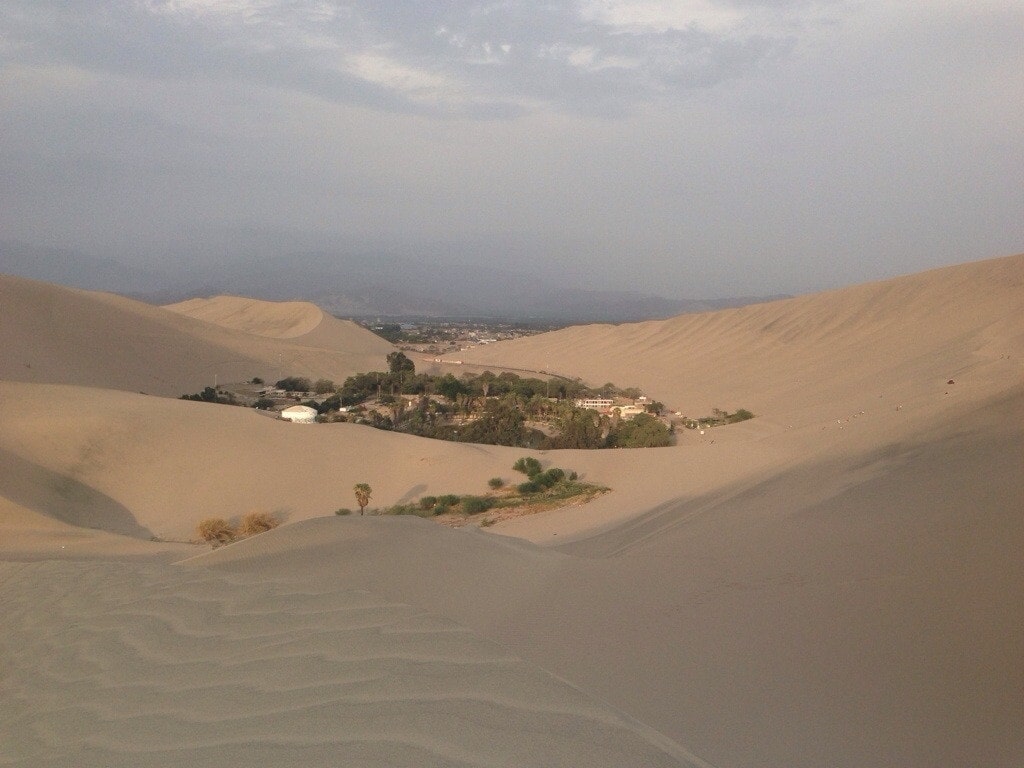
Huacachina, the second stop on the journey from Lima to Cusco with Peru Hop, turned out to be such a cool town that we decided to stay for four days – and would have stayed longer if we hadn’t had to reach Cusco in time for our pre-booked Inca Jungle Trek.
It’s a tiny town of a few hostels, hotels and restaurants clustered around a large oasis in the centre of the desert, and surrounded by staggeringly high sand dunes.
Although only a few minute’s drive from the nearby desert town of Ica, Huacachina feels totally isolated thanks to the endless, monotone landscape of yellow sand, and this isolation, plus all the awesome activities available in the dunes, gives the town a really cool, chilled out vibe.
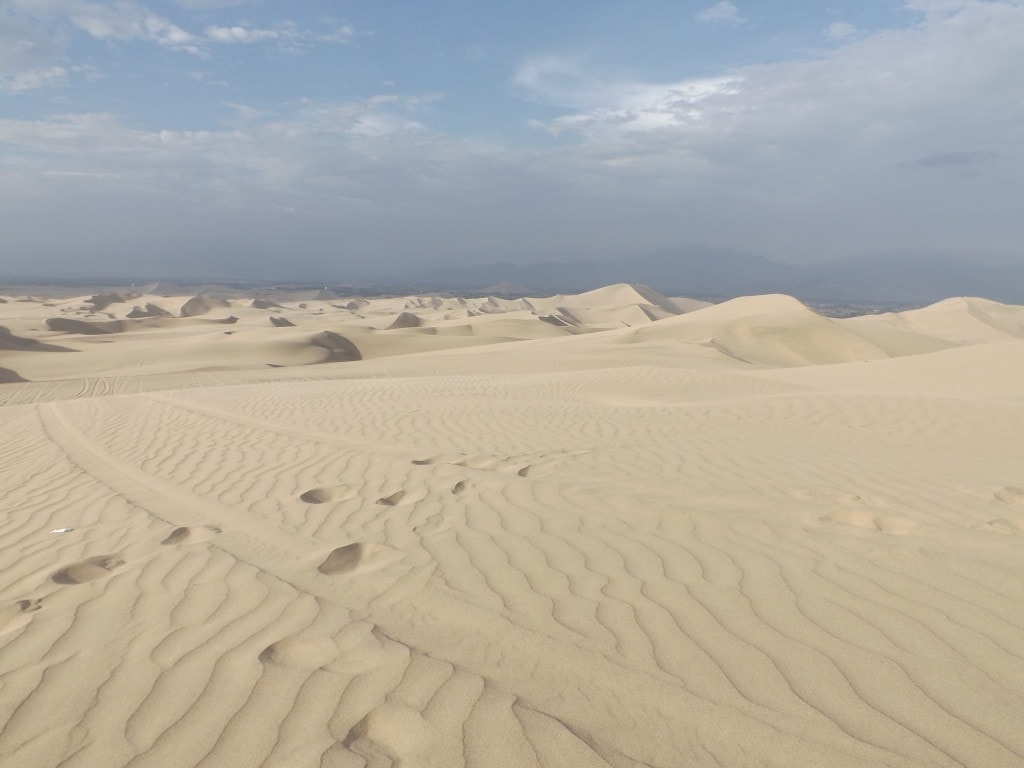
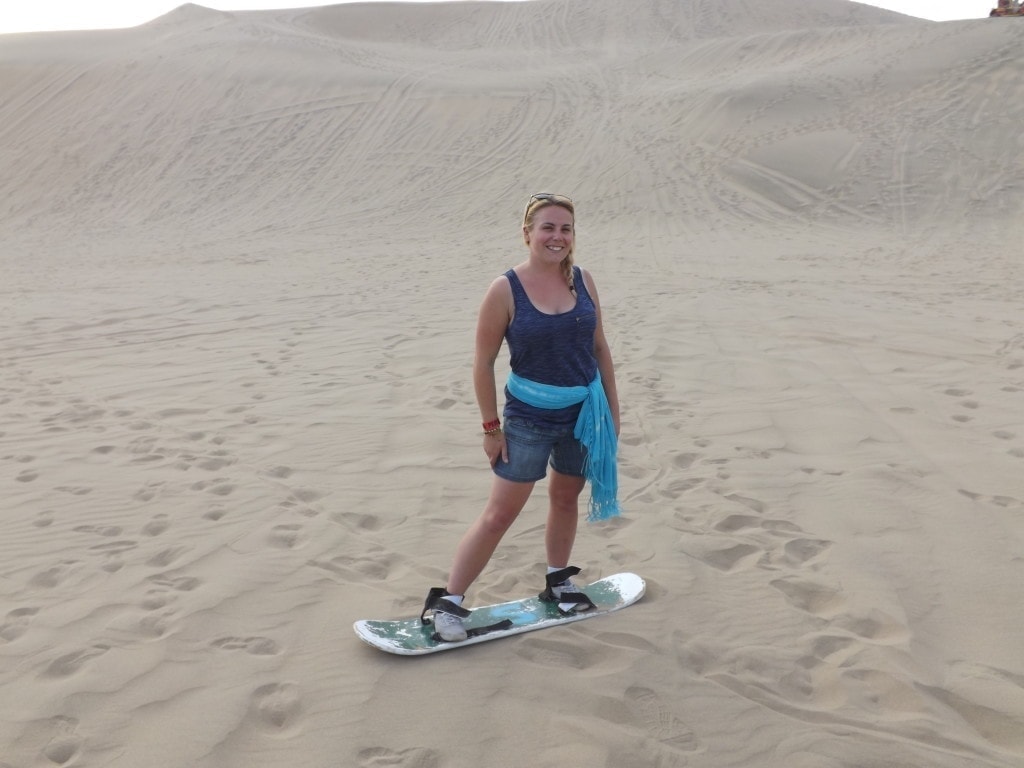
Vibe and surreal beauty aside, tourists and Peruvians alike come to Huacachina for one main thing: sandboarding.
An irresistibly cool, amazingly fun extreme sport that mimics snowboarding, sandboarding is something that you just have to try. Even if, like me, you have a fear of heights, are super clumsy, and have terrible balance, you have to strap your feet to that board just once and give it a try!
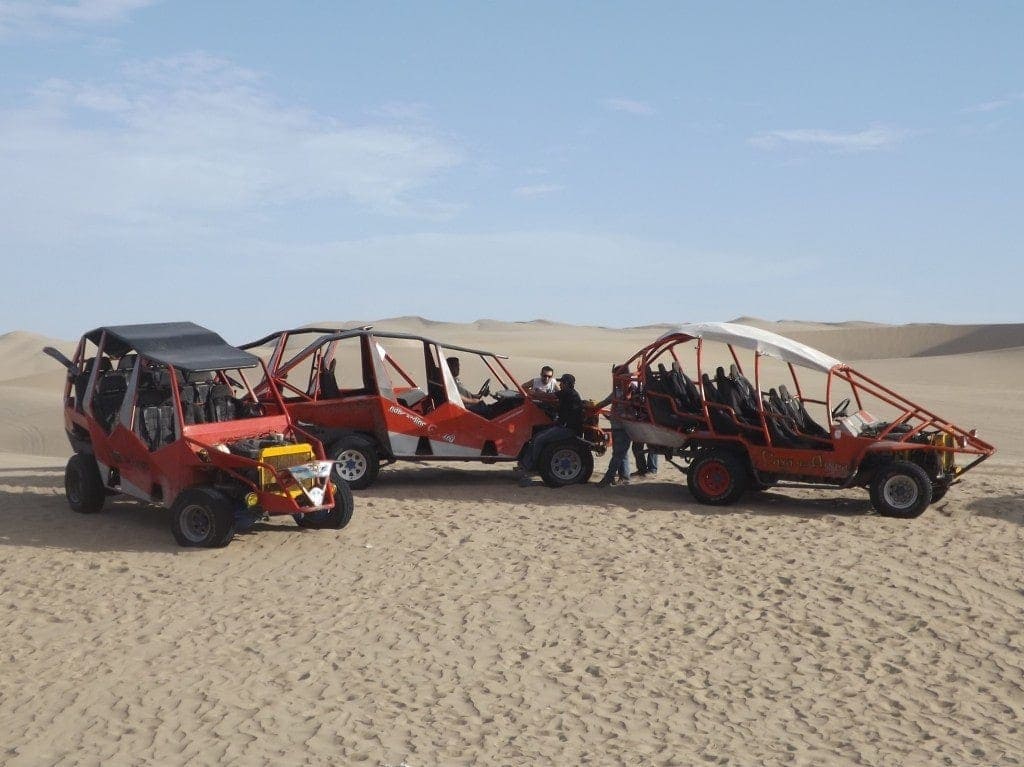
Which is exactly what I did! At about half four on our second day in Huacachina, the street outside our hostel was filled with the noise of roaring and rumbling, as dozens of open-sided, jeep-style vehicles known as dune buggies revved their engines and collected passengers for a desert trip.
Seven of us bundled into a scratched, scuffed dune buggy, strapped ourselves in, and with an enormous roar we raced to the edge of town and straight into the dunes.
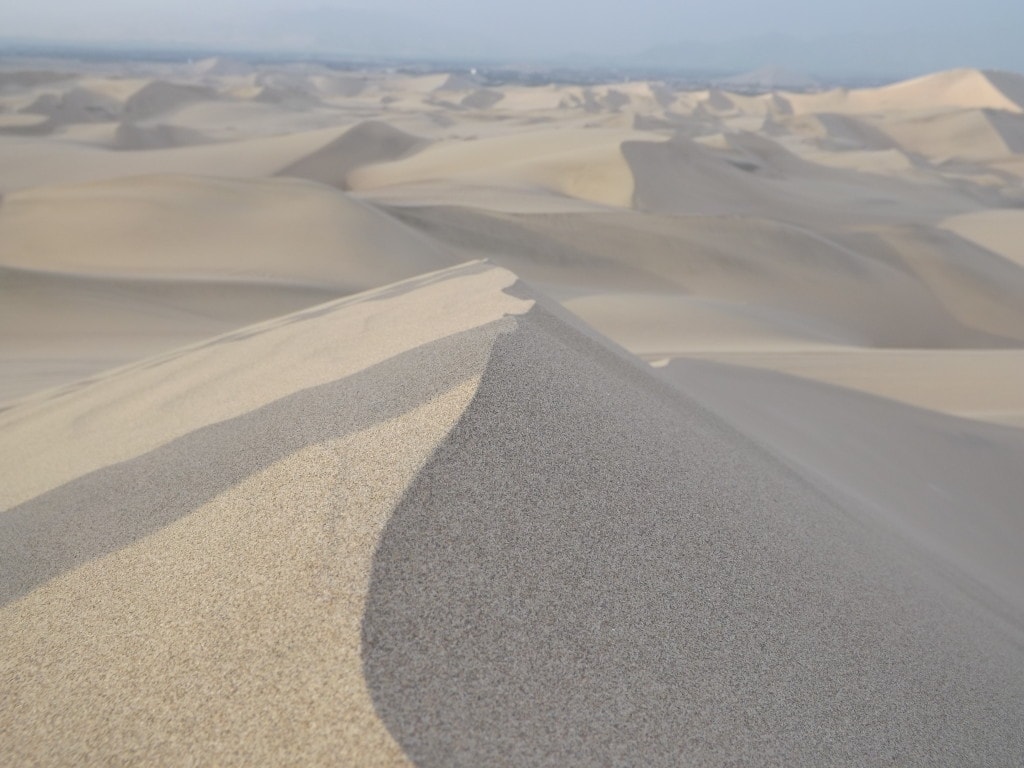
Luckily – or unluckily, depending how you look at it – we had picked a buggy with one of the crazier drivers. All of them like to throw the buggies around the dunes, roller-coaster style, but our driver took speeding to the next level.
My bum was on the seat for only about half of the journey, and my heart was in my mouth for all of it; we leapt off the top of dunes – flying for a few feet before crashing back into the sand – spun around corners, raced along at 60-degree angles, and basically bounced, swung and flew across the steep sand dunes. It was amazing!
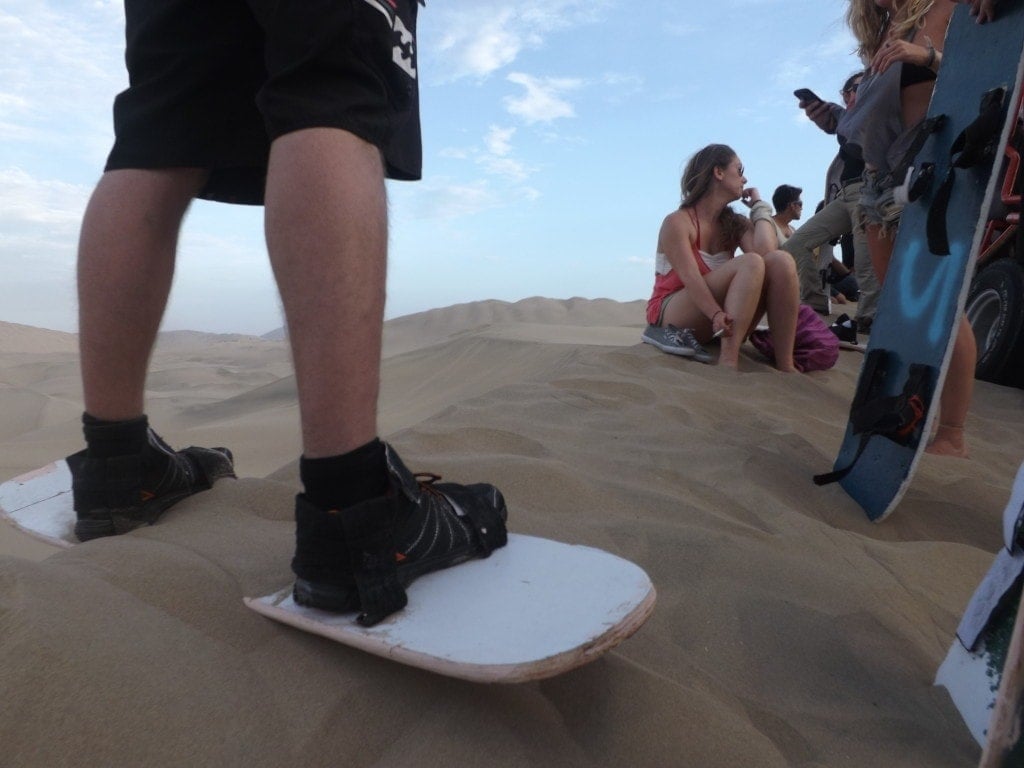
After about ten minutes of the super-fast, bumpy and insanely fun buggy ride, we stopped at the top of an alarmingly high dune for our first spot of sandboarding.
Our driver handed out the boards, exactly like plastic snowboards with Velcro straps for our feet, and we waxed them down and strapped them on. Which, at the skinny peak of a high, steep sand dune, is incredibly difficult; it’s very hard to get both feet on the board before you start sliding down.
Heights are one of the things I struggle with most – especially annoying because until a few years ago, I was never afraid of them – and as soon as I peeped over the edge of the dune from my poorly balanced position on the slippery board, I baulked.
My knees were shaking, my stomach was in knots, and I knew I couldn’t face it. Watching the people go before me didn’t make it any easier, as one by one they all ended up spinning in the sand or falling on their bums.
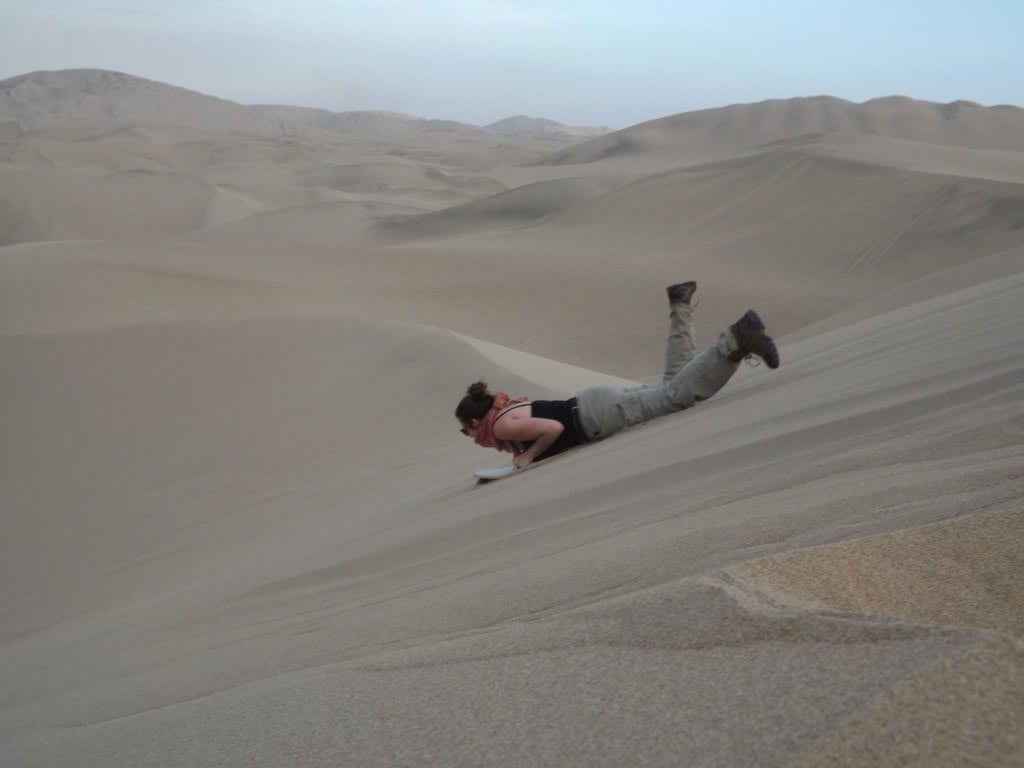
Instead, I opted for the slightly less cool, but possibly more fun, way down; on my front. Lying down on the board, gripping the straps for dear life, I hurtled down the dune face-first at an incredible speed.
It was horrifyingly scary, but also a huge adrenaline rush and, almost surprisingly, fun! In fact, after an initial blood-curdling scream and a few choice words I’m not proud of, I actually loved it!
After the first dune, we stopped four more times. The second and third dunes were smaller and not quite as steep as the first, so I attempted these standing up, with results that were, for onlookers at least, incredibly funny.
Just once I managed to make it all the way down the smallest slope (about six foot high) without falling over, and of course, that was the only time absolutely no one was watching.
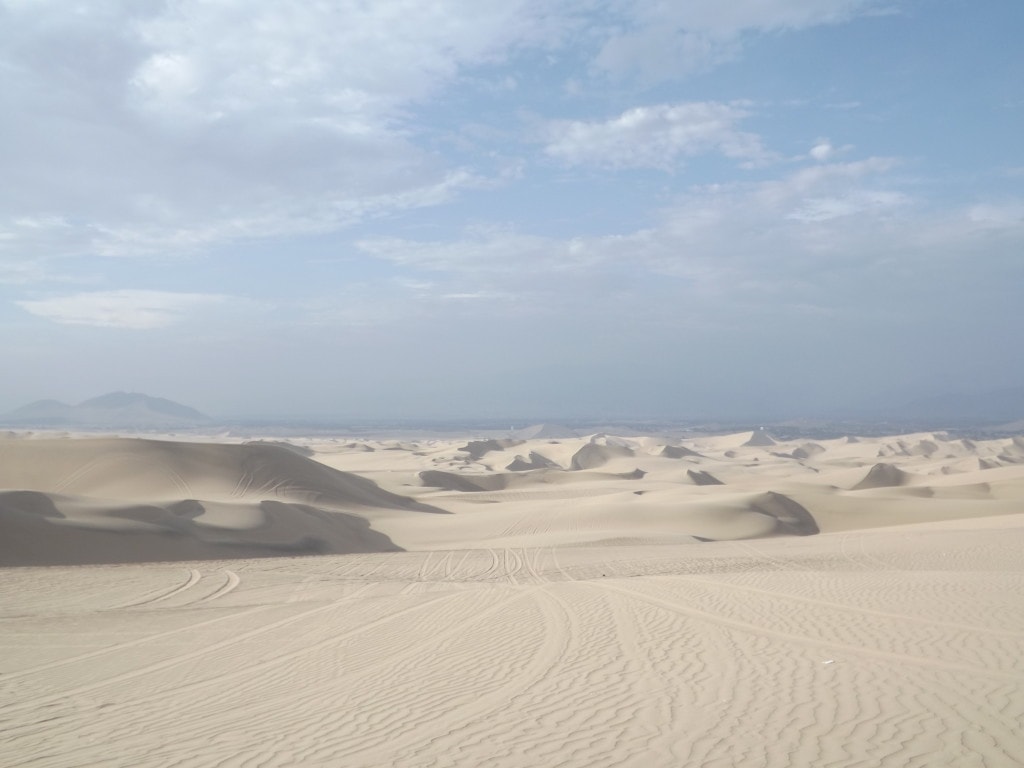
Sandboarding standing up is a talent that is beyond my unbalanced body’s poor athletic capabilities, and besides, lying down is faster, less risky and therefore much more fun – so I took on the last two dunes face-first.
The experience is amazing, hurtling towards the earth so quickly you barely have time to think, and we all finished the evening on an absolute high – especially after the return journey by dune buggy.
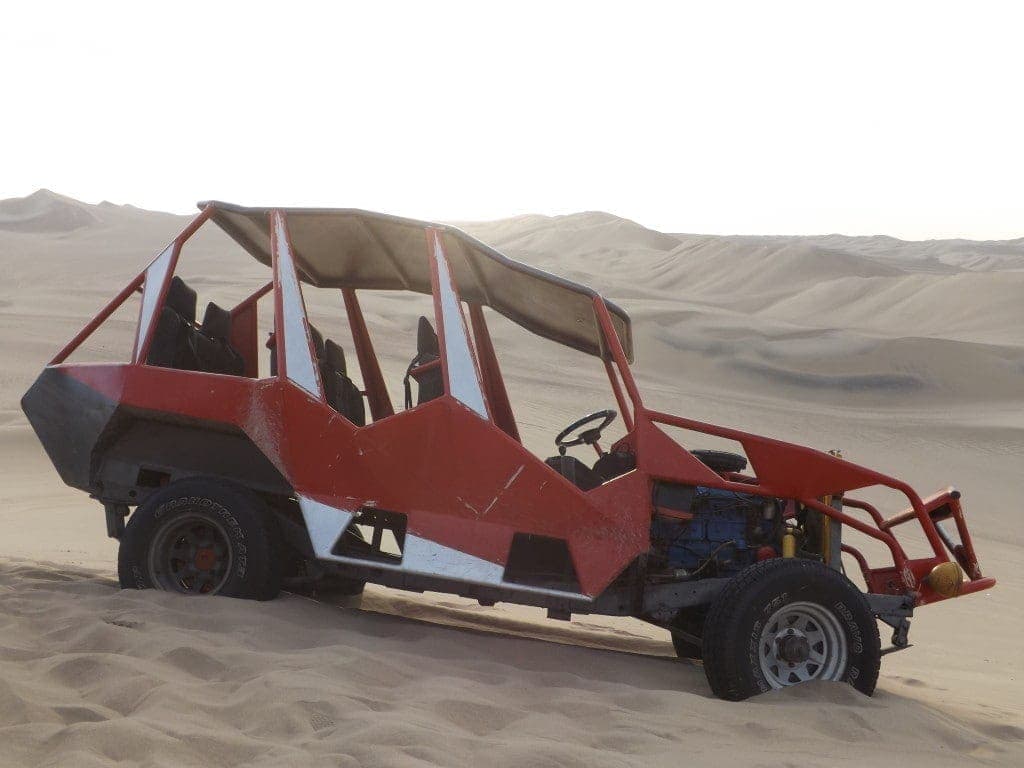
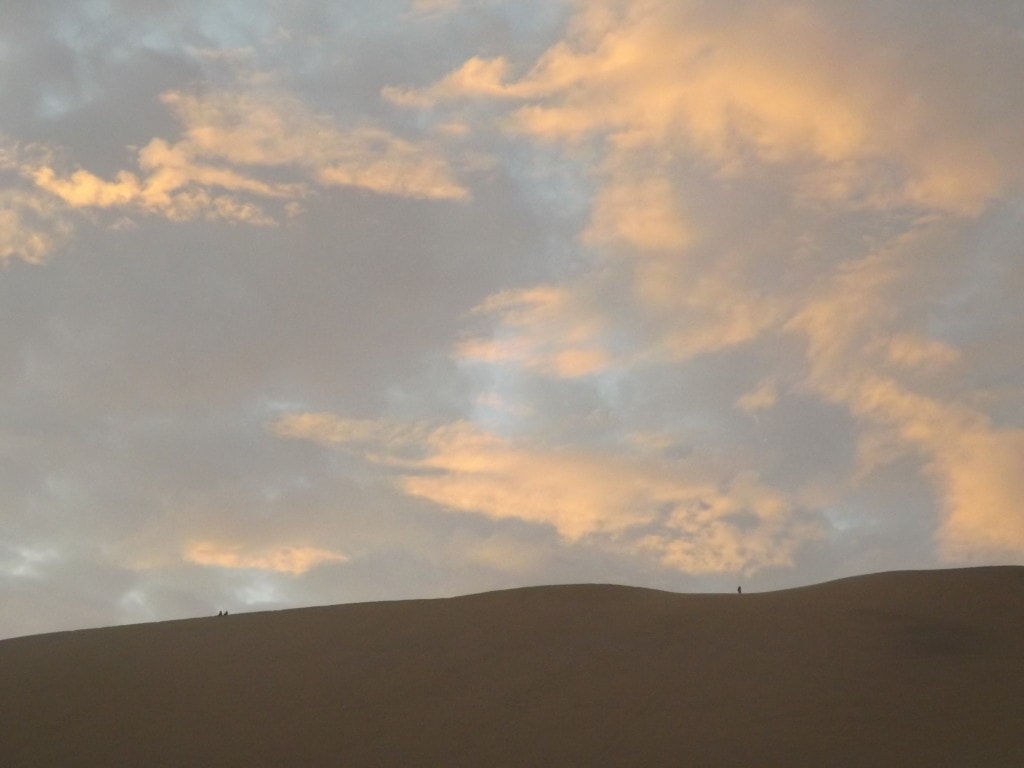
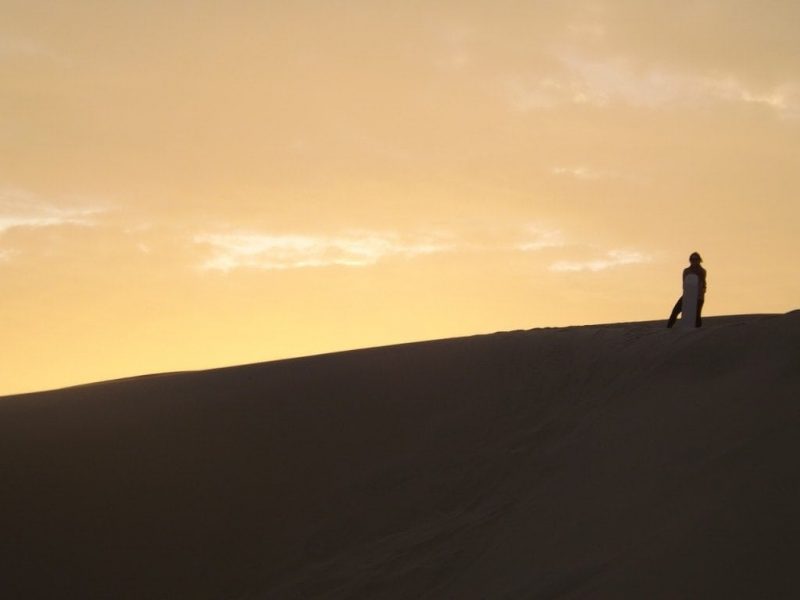
In fact, we loved the experience so much that the next day we rented boards again and headed out into the dunes alone.
Initially, Sam and I attempted this at about 10:30am, but the desert sun was so intense we could hardly move, and the sand was burning my feet through my shoes and socks, so we retreated to our hostel pool and returned with a group of friends that evening.
After another embarrassingly bad attempt at standing up, I embraced my true calling and lay down on the board – although I spent more time watching the sunset, which was absolutely gorgeous, than boarding.
Every evening, the yellow dunes turn gold under a brilliant pink and peach sky, beautifully lit by the sun’s rays. The spectacle is incredible, and best viewed from the peak of one of the taller dunes above Huacachina.
Those two adrenaline-filled days in Huacachina were among my favourite from our six weeks in Peru.
Although I can’t expect to be a national sandboarding champion any time soon, the feeling of elation from facing what is, for me, a very big and very debilitating fear, was amazing, not to mention that the whole experience was enormous fun and a total rush!
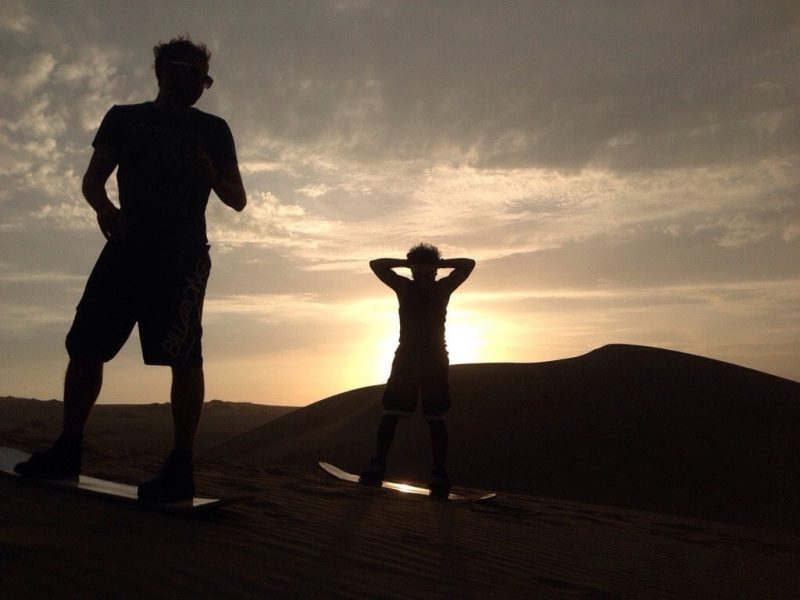
Nazca Lines Flight
6th April 2014
While we were in Huacachina, we also took a day trip to nearby Nazca to witness the famous “Nazca Lines” etched into the desert. Click here to read all about my experiences with the Nazca Lines Flight!
Cusco Shopping, Sightseeing and Massages
9th – 12th April 2014
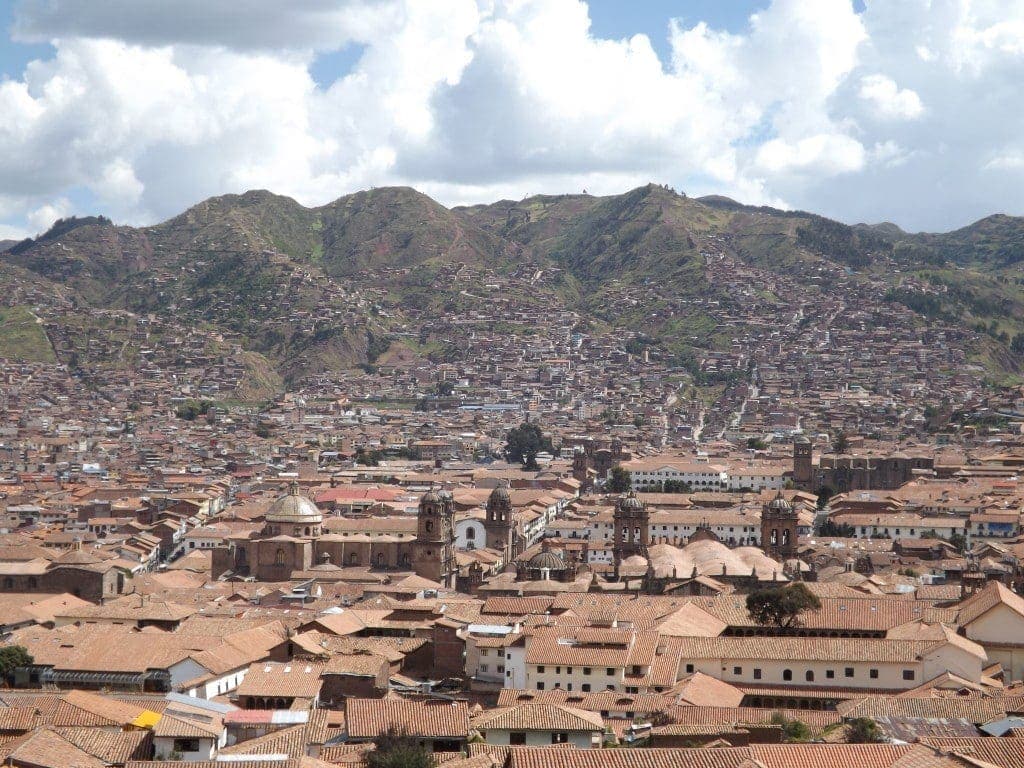
Although it was easily our favourite city in Peru, we didn’t actually do a whole lot in Cusco during our rather long time there (four days on either side of our Machu Pichu trek).
It’s just such a beautiful city, with a lot of history and a really interesting, chilled out vibe, that we fell in love with the place after just half a day.
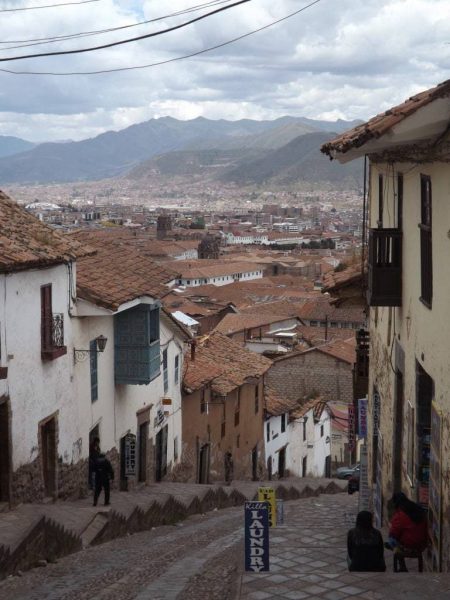
The antique brown buildings and white-washed houses with terracotta roofs of the historic centre are all surrounded by green mountains, with forests and ridges that catch the golden sunlight.
Cusco’s only downside is the altitude. At 3,400m (11,200 ft) above sea level it was the highest place we’d visited so far, and for the first few days, it completely knocked me out.
In fact, after weeks of being in the Andes (I’m writing this from La Paz, which is even higher), I’m still finding myself feeling a little sick at times, and my body is hopelessly weak and tired – a single flight of stairs leaves me out of breath for several minutes.
On our first day in Cusco, we were both feeling a little sick, and I was suffering from headaches, dizziness and general exhaustion, so it was a little overwhelming.
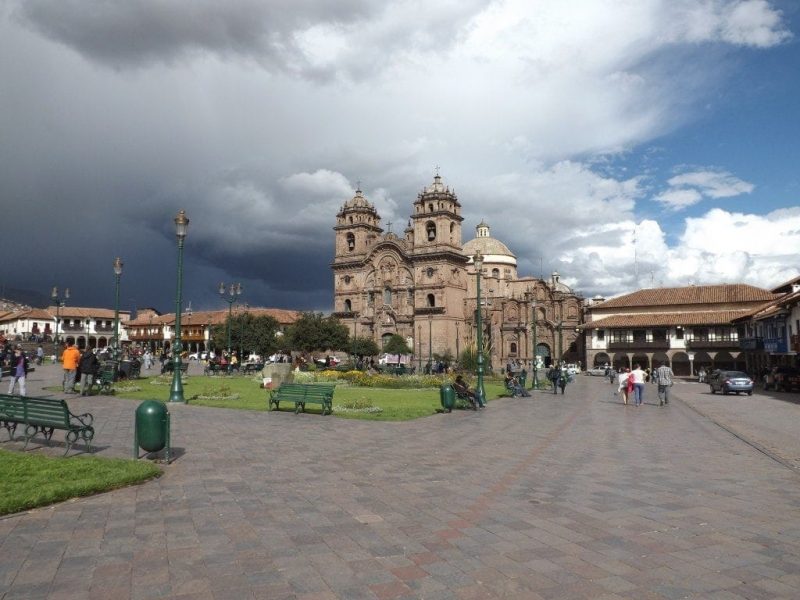
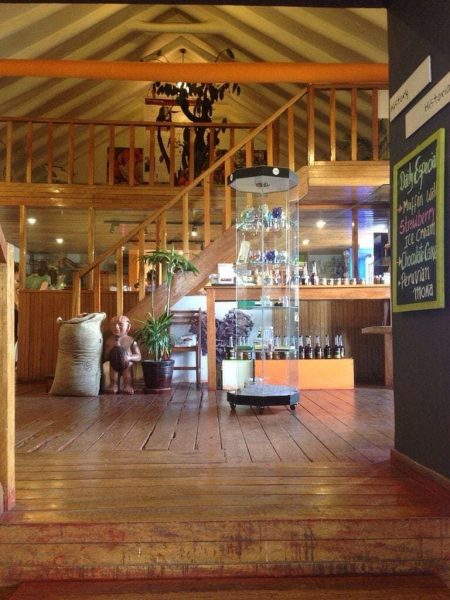
We spent the first day sorting out a few things like shopping and getting Sam a new immigration card (word of advice – don’t lose or throw away your immigration card, it is so much hassle!).
As well as all the outdoor gear we needed to pick up (with pretty good bargains on North Face products to be found everywhere), there are loads of awesome souvenirs on sale in Cusco, and we spent a few hours browsing the various shops around the plaza and the huge artisan market on the Avenida del Sol; where I picked up some really cool trainers decked out with colourful, Andean material to replace the ones which had been destroyed by the heat and sand in Huacachina!
We also discovered what was easily my highlight of Cusco; the Chocolate Museum. More of a gorgeous cafe featuring exhibitions all about the history and production of chocolate, this was the perfect place to wait for the heavy afternoon rain to stop, and after learning everything there is to know about my favourite food, we sat down in the cafe to enjoy a delicious hot chocolate.
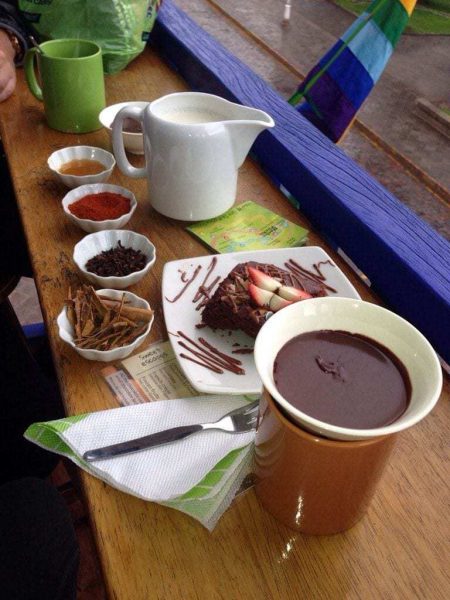
The ‘make your own’ Mayan hot chocolate came with a pot of melted chocolate paste, a jug of hot milk, and pots of chilli powder and honey – and the finished product was absolutely delicious.
By the evening, we were so tired that we could only manage a bowl of soup and a mildly delirious chat with a couple we met at our hostel, before crawling into bed for an early night. Luckily, on the second day things had improved slightly, so we headed out for a spot of sightseeing.
We walked around the Plaza de Armas that we’d seen the day before – now spending more time appreciating the ornately carved brown buildings of the cathedral and the Jesuit church, and the central fountain with it’s glinting gold statue of Inca King Pachacuteq – and up into the San Blas neighbourhood of narrow streets and antique buildings. Apart from a daily shower of afternoon rain, the weather was gorgeous; clear blue skies and baking hot sun, which made the city even more beautiful.
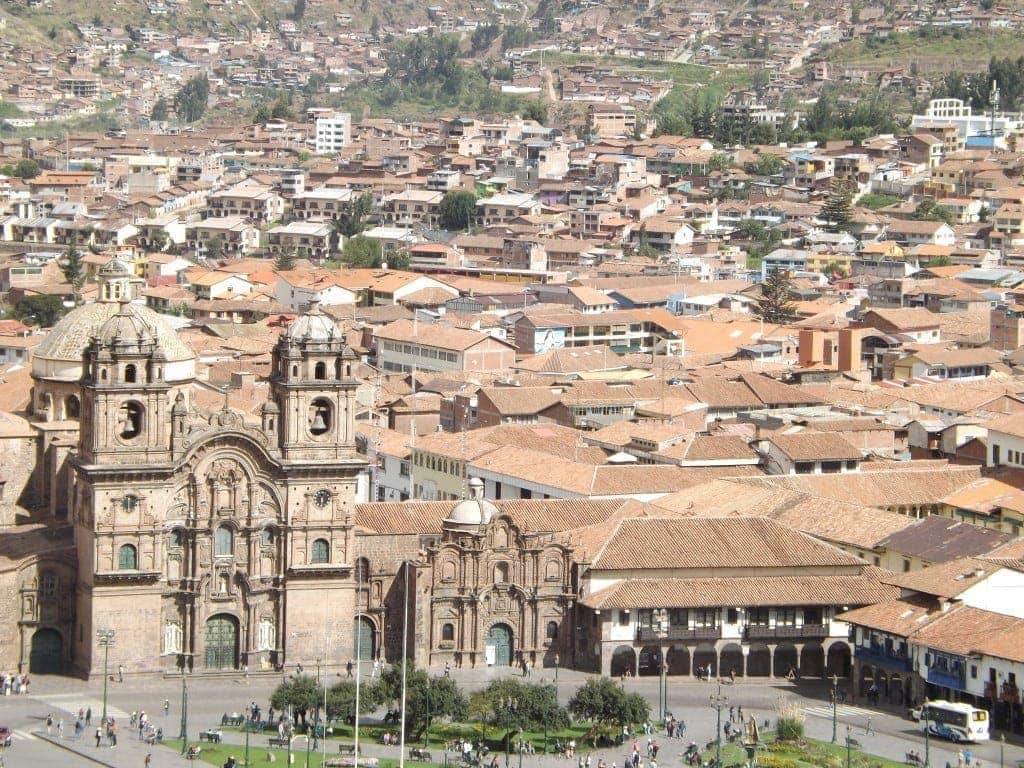
One of the friends we’ve made on our travels, Ben, told us recently that he’s trying to find the cheapest massage in South America. On our second day in Cusco, I’m pretty certain I finished Ben’s job for him.
Thanks to our Inti discount cards – which we got free with Peru Hop – we were able to get 33% off an hour long, full body massage at Nusta Wasi Massage, making it just s./20 each or about £4!
As soon as we saw the discount listed on the Inti Card website, we headed straight out to seek out this ridiculous bargain. Finding the place was easier said than done; like many of the cheaper massage parlours in Cusco, this one was not in an official spa, but instead was in a small room at the back of a market on Calle Inca Roca, advertised only by a small poster on the street. But, eventually we found the place, handed over our S./40, and hopped up onto the massage tables.
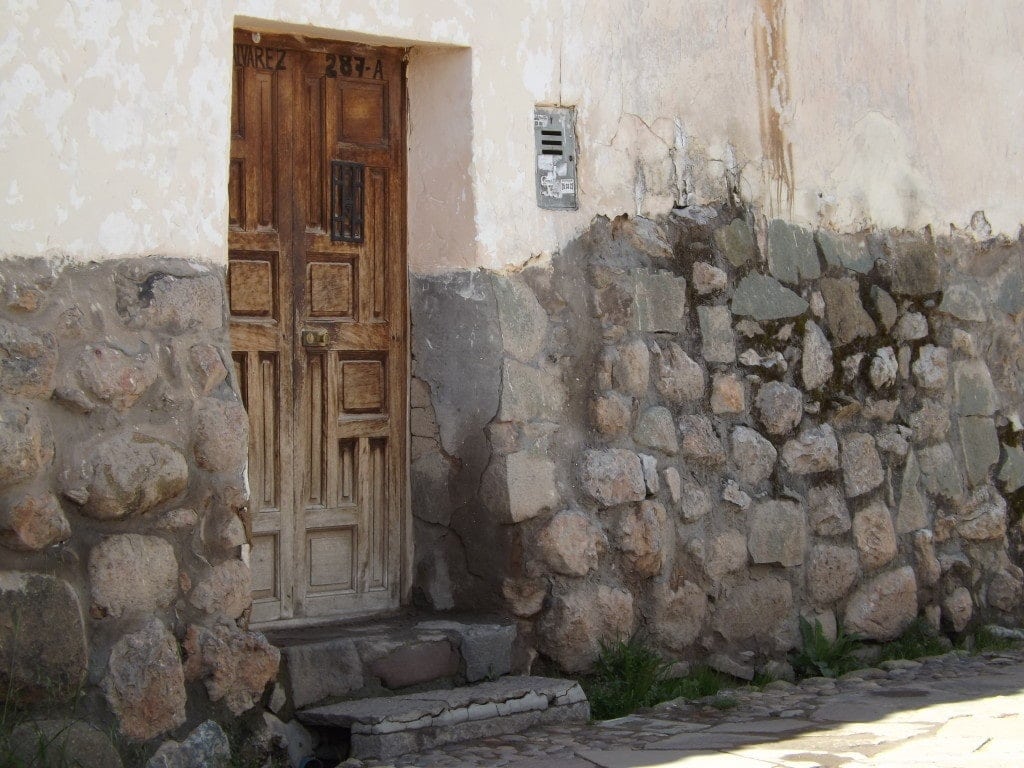
Ok, so in terms of ambience, this wasn’t the world’s most relaxing the massage. For one thing, the girl doing me was about four foot tall, and had to sit on the massage table in order to reach my back. For another, Sam’s masseur had her daughter with her, a three-year-old who would not sit still, ran around the room gabbling to herself (despite repeated desperate requests to “shh” from her mother), and occasionally prodded at both our hands, which were sticking off the beds.
But, those minor distractions aside, the massage itself was incredible. After numerous tumbles during my attempts at sandboarding in Huacachina, not to mention the twenty-six hours we’d spent getting from there to Cusco by bus, my body was in dire need of some intense TLC.
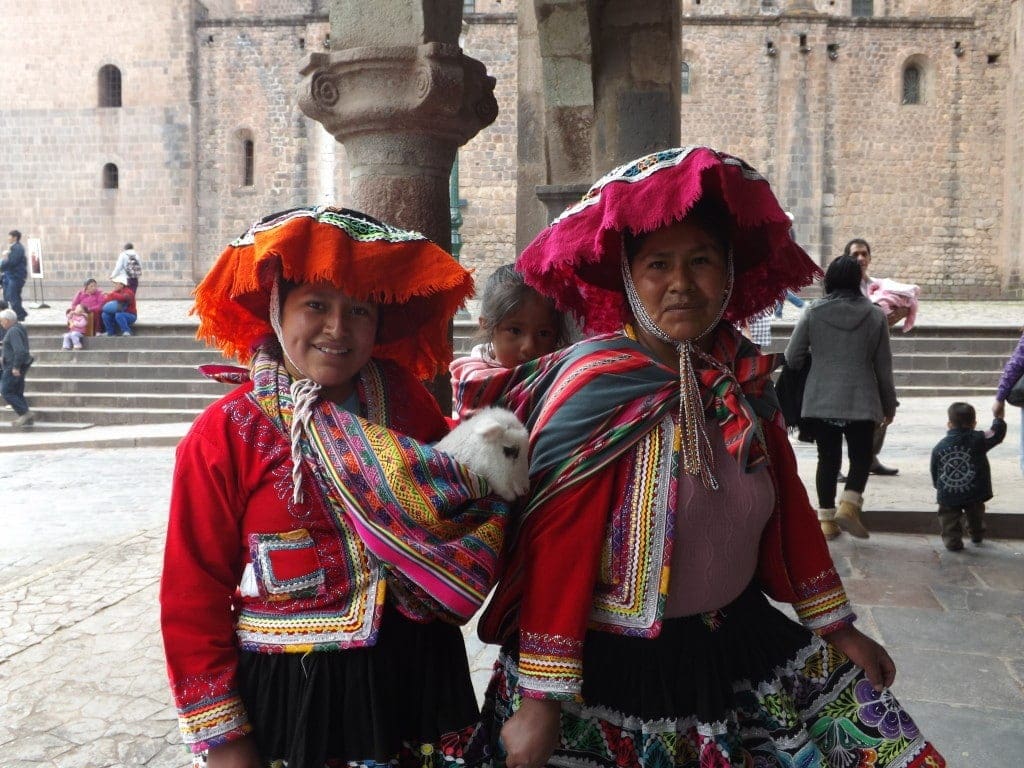
The massage, a mixture of shiatsu, Thai and traditional Inca techniques (according to the masseur – I’m not expert enough to know the difference), was intense, super relaxing, and very thorough: face, hair, hands, toes, shoulders, and bum cheeks, not a bit of me was missed!
After the massages, we tumbled out of the market place feeling meltingly sleepy, and had no choice but to head back to the Chocolate Museum for another hot chocolate; we simply couldn’t do anything less relaxing!
Two days in Cusco, and we’d only managed to eat and drink chocolate, get massages, and buy ourselves souvenirs. But, after several weeks on the road, this kind of relaxation was exactly enough to make us fall head over heals for Cusco!
Inca Jungle Trek to Machu Picchu
13th – 16th April 2014
From Cusco, we headed out on the four-day Inca Jungle Trek to Machu Picchu. This is the “fun” alternative to the Inca Trail: there is some trekking involved, but very minimal.
Instead, you travel by bus from Cusco to Aguas Calientes (the town at the base of Machu Picchu) – stopping off for a variety of activities along the way. The trip involved white water rafting, mountain biking, zip-lining, and a night spent in a jungle lodge. Click here to read my post all about the Inca Jungle Trek.
Machu Picchu
16th April 2014
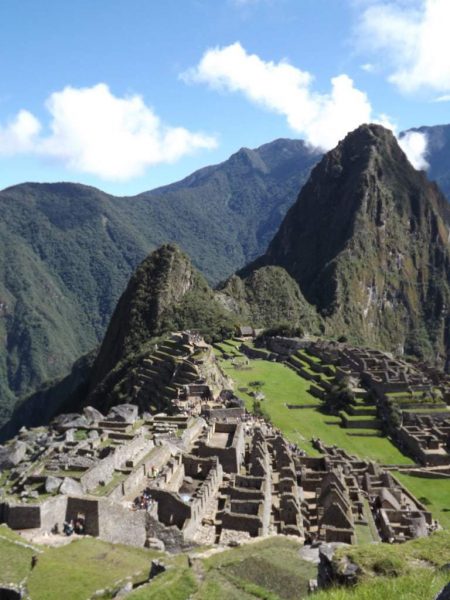
After three days of biking, rafting, trekking, zip lining and generally challenging myself at every corner, the day had finally arrived and we were going up to Machu Picchu. We started at 4am, and after an unbroken eight-hour sleep (thanks to three of the most tiring days of my life), getting up that early wasn’t actually as hard as it sounds.
At half-four, we walked out into the darkness of a sleeping Aguas Calientes, overlooked by huge, shadowy mountains wrapped in low, misty clouds, and reached the long queue at the checkpoint. Everything was glowing with the artificial orange light of nighttime towns, and the crown hummed quietly with a strained excitement, lending my memory of it a surreal, dreamlike sense of suspended reality.
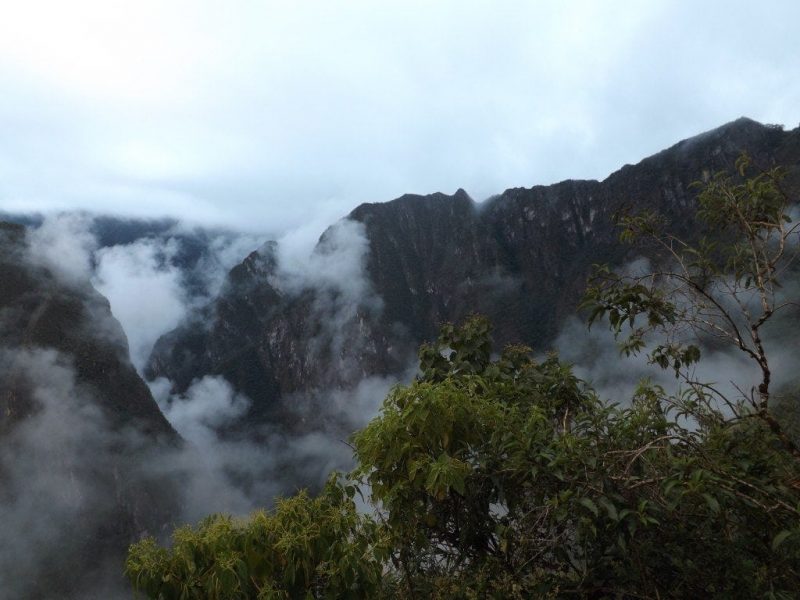
We got through the checkpoint at 5:25am and set off on the climb. The old Inca trail of 1,700 uneven, rocky steps, worn smooth by centuries of footsteps, cuts through the winding bus road and heads straight, and painfully steeply, up the mountain.
The narrow staircase has become something of a traveller’s rite of passage, giving us all the right to scorn anyone who uses the bus, and rightly so; although maybe not a challenge for everyone, that climb up is one of the toughest things I’ve ever done.
The staircase is steep, each step is a different height, and the route seems to go on endlessly upwards through a dark green forest. Thankfully, the clean morning air was cool and fresh, and the darkness grew steadily lighter as we approached the top, until we were walking in pale grey dawn light.
Every muscle in my body seemed stretched, my ankles already stiff from three days walking, and I ploughed ever, ever up; chest heaving, wheezing, drenched in sweat, but still pressing onwards.
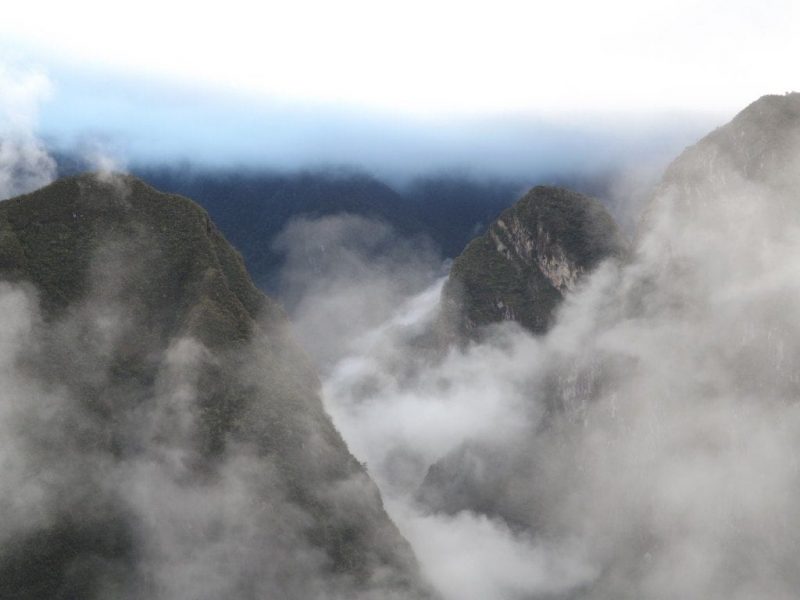
It was a real challenge for me, but I managed the whole climb without a word of complaint. My chest bursting, my legs screaming, but a smile on my face, laughing and joking and ploughing forward.
Thinking we still had twenty or thirty minutes of walking left, we rounded a corner and saw our guide, Heberth, stood just above us with his arms outstretched: we’d made it! I raced up the last stretch of steps as fast as possible, whooping, panting, and completely elated. Arriving at 6:10, we’d managed the climb in a really good time, considering that the average is an hour.
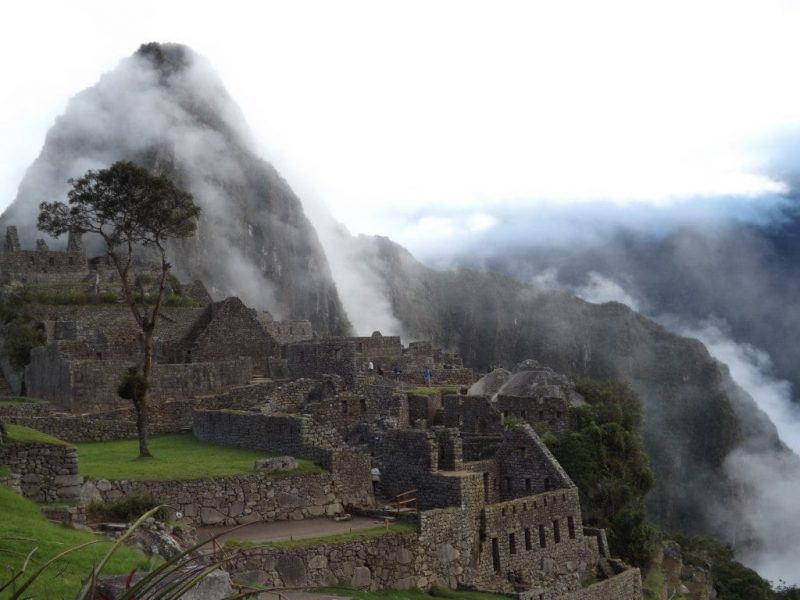
After a quick wash, a splash of deodorant and a change of clothes in the toilets, we were ready to head into Machu Picchu itself; our reward for the climb. Through the entrance, around the edge of the hill, and up still more steps, there it was. Just like all the photos but bigger, more impressive and more staggeringly beautiful than I’d ever expected.
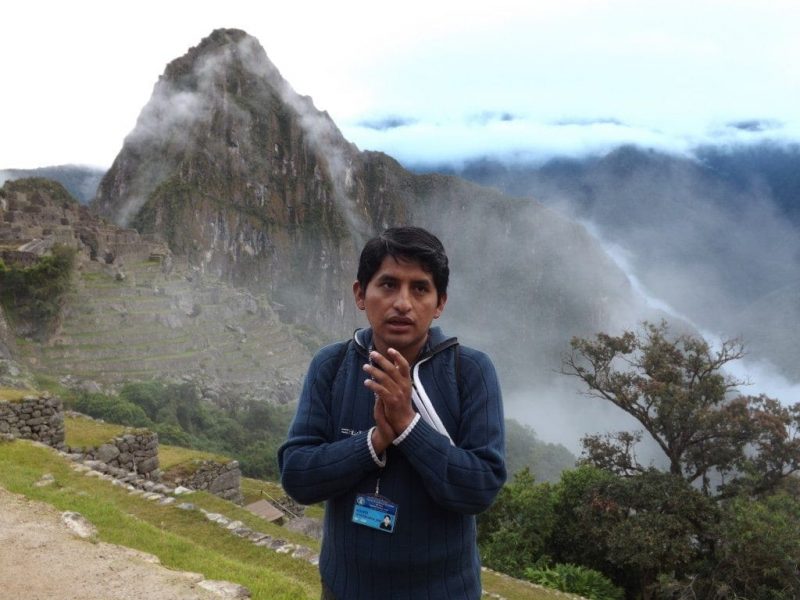
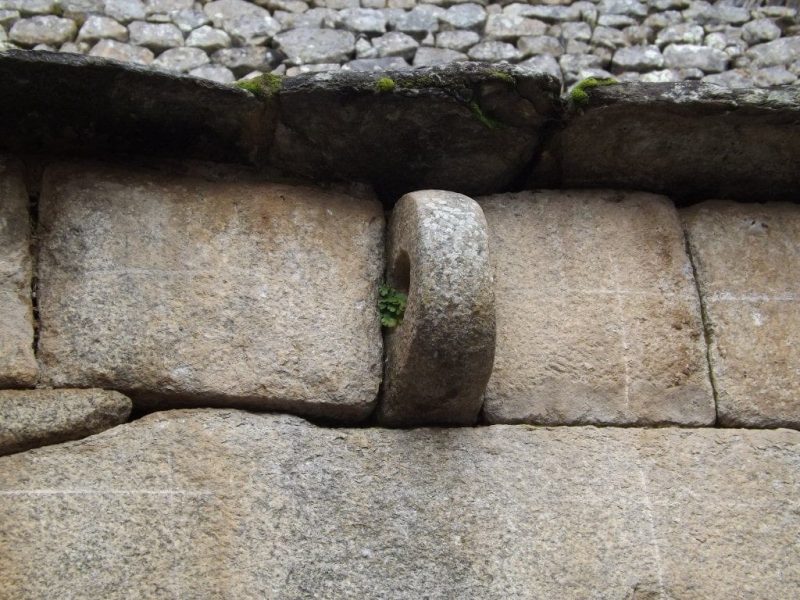
Heberth gave us a tour of the site, starting in the step-like terraces near the entrance which were used to create varying micro-climates for agriculture. Although the tour took two hours, I was so excited to have finally made it that it seemed to go in a blur.
We headed into the temple district, where the Temple del Sol has much neater, smoother brickwork than any of the other buildings, and explored all the stone passages and rooms. Heberth showed us how the doors hinged at the top, from chunky stone rings, rather than the sides, and how inside an Inca house there would have been no tables, so instead there are niches in the wall for storing items and eating.
Random facts have stuck out of the massive amounts of information he poured out to us, like the fact that the Inca prince would have had fifty or sixty wives, but most of it was unfortunately lost in favour of the staggering views and general elation at being in Machu Picchu!
I found the Temple of the Condor – with its huge, carved rocks that look like wings – and the school of astronomy – where two pools of water were used to reflect the stars and study constellations – particularly interesting. But after that I’m afraid I more or less stopped listening!
The whole city was drenched in a thick, clinging mist that slowly settled with the dawn, so that the sky was grey and smoky and we couldn’t see the opposite mountains, or even the watchman’s hut at the top of the city. The mist made the Inca ruins seem all the more dramatic and mysterious, completely stealing my attention from Heberth’s fascinating tour, so that all I could do was look around me and take hundreds of photos.
By the time we reached the quarry, an area of uncut granite rocks towards the back of the city, the mist had begun to clear again, revealing the dark green mountains in front of us. Behind us, the sky was bright blue already, and we could see as far as the Humantay glacier in the distance, glowing white in the brightening sun. We were really lucky; according to Heberth it’s not usually clear enough to see the glacier, and even the week before it had been so cloudy all day that he could hardly see Machu Picchu!
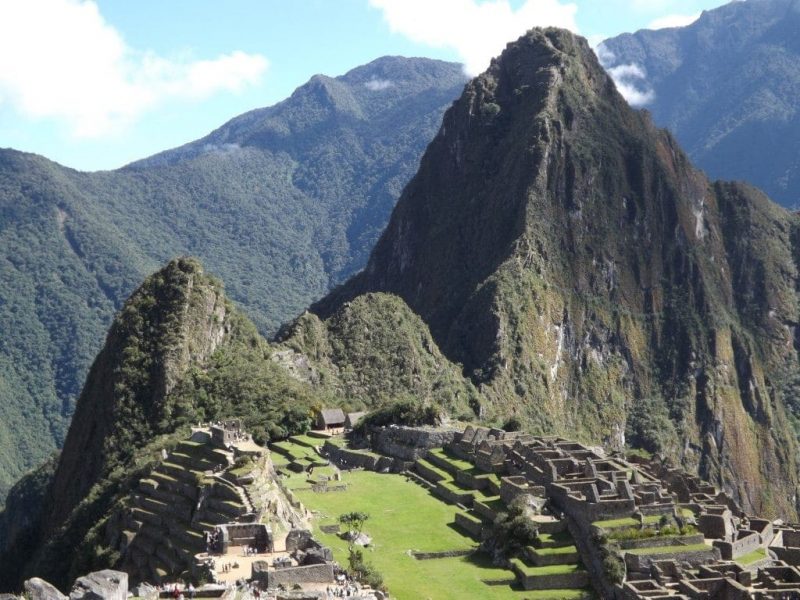
Once the tour was over, finishing at the Sacred Rock – which is either the shape of Machu Picchu Mountain, or a giant guinea pig, depending on who you believe – we said goodbye to Heberth, and found ourselves free to enjoy a now incredibly sunny Machu Picchu as we pleased.
We walked up to the Watchman’s Hut to soak in the quintessential view of Machu Picchu, with Huayna Picchu Mountain in the background, and take the ‘classic’ photo of the city.
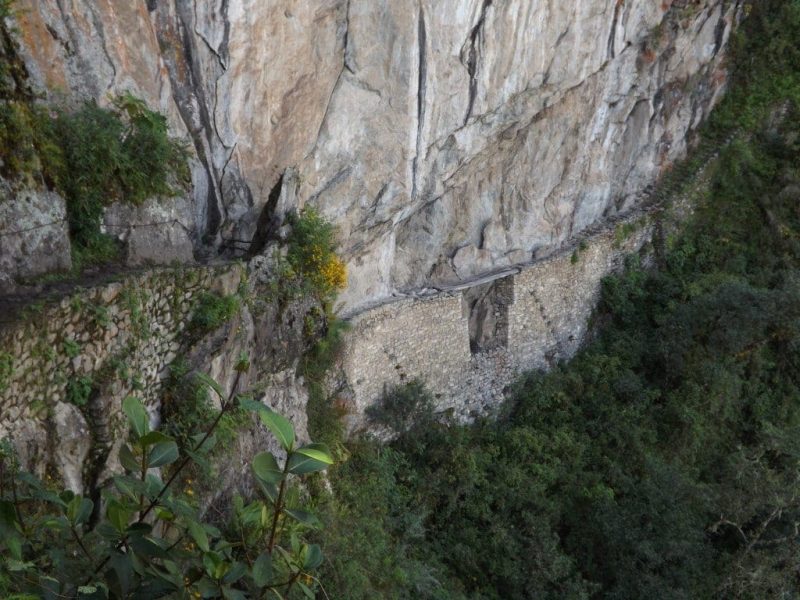
After a long sit in the sun, lapping up the unendingly impressive views and recovering from the morning’s climb, we headed off to Inca Bridge. The walk, along a shady, leafy cliffside path round the back of Machu Picchu, was a really pleasant one past colourful flowers and gorgeous views towards the Hydro Electrico, and ended abruptly at the bridge.
This is essentially some thin wooden planks set across a gap in the narrow rock path that hugs the cliffside, hanging over a horrible drop. It was all I could do to walk down the path that leads to the bridge, so I have no idea how any Inca, no matter how well-balanced, was able to cross it!
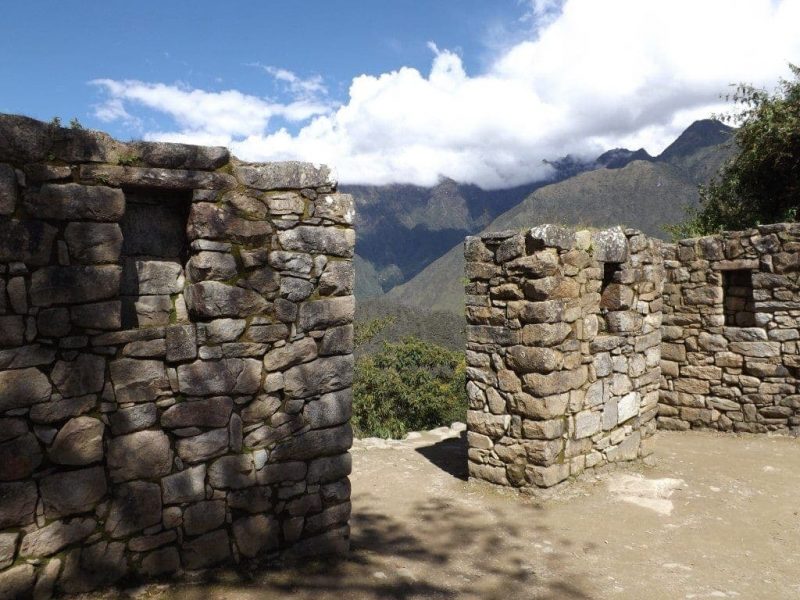
The Inca Bridge itself might not have been particularly impressive, tucked away out the back of Machu Picchu, but the walk was a nice one. Better still was the walk to the Sun Gate, or Intipunchu, except that the sun by now was so hot that it made the not particularly strenuous walk pretty difficult!
The thirty-minute hike in the blistering heat, up and down still more rocky steps, was completely worth it, though.
The view from the sungate is incredible; not only can you see across the whole city of Machu Picchu in the distance to Huayna Picchu, but you can also see the towering heights of Machu Picchu mountain on the left, and all the way down the mountain we’d climbed that morning to the river next to Aguas Calientes.
The view from this vantage point really brought home how high we’d climbed, the river we’d crossed at 5am that morning was a tiny ribbon below us, glinting in the sunlight.
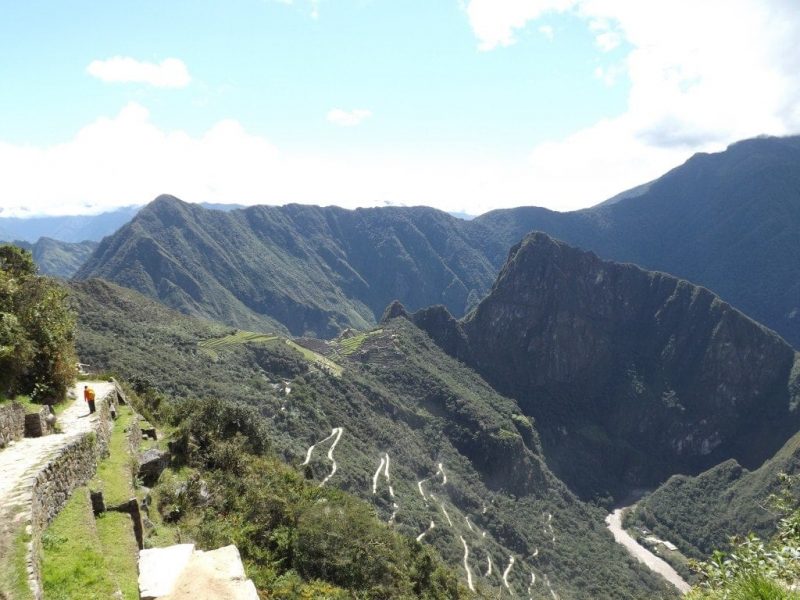
I sat in front of the Sun Gate for ages, staring at the gorgeous view and savouring the sense of achievement, the unfamiliar and delicious feeling of self-pride.
My legs were dangling over the edge, the sun hot on my face but the breeze cool, my feet heavy and my legs tired, my whole body aching from the challenging four days of the trek, and all of it reminded me of exactly how far I’d come and how much I’d achieved in that short time.
I’d faced numerous fears, pushed myself well out of my comfort zone, challenged myself and my fitness a huge amount and come out of it the other side to be faced with this incredible reward. It was perhaps one of the very few profound moments I’ve experienced in my life, and I wanted to relish it.

Eventually, though, we headed back down for one last look at the city before hopping on a bus back to Aguas Calientes, finally too tired to walk any further. We had dinner in town before starting a long and gruelling journey first by train to Ollantaytambo, then bus back to Cusco, arriving at about 11pm almost delirious from exhaustion.
For anyone headed to Machu Picchu, no matter what trek, I don’t recommend a return journey the same night; stay in Aguas Calientes and take the train the next day.
Machu Picchu was one of the biggest highlights of my trip so far. A huge tick for my bucket list, a huge achievement for me, and just a hugely rewarding experience overall. An experience not to be missed!
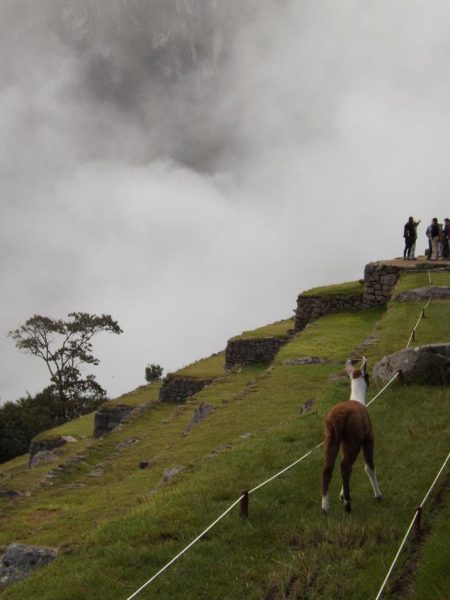
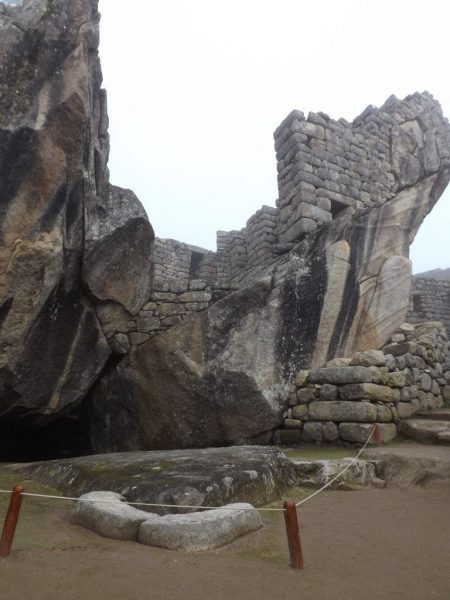
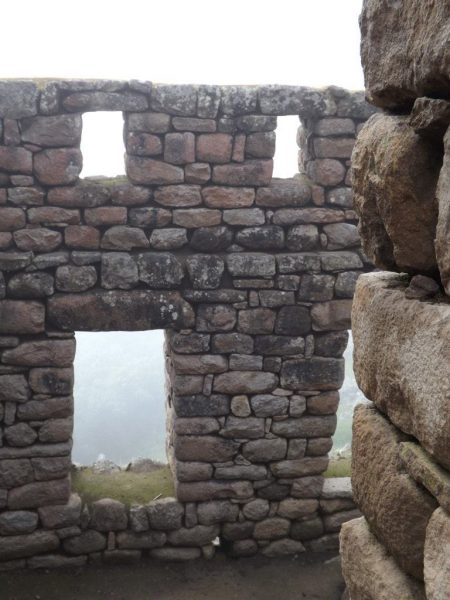
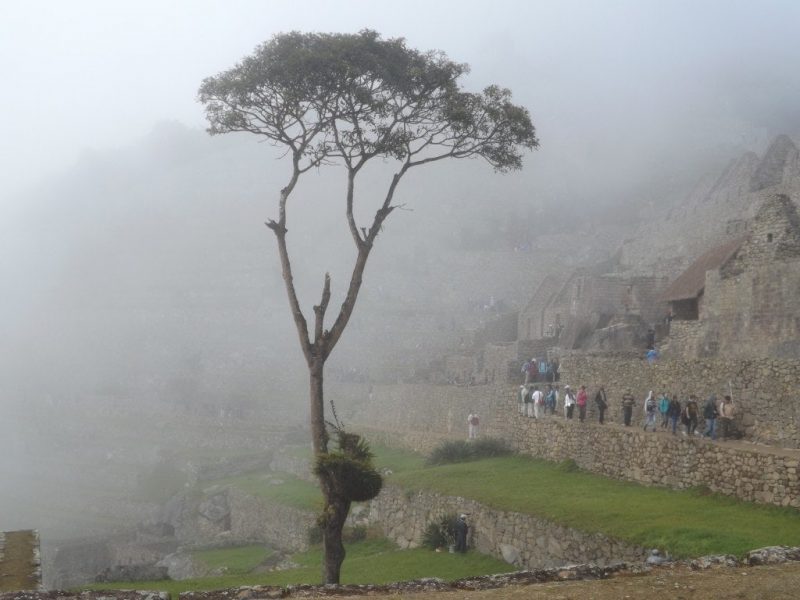
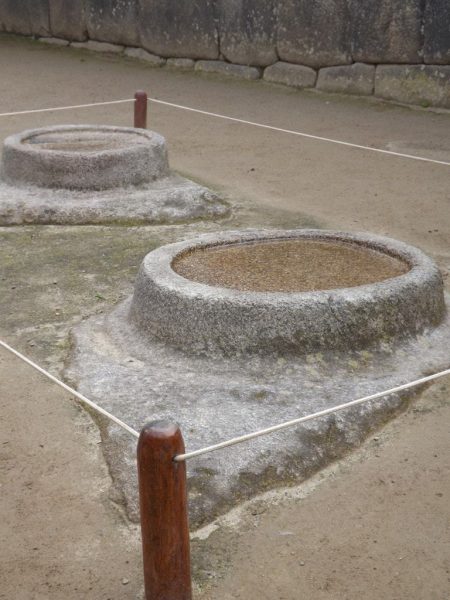
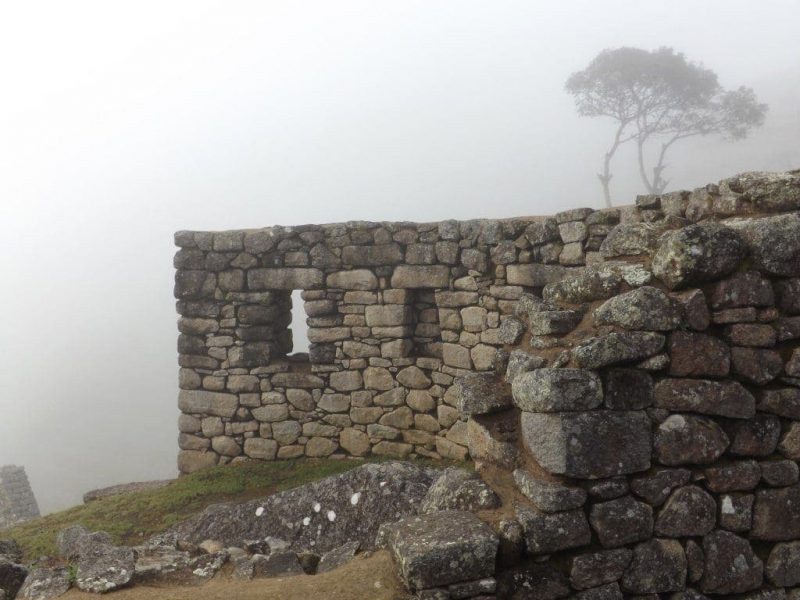
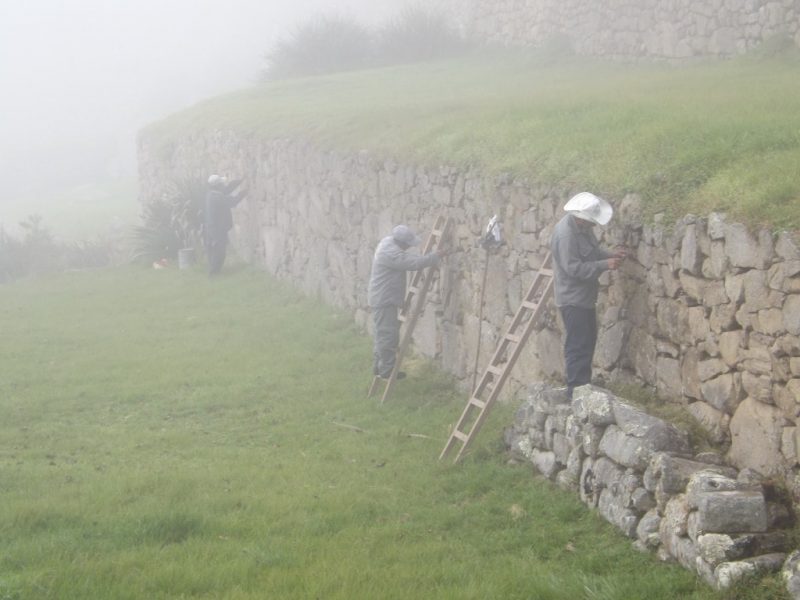
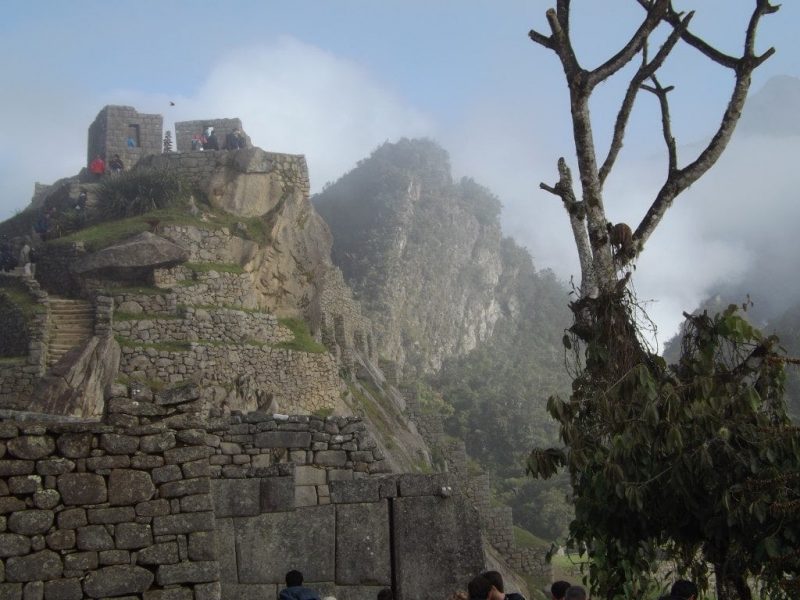
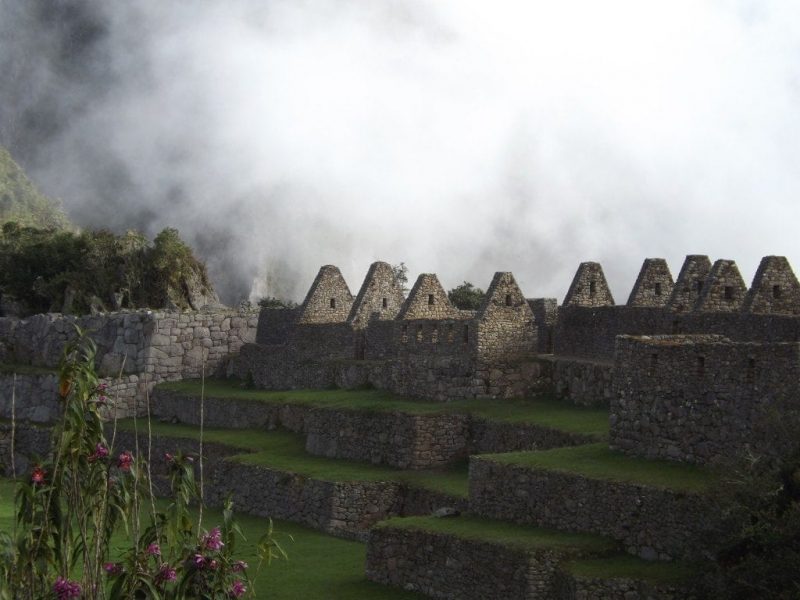
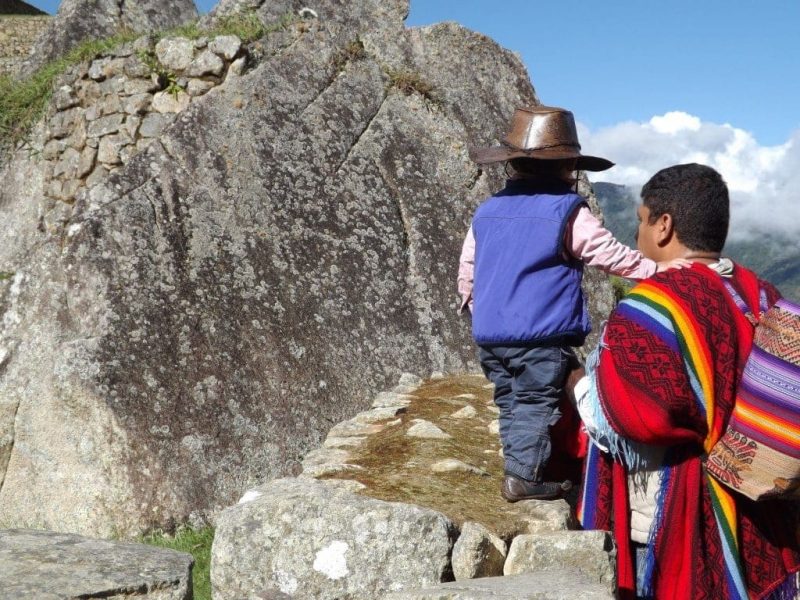
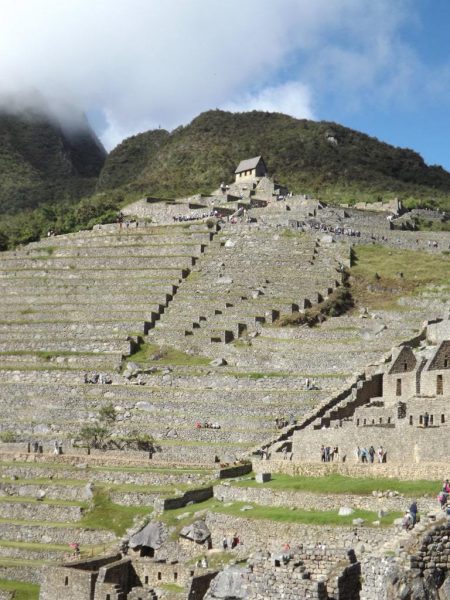
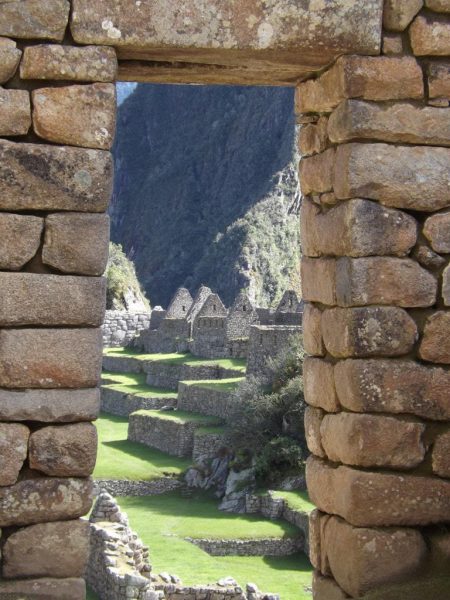
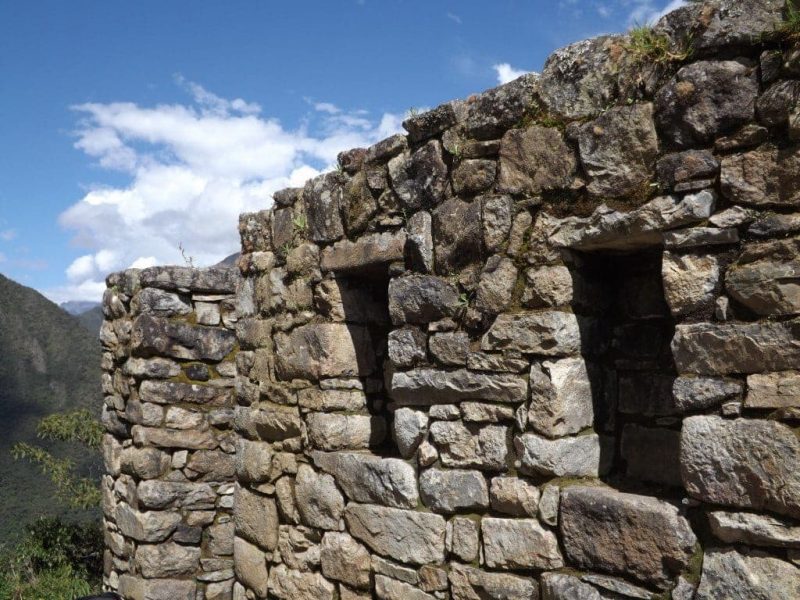

Free Walking Tour Cusco
18th April 2014
One of our last activities in Cusco was something that we really should have done much sooner, preferably as soon as we arrived, the Free Walking Tour.
It was full of great tips about things to try and places to visit, and would have been a great way to get our bearings early on in the trip. Even so, when we finally got around to doing the tour it was still really interesting and gave us some helpful hints about what to get up to in our last few days.
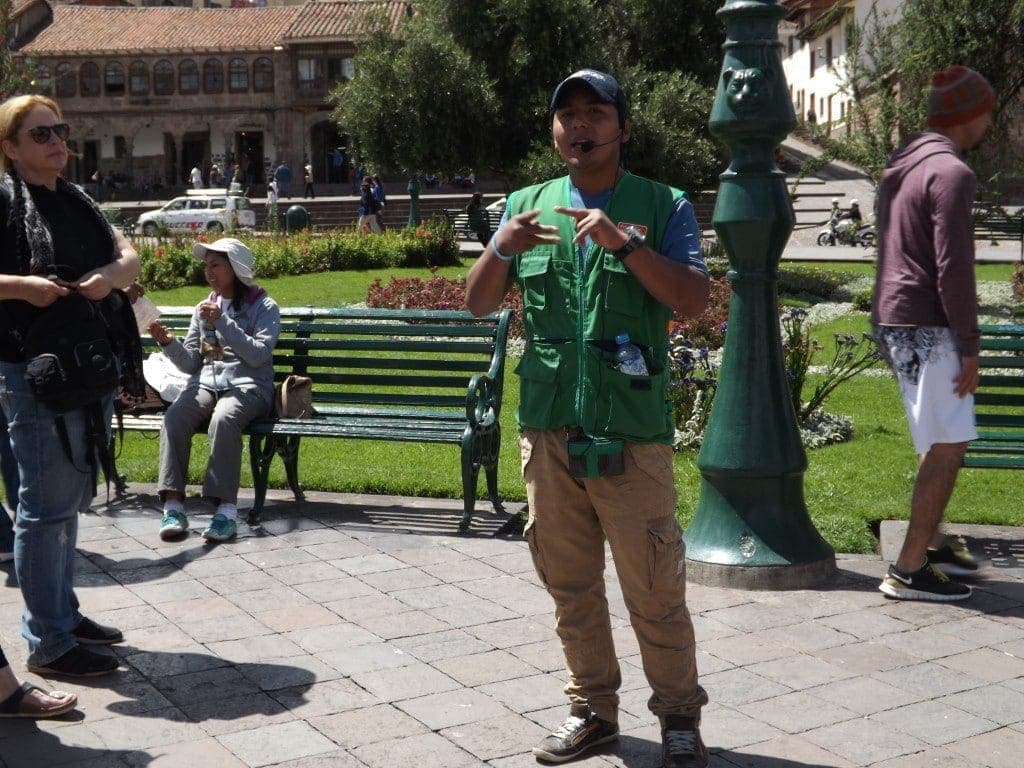
There are a couple of free walking tours on offer in Cusco, but the one I’m talking about (and the one I recommend all visitors to Cusco opt for) is run by Free Walking Tour Peru (FWT).
They meet in the Plaza Regocijo near the main square at 11:50am every day, and the guides can be spotted by their green FWT vests and caps.
READ MORE: Tips for Dealing with Altitude Sickness in Cusco, Peru and the Andes!
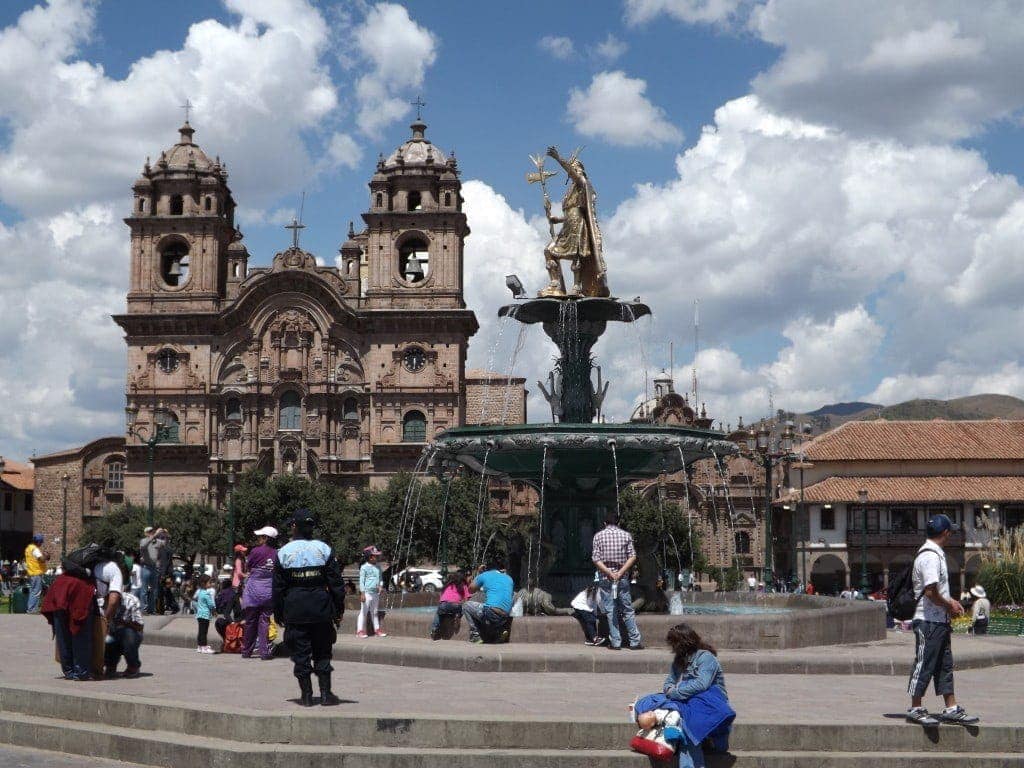
FWT are a really professional free tour company, and our two guides even had microphone headsets to ensure we could all hear them. The lead guide, Johnny (“as in Johnny Depp because I think I look like him”), was really funny and enthusiastic, and led most of the tour with a ton of interesting facts mixed with some quick humour. His partner was also really friendly, and although he didn’t speak as much he made sure to chat to everyone in the group in between stops.
Our first stop was in a nearby restaurant, where our big group of about twenty crammed in around four tables, to try some of the local dish – alpaca. The restaurant provide a different plate of samples everyday, and we were lucky enough to try some of the rich, beef-like meat in a delicious mushroom sauce.
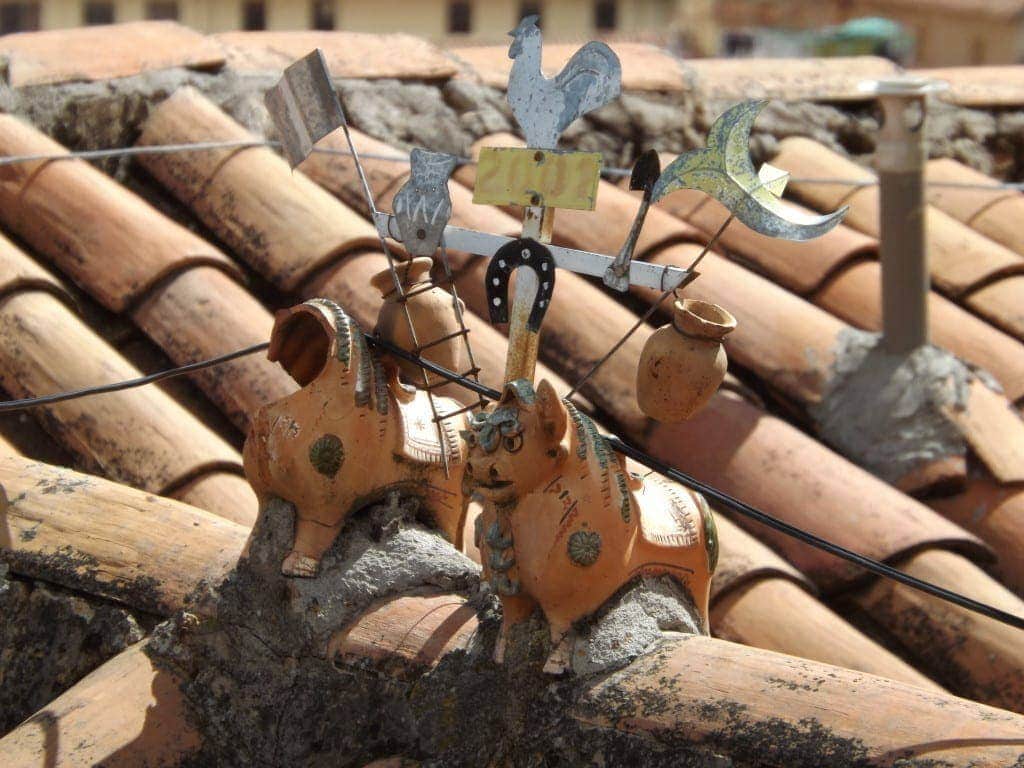
From there, we headed to the Plaza de Armas, the main square of Cusco’s historic downtown area, which has a pretty interesting history. It used to be a sacred spot for the Incas when Cusco was Qosqo, their capital, so they built nothing there and surrounded the spot with temples. When the Spanish turned up, they turned it into a plaza for commerce, and built the cathedral and a Jesuit church where the temples used to be.
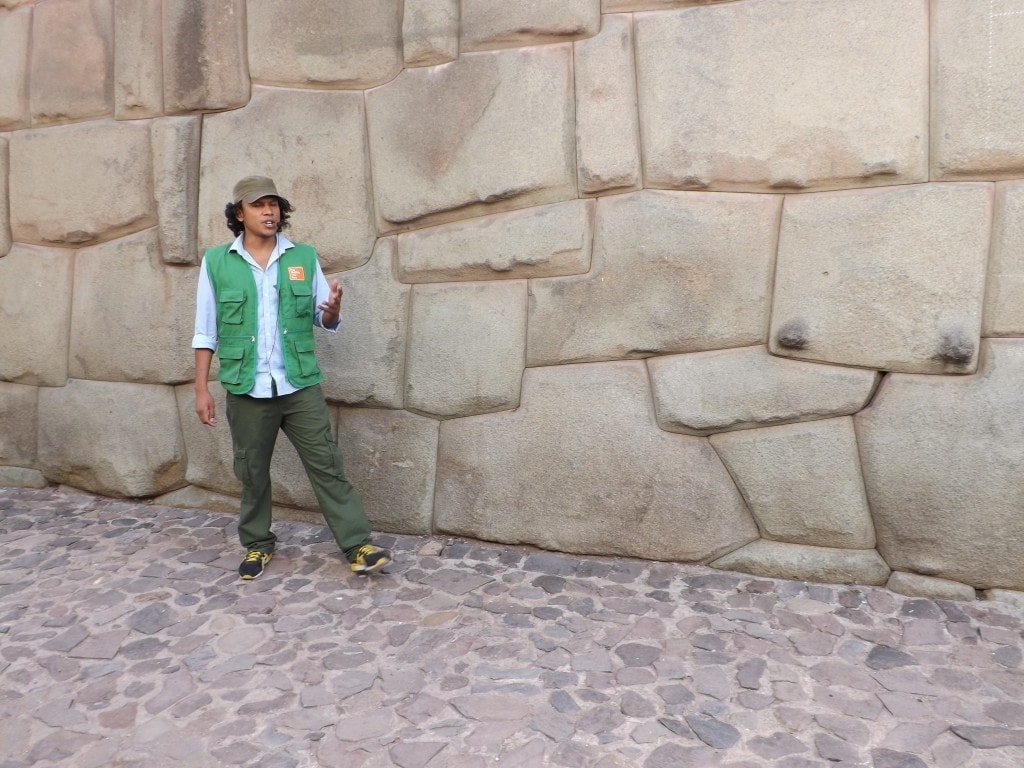
A few of Cusco’s buildings are half-colonial, half-Inca, from where the Spanish built over or into the existing buildings, and we stopped at a great example of this, the Inca Roca next to the market behind the main plaza. The lower half of the building’s outer wall is Inca, built from huge, uneven stones that slot together like a jigsaw.
There are the shapes of the three sacred animals built into the stonework on the back wall, the snake representing the earth and underworld, where we all came from, a jaguar representing our time on earth, and a condor representing the afterlife. Johnny told us all about the Inca building techniques; how foundations were laid using sand (provided by the Chan Chan culture after it was taken over by the Incas) and small rocks, to absorb movement and help the building withstand earthquakes. All the walls incline inwards slightly as well, to make the movement during quakes predictable.
The rocks were cut using a type of wood which is very absorbent; a small incision is made in the rock, the wood inserted, and water added everyday so that the wood expands and eventually splits the rock. Rocks were then carved to match one another, using moulds made from molten copper. Each brick took thirteen months to make in this way.
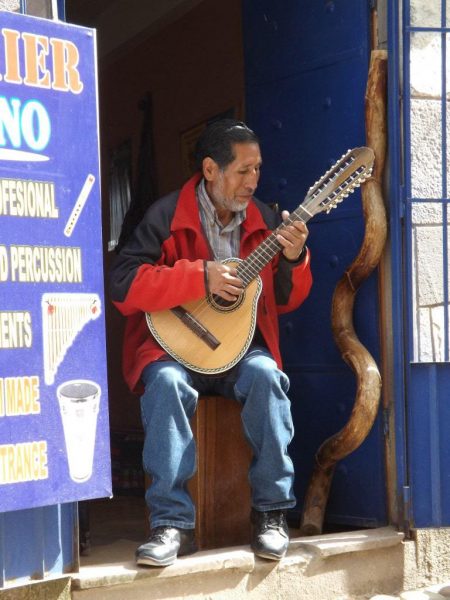
From the fascinating Inca ruins, we headed up into the San Blas neighbourhood, an area of narrow streets and tiny, cool bars which are great for live music almost every night. From a fabulous viewpoint over the city, looking down at a sea of terracotta roofs and whitewashed walls, we headed to Luthier Sabino’s beautiful, hand-made instrument shop, where the owner himself treated us to a few performances on various Andean guitars, and on panpipes.

We headed next to San Cristobal church, a place providing incredible 180 degree views of the city, with a wonderful view straight down to the main plaza and the ornate, red-brown cathedral. The tour finished back at the Chocolate Museum, my favourite haunt in Cusco, where we sampled lots of delicious chocolate! Later that night, we headed back to the San Blas neighbourhood on the recommendation of our guides, and spent a fantastic evening watching a local band play live from a stage so small that only the drummer could fit on it (the others had to stand awkwardly at the edge), in a tiny bar with about four tables. They belted out a number of popular South American songs, along with a very sped up version of Robbie Williams’ Angels for us Brits By the end of the evening, and a large number of mojitos, I was dancing in a conga line with a huge group of Chileans, and heartily joining in the cheer for “uno mas, uno mas”; proof of a very good night, in my opinion!
Three-Day Colca Canyon Trek, Peru
22nd – 24th April 2014
As if the four day Inca Jungle Trek to Machu Picchu hadn’t been enough, as soon as we left Cusco and arrived in beautiful Arequipa, The White City, we booked ourselves another trek, this time to Colca Canyon.
We paid a little higher than our usual backpacker budget, to go with what has to be one of the best tour companies in the city, Colca Trek.
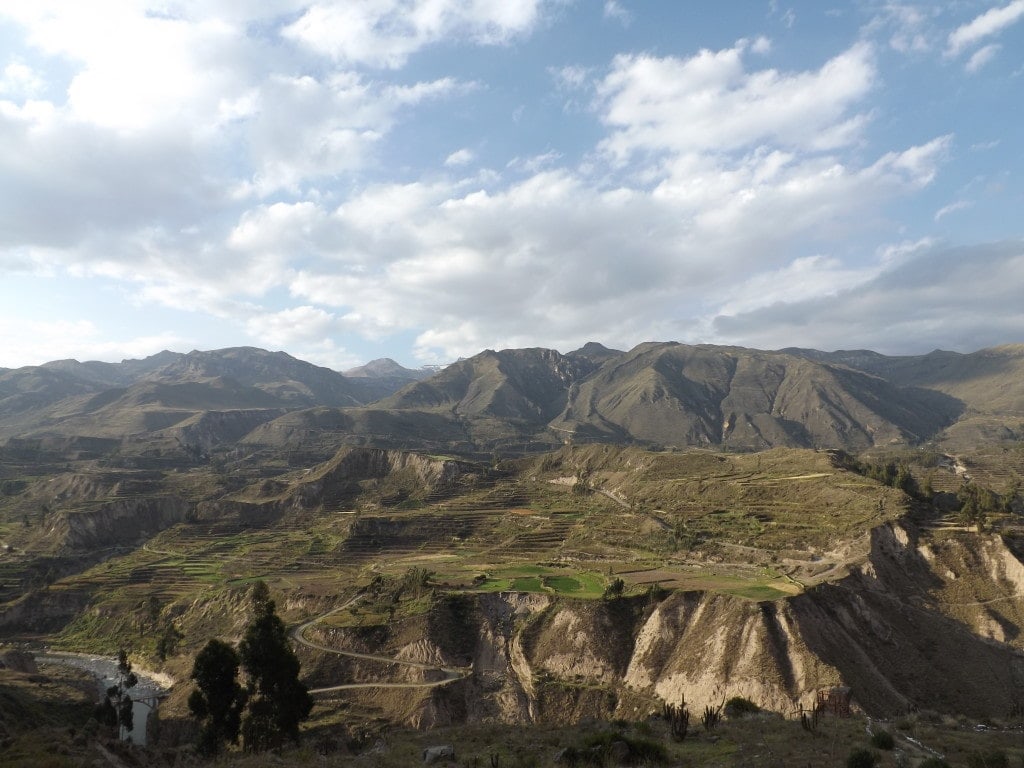
Colca Canyon Trek, Day One
22nd April 2014
We set off just after eight, in a minivan with thirteen other people and our lovely guide. Christian was a local who grew up in one of the villages in Colca. After passing through the ugly, ramshackle outskirts of Arequipa – apparently, the town has expanded rapidly in the last fifteen years due to huge immigration from the mountain and valley towns in search of better jobs and schools – we found ourselves in a strange, post-apocalyptic landscape of dusty cliffs, red clay, cactus and sparse little grey-green bushes.
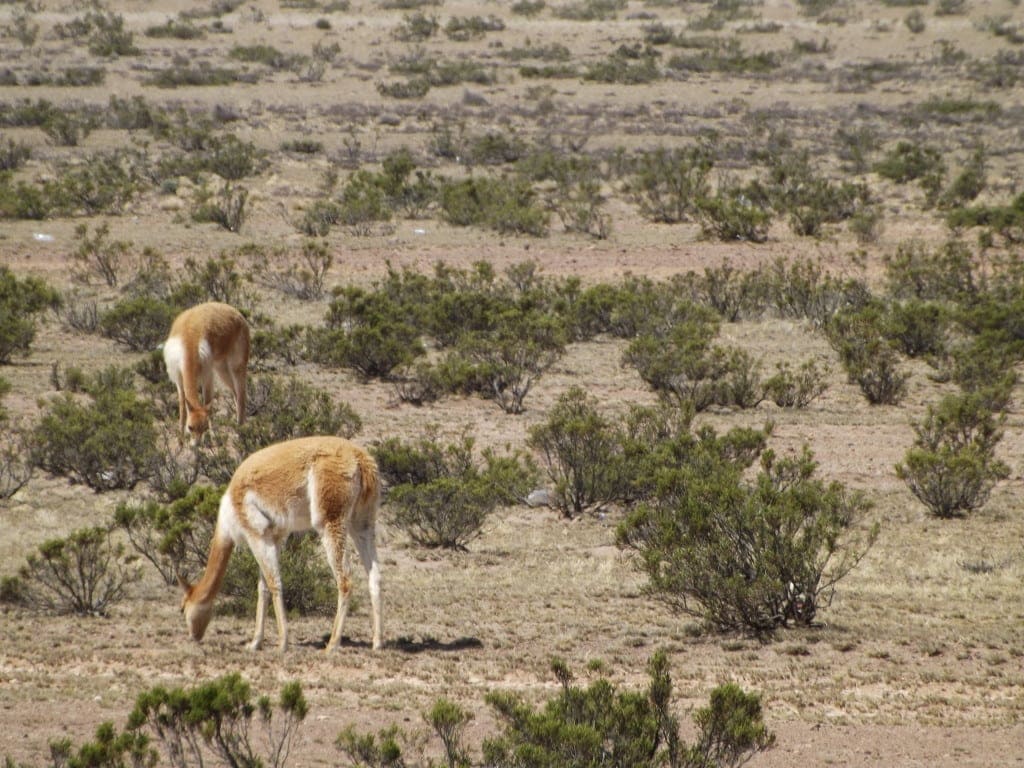
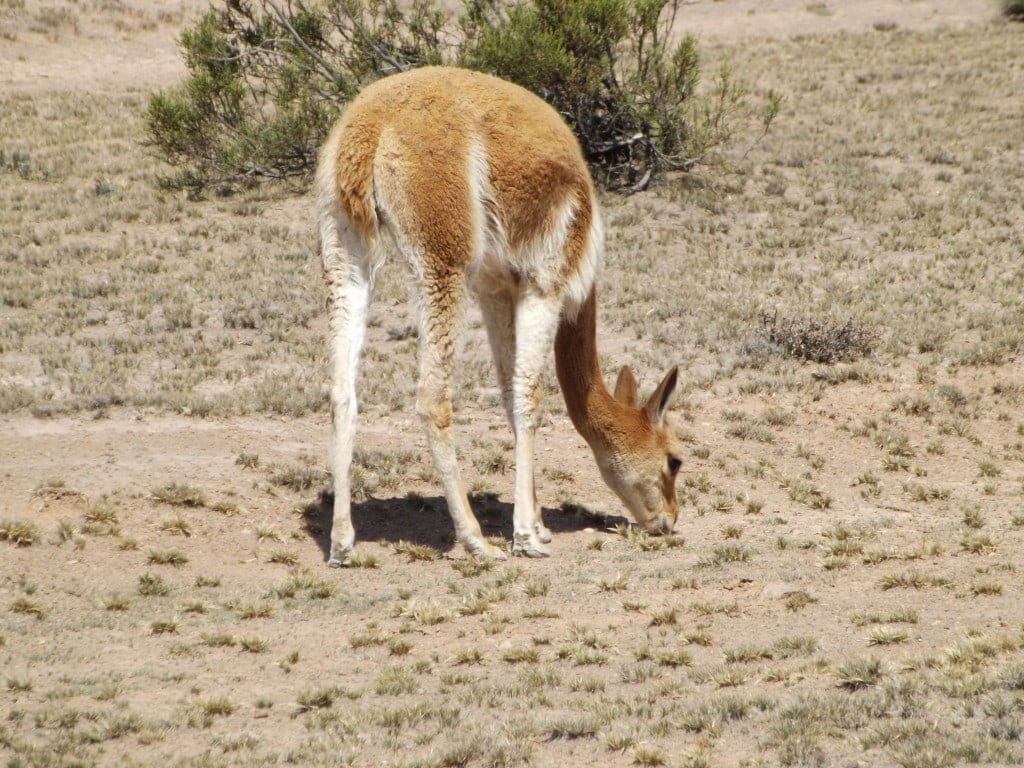
We wound through arid brown hills and rubble-strewn yellow cliffs, then descended into the flat plains of Pampas de Cañihuas national park. Here, we stopped by the side of the road to watch families of vicuñas, from the Andean Camel family and similar to llamas and alpacas, but smaller, daintier and with a uniform orange-brown fur coat with white tummies. Vicuñas, the national animal of Peru, were once near extinction, but are now protected in the park, and it is forbidden to hunt them. The locals still sheer the animals once a year, since the fur is highly prized and worth a lot of money (apparently a vicuña wool jumper will sell for $60,000 in Europe), but the rest of the time the animals are left alone.
After a mini off-road experience, bouncing up and down bumpy dirt tracks, we reached our first stop and stepped out in the middle of the plain, near the mouth of a small canyon, which we walked into after a quick drink of coca tea to help with the altitude. At the start of the canyon is the bizarre Imata Stone Forest, created by weirdly shaped rock formations. Traditionally a sacred place, many local farmers still sacrifice a lama here to Pachamama to request a good year. The rocks, formed by molten lava from the nearby volcanoes, are twisted and warped in strange shapes, sometimes taking on the appearance of animals or faces (as long as a little imagination is used).
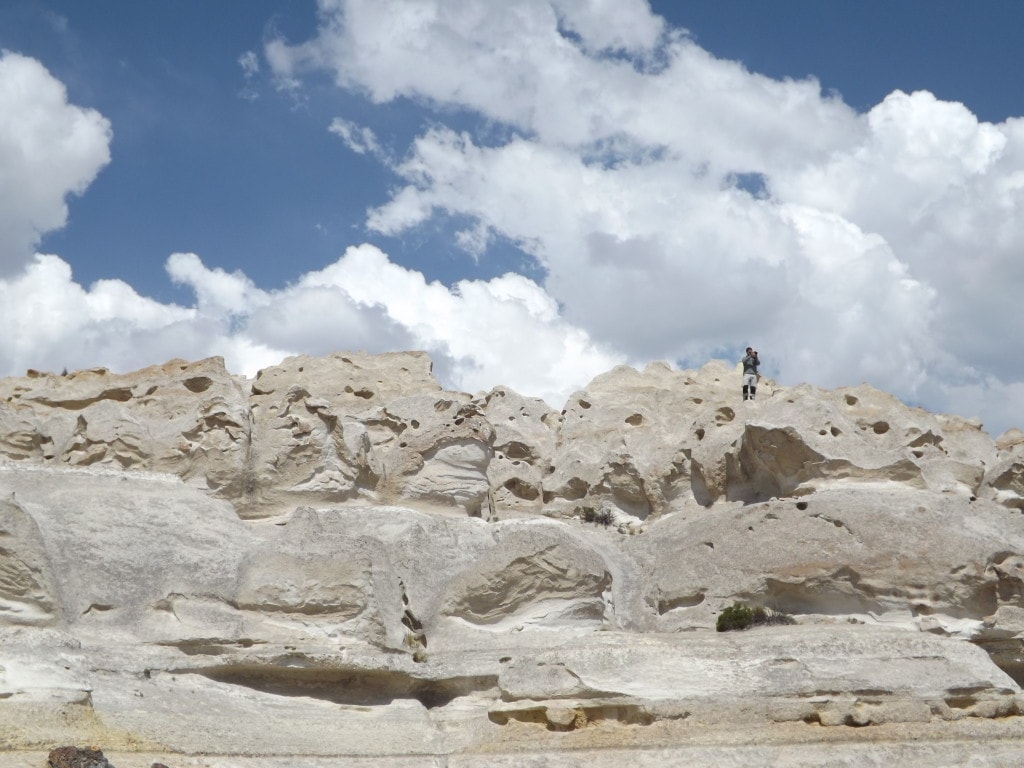
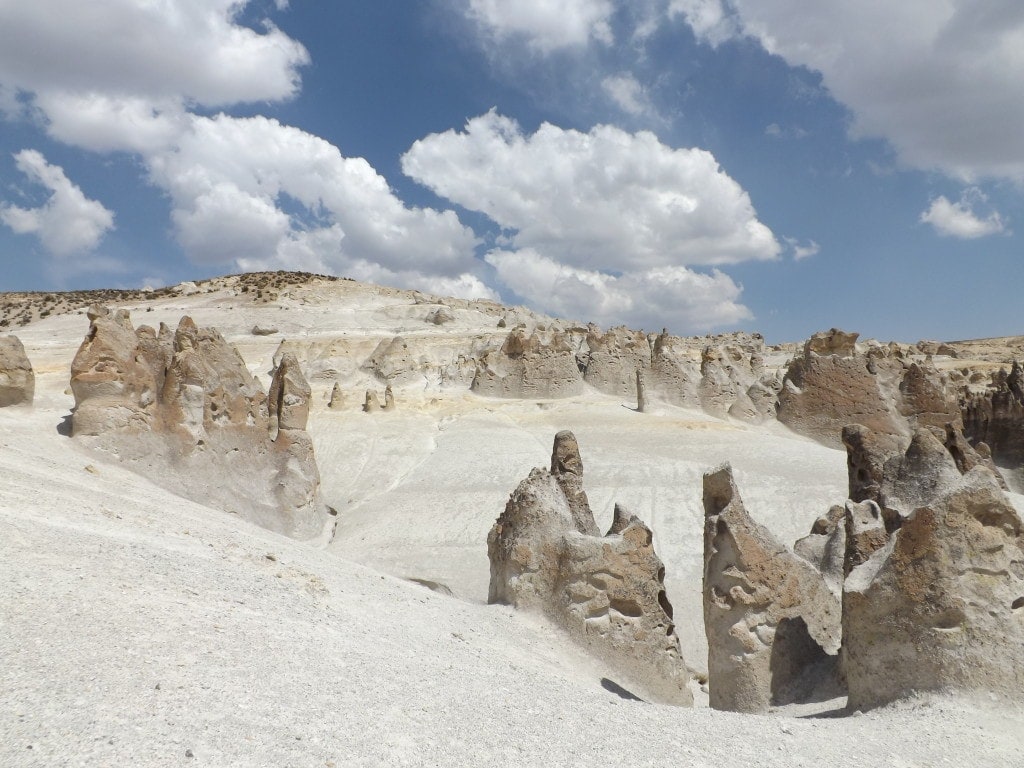
As we drove away from the stone forest, we saw a huge tornado in the distance, like a tunnel of dust, which is apparently common in the area. Back on the road, we kept on driving through the huge, empty plain, sparsely covered by small, green clumps of grass and sweeping away on either side, huge and flat and stretching, brown and beige under an enormous, empty sky, overlooked in the distance by the silent forms of white-capped mountains and the brooding, grey El Misti Volcano. We stopped a few more times to look at enormous herds of alpacas and llamas, with lots of scampering babies, as the breeding season had just ended, and also at a small series of grassy ponds, where we were able to see a family of Andean geese with their tiny, white babies.
Soon, we were climbing again into rocky mountains, with the sky turning grey and cold as we ascended. We stopped again at the Mirador de Los Andes, a lookout point at 4910m above sea level with a view of the seven surrounding volcanoes, most of which are snow-capped and many of which are still active, including Misti Volcano which can sometimes be seen smoking.
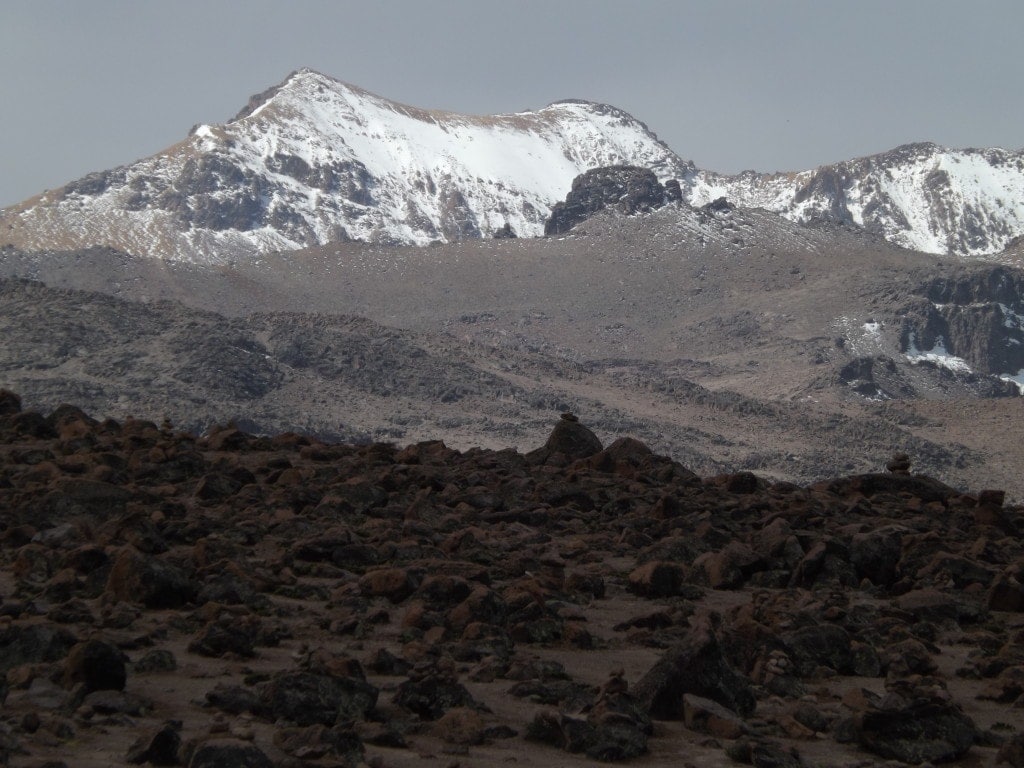
Outside the van it was freezing cold, a surprising contrast with the hot sunshine we’d been stood in just half an hour before, and I felt sorry for the women selling souvenirs at the side of the road, huddled over in the wind.
Our final stop en route to Colca Valley was to view some samples of the llareta plant, one of the slowest growing species of plant. Like a big green rock made up of tiny, hard leaves, a big clump like the one we saw would have taken thousands of years to grow. It secretes an oily sap which smells like aloe vera, and is one of the strangest plants I’ve ever seen.
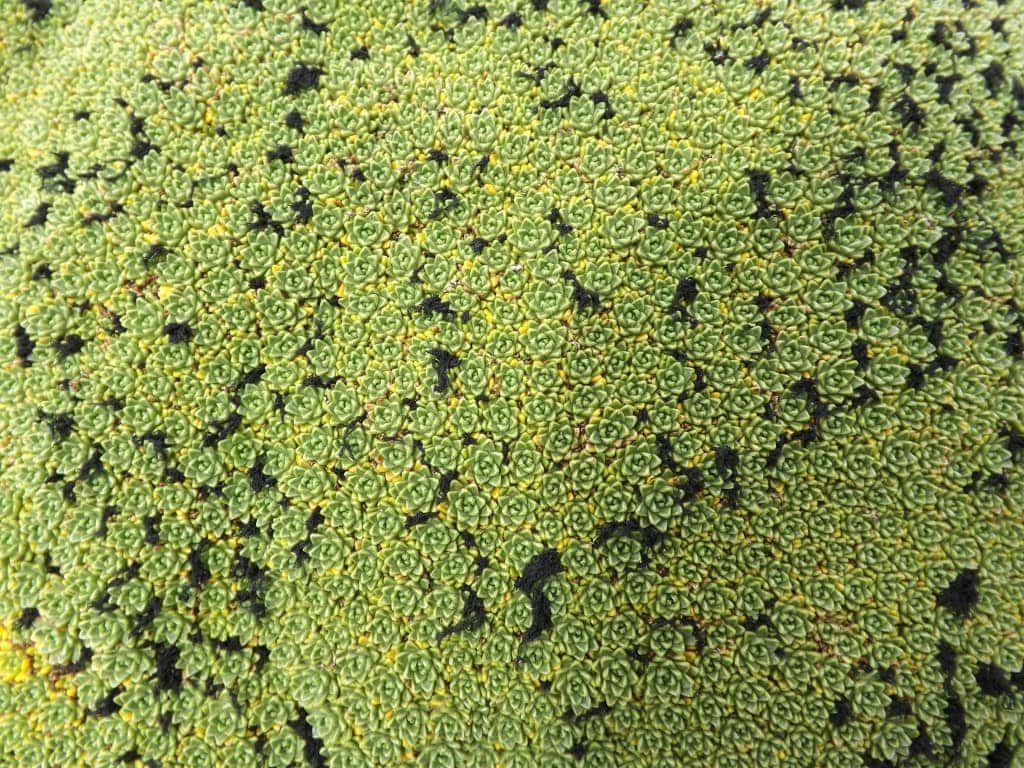
We stopped in Colca Valley for a buffet lunch, with lots of tasty alpaca dishes, and then headed on into the valley, where we stopped frequently to take in the incredible views. Colca has 70% of all Peru’s Inca and pre-Inca terraces, and 90% of them were made by the Wari culture, one of the earliest civilisations in Peru, and were used to create micro-climates for cultivation. The result is a valley that looks like a 3D puzzle, laced with ruffles of thin terraces built from uneven stone, like neat steps, with the floor of the valley coated in a patchwork of tiny, hedge-lined fields of different shapes and colours: bright green, dark emerald, yellow, brown, beige.

There were more Inca structures in the cliff alongside the road above the valley. Small holes carved into the yellow cliff-side, these were essentially ‘Inca fridges’ used to preserve food, and are the Colcas for which the area is named. There was also a tomb, the small entrance smeared with red iron oxide which was considered sacred, the blood of Pachamama (mother earth).
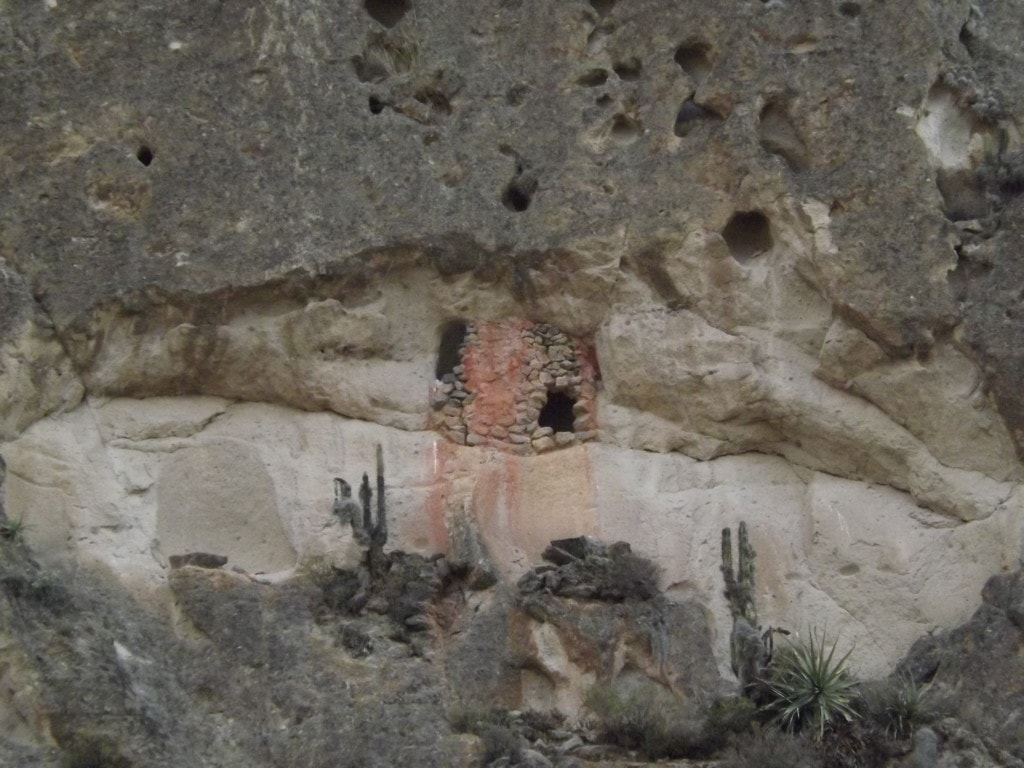
We sat on the edge of a lookout point over the valley as the sunset, while Christian talked about the towns and the surrounding area of the valley, especially about the discovery of Juanita, the body of a young girl preserved by the ice found in the glacier of Mount Ampato.
There are a few theories surrounding her sacrifice, but the story Christian gave us is that she was raised in a school in Cusco specifically for sacrifice, and was at the age of twelve or so following a volcanic eruption. For two days she would have eaten nothing but coca leaves, and on the third day would have been given chicha (a local drink made from fermented corn), and gotten very drunk. Once she fell asleep, the priests would have placed her body in the foetal position and left her on top of the mountain to freeze to death; the belief was that she needed to be killed by the mountain god rather than the priests, in order to remain pure.
As she was found with a hole in her head and a bit of blood on her face, others believe that the priests did kill her with a blow to the head, but this is unlikely considering other similar sacrificed bodies found in mountains in Chile were without harm; the cut and blood could have been made when her body fell down the mountain after the glacier melted and her body began to thaw.
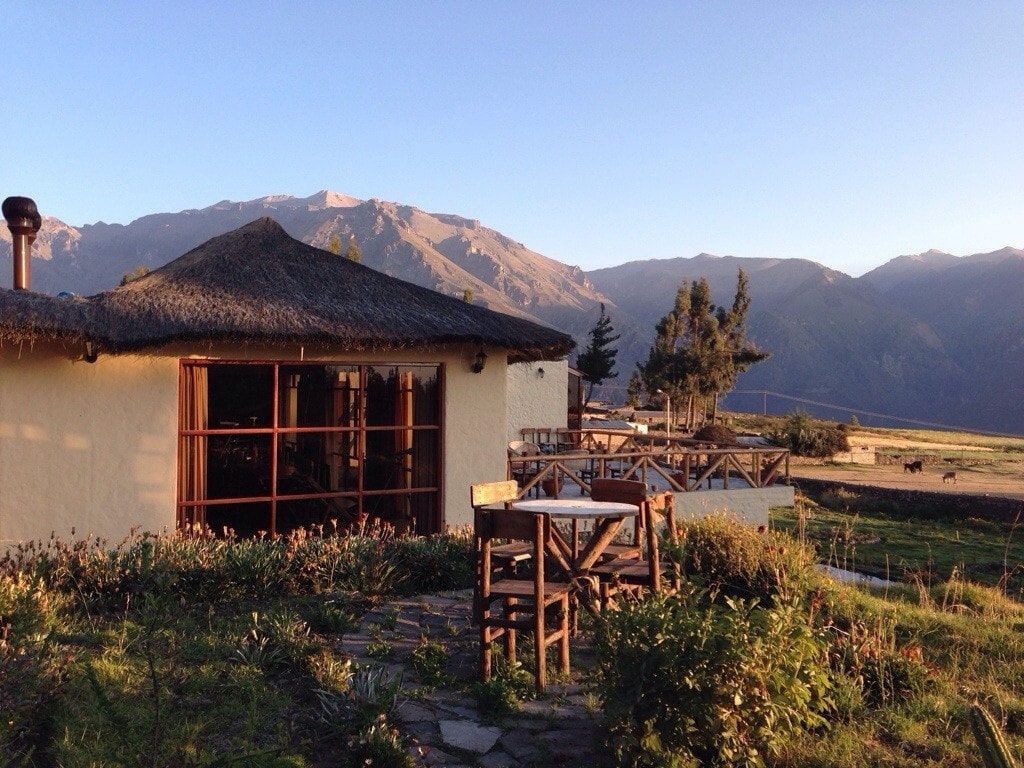
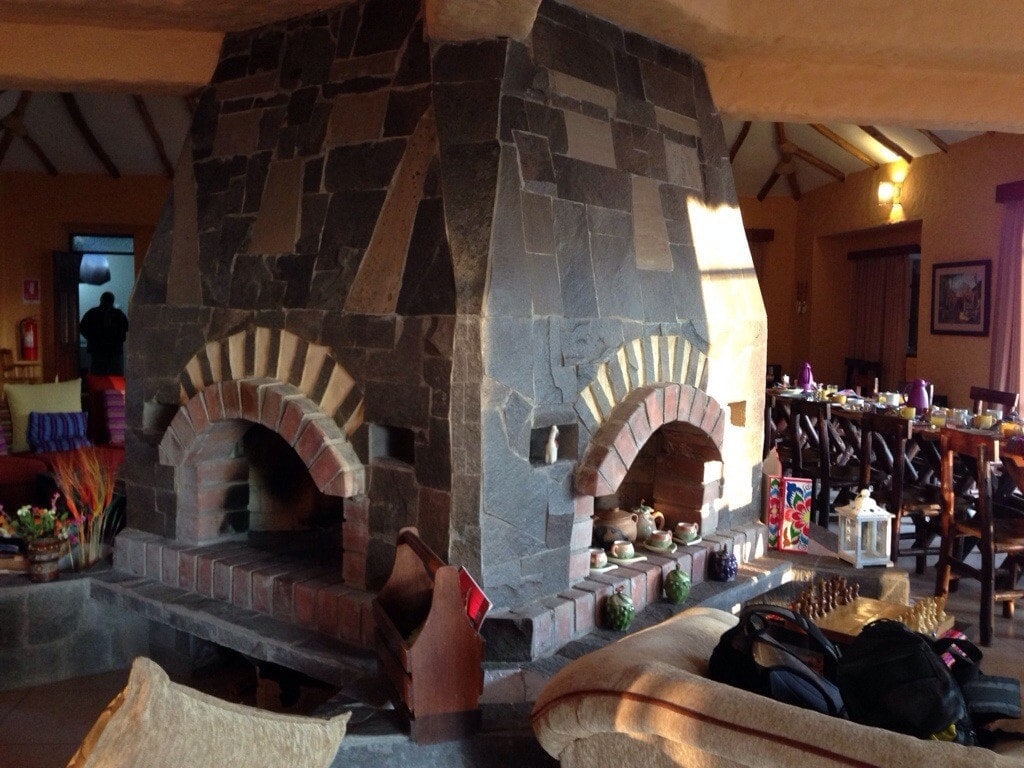
We finished the day at Colca Lodge, the gorgeous accommodation that had sold us the Colca Trek tour above all others. The lodge had a huge, cosy lounge with a big central fireplace, comfy sofas and lots of warm blankets, where we sat and chatted with the rest of our group until dinner. Our rooms had floor to ceiling panoramic windows, overlooking the valley and the white-capped mountains beyond, and the décor throughout the lodge was beautiful; way too good for backpackers.
There wasn’t much time for enjoying the luxury, though, as the next day we had a 5:30am start, so we headed pretty quickly after dinner to our enormous, comfy bed to get straight to sleep.
Colca Canyon Trek, Day Two
23rd April 2014
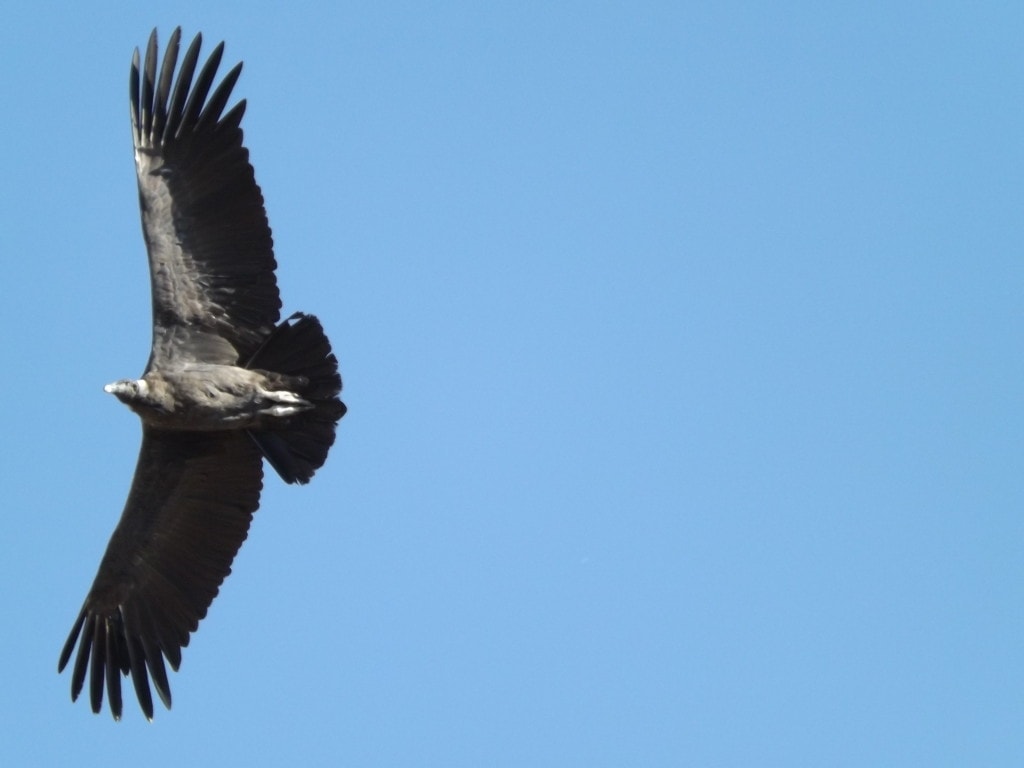
Our second day started early, at 5am when the sun was rising pale and cold over a chilly valley, catching in the soft grey mist over the dewy fields. After a very short drive, we trekked along the valley’s edge in brightening sunshine to the Cruz del Condor, a popular lookout point for early morning condor spotting.
We stopped first just below the mirador, and watched as the birds began to emerge into the canyon. By now the sun was up and the sky was a big, empty expanse of blue, and as we watched the huge birds started to appear below us, difficult to pick out against the brown and orange cliffs of the canyon.
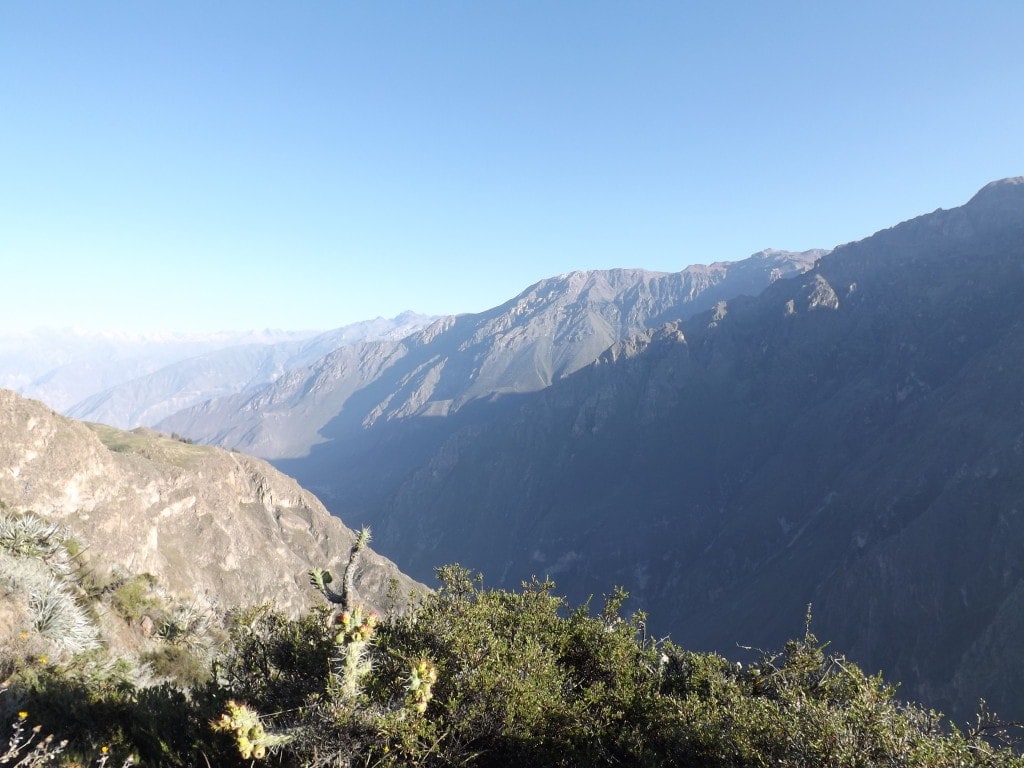
Condors eat carrion like vultures – although they watch a dead animal for up to three days before eating, to make sure it’s really dead – and have ugly, wrinkled heads which make them look really unattractive. In the air, though, with their huge wings, which can reach up to 3m 20cm tip to tip, outstretched, they look really beautiful. Condors don’t really fly, they wait for thermal currents and launch themselves awkwardly from their cliff-side holes, then just glide in a circular motion upwards until there is enough hot air to carry them out to hunt.
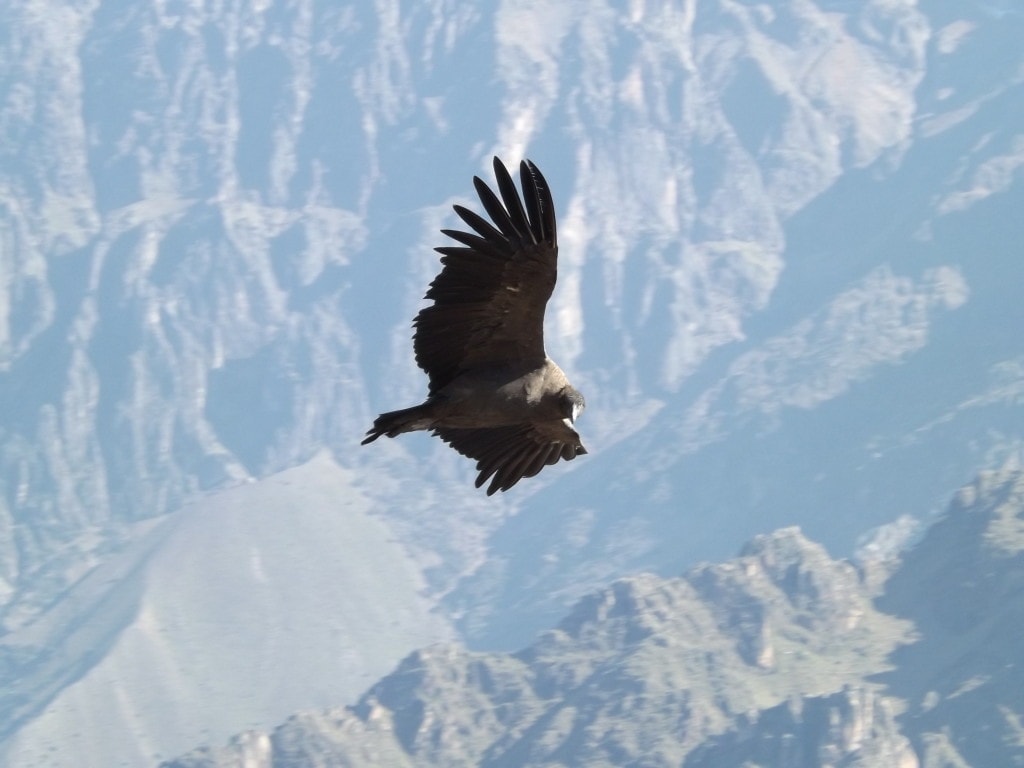
As the birds started to climb higher, we headed up to the top of the hill to the mirador Cruz del Condor, getting there before most tour buses arrived so that we were able to grab the best seats, right on the edge with our legs dangling over. I hadn’t expected a bird-watching session to be much fun, but the condors were spectacular. We saw about ten or so, including six huge, black and white adult birds, and they flew so near to us on each spiral that we got a fantastic view. Sitting in the warm sun watching these enormous birds swirl and glide past us was a fantastic start to the day.
The next stage was a mountain bike ride all the way from the mirador down to the town of Cabanaconde. After the amazing fun of our mountain biking experience on the Inca Jungle Trek, I was really excited about this, and once we set off alongside the stunning valley we were instantly rewarded.
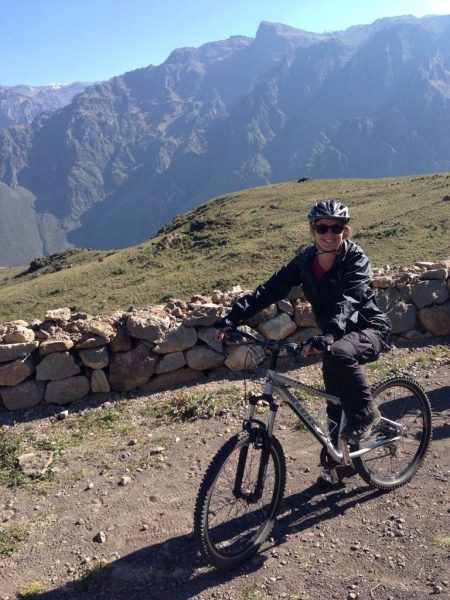
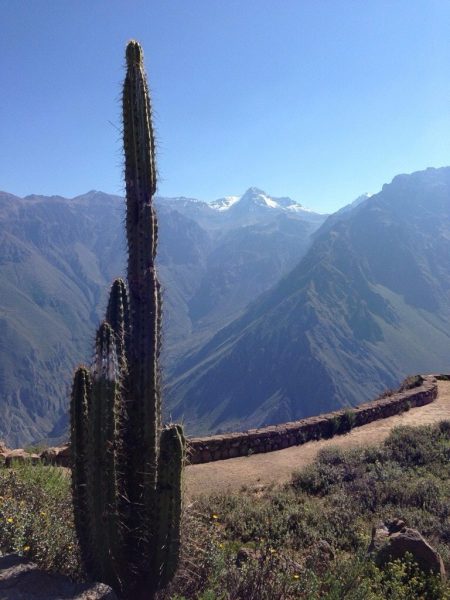
After the first five minutes came a slight uphill section of about 1km, which was only a fairly gentle slope but which knocked me so out of breath thanks to the altitude – which I don’t cope well with – that I could barely move, and had to get back on the van to reach the top of the hill. It was so embarrassing riding up behind everyone else in the bus, but when I reached the top and saw how much the rest of the group were panting I realised it really was the altitude, and not just me.
After that, it was downhill all the way and so much fun. Although I was one of the slowest in the group, I wasn’t right at the back and I was going really fast down a smoothly curling tarmac road. At one point, three of us zipped past a group of cows in the road, so fast that we scared one and it scrabbled back down the hill, almost falling in the process. The feeling was incredible, speeding along empty roads surrounded by incredible scenery and bright sunshine, with the snow capped peaks of distant volcanoes glowing white in the distance.
We arrived in Cabanaconde and were stunned to discover it was only 11am. I’d already had a much fuller day than I ever do normally, and it wasn’t even lunch time! There was quite a long wait while we all changed into shorts, applied liberal amounts of suncream, and handed over all our stuff to be loaded up on mules for the trek into the canyon.
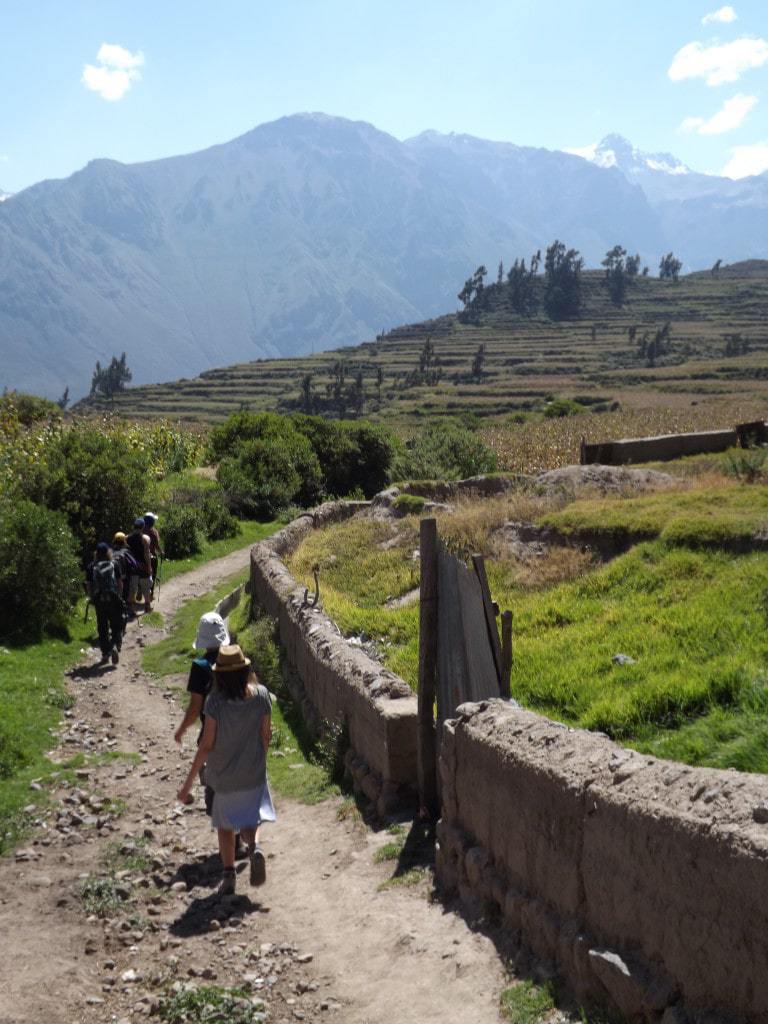
Finally, though, we set off in the now baking midday sun towards the edge of the canyon, walking first through tall fields of yellow corn and quinoa in a landscape that could have been European countryside, before coming out suddenly at the edge of the staggeringly deep canyon.
As we left the town, Sam stumbled upon a local dog who took an instant shine to him (might have had something to do with the crackers in his pocket), and who followed our group for the entire trek. Since the dumpy little dog, with his scruffy beige fur, looked just like the dog from Anchorman, we nicknamed him Baxter and rewarded him with drinks of water and biscuits all the way down, not to mention lots of leftovers from lunch.
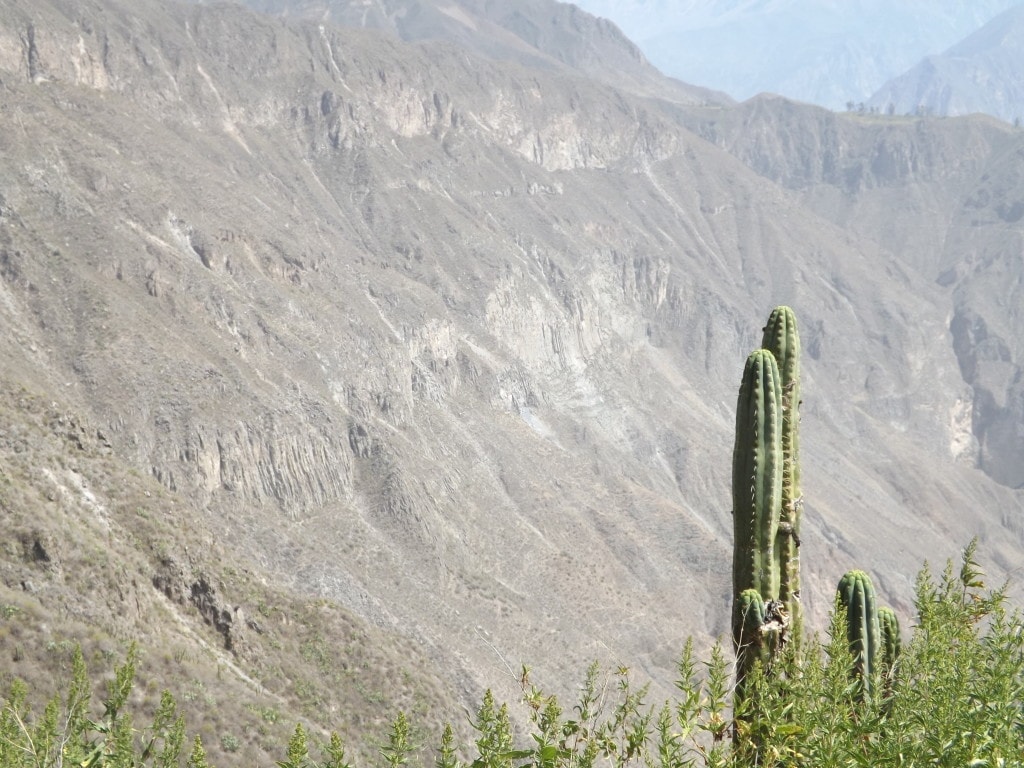
The trek down was tough, following a steep, winding trail with loose rubble and dust underfoot, our feet constantly slipping and our knees working overtime to keep ourselves from running or falling down the cliff-side. The heat was baking, the air dry and full of swirling dust, and the sharp drop at the side of the path made my head spin. Christian, our guide, stopped frequently all the way down, pointing out the interesting fauna and faun, like the hallucinogenic San Pedro cactus and the weird, floury looking cochineal bugs which provide dye for food and make up worldwide.
After nearly three hours of painful downhill hiking, we reached the bottom of the canyon, and the riverside ‘oasis’; a gorgeous, green space of bright blue swimming pools, colourful flowers, and gently swaying trees. Although starving, we made time for a long, cooling dip in the pool before a very late lunch, then I spent the afternoon relaxing on a hammock in the sun while Sam and some others from our group went for another hike.
That night, we slept in small wooden cabins in the bottom of the canyon, heading to bed as early as possible in light of yet another early start in the morning.
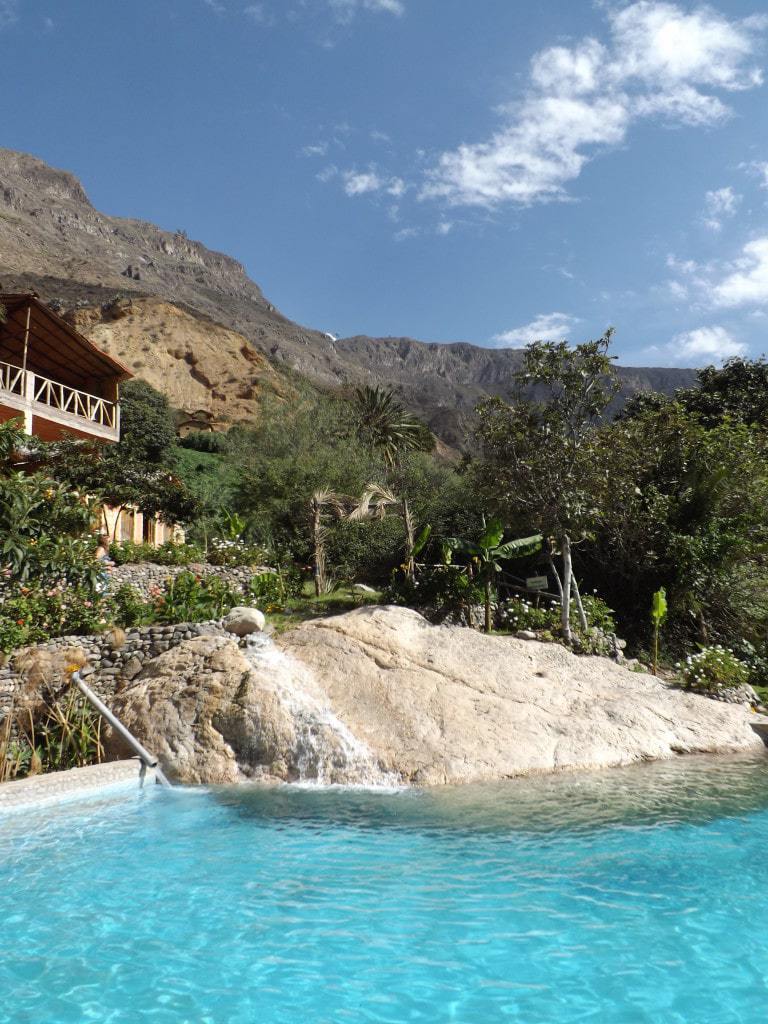
Colca Canyon Trek, Day Three
24th April 2014
The third day of the Colca Canyon trek started nice and early with breakfast at 4:30am, ready to start the long, painfully steep climb back up to the top of the canyon. I’m actually a little ashamed to admit this next part – so much so that I considered leaving it out of the blog altogether – but I didn’t hike back up. Given how badly affected I was by the altitude (I couldn’t even cycle up a gentle slope for 1km), how steep the 1000m ascent was, and how tired the climb down had made me, I did something I haven’t done much on this trip, and quit.
About thirty minutes after the rest of the group took off uphill, I was alone on the back of an ungainly mule with Raphael, the Peruvian guide employed to lead the pack of mules back to Cabanaconde. It was uncomfortable, and also terrifying; my mule walked on the very, very edge of the path, it’s hooves seemingly just an inch away from the ever-increasing drop beside us.
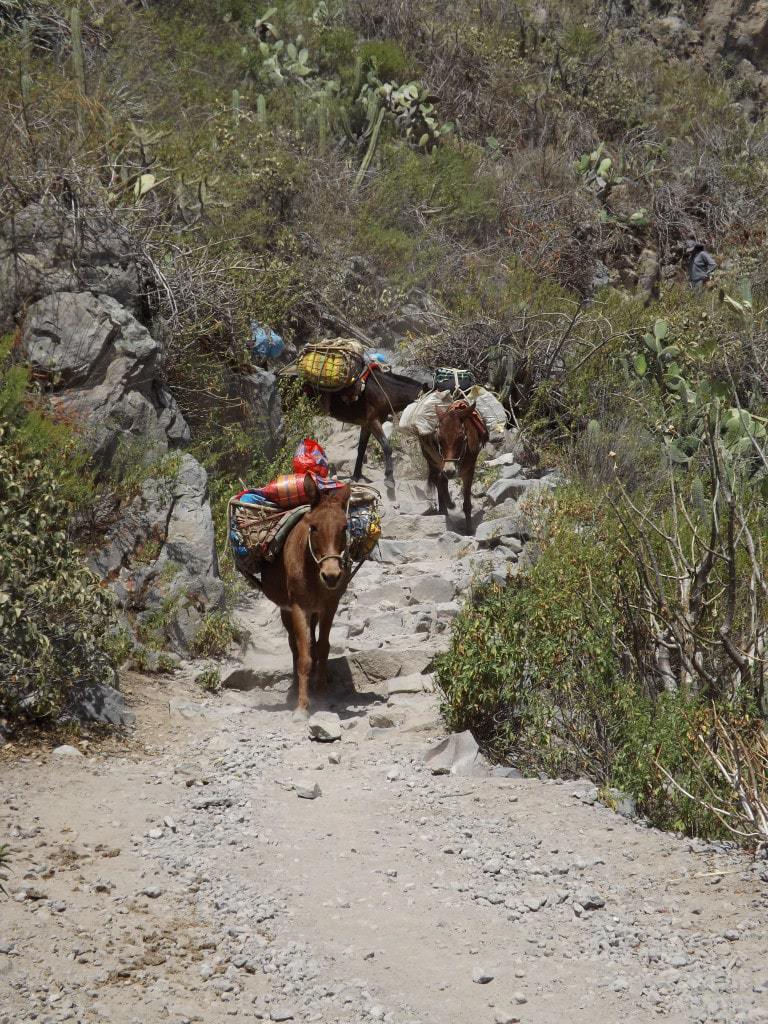
He scrabbled over the loose rubble, with numerous slipped feet, and constantly seemed seconds away from tumbling over underneath me. He also had no concept of looking where he was going; every time we reached a corner in the constantly zig-zagging path, the mule didn’t notice that there was no path to put his feet on until he’d almost stepped onto thin air, then jerked around back onto the path, lurching underneath me.
I was so afraid of falling into the canyon, Wile-E Coyote style, that the experience was almost tougher than walking. But, given that I was out of breath just on the back of a mule, I highly doubt I could have made the climb which, according to our guide, would take up to three hours. The other problem was that my mule decided to be so stereotypically stubborn that we barely reached the top.
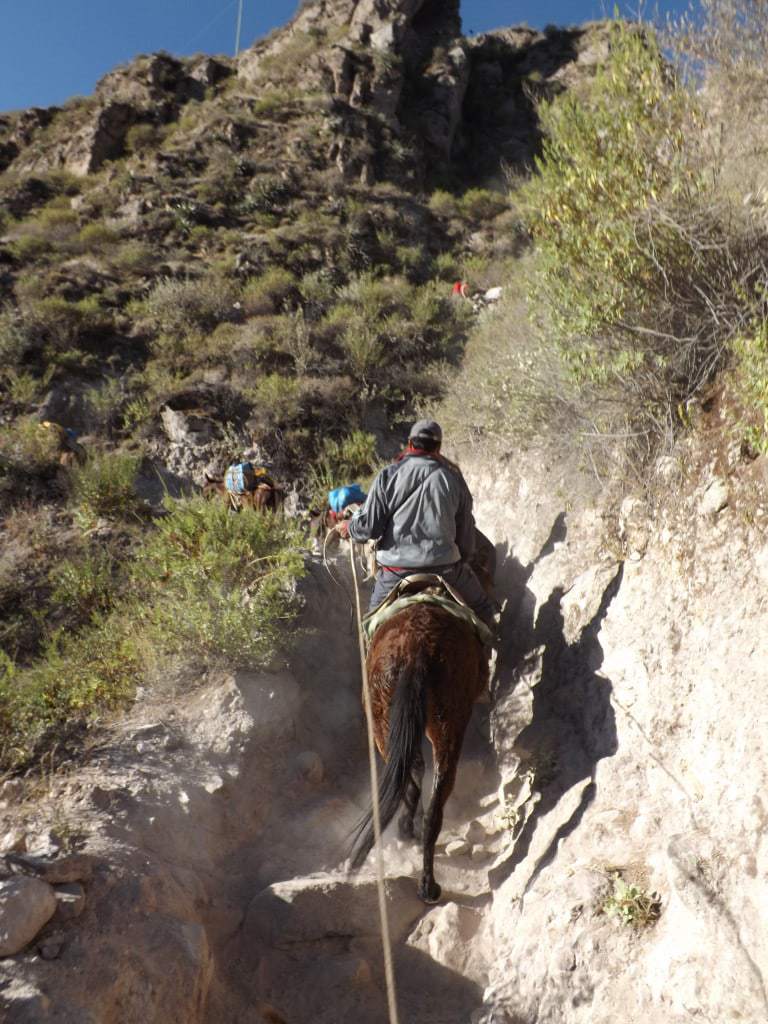
Every time Raphael was out of sight, the mule stopped still in the centre of the path and refused to keep walking no matter how much I tried to reason with him. The only highlight was the incredible sunrise, breaking over the canyon cliffs behind me, washing everyone in watery golden light.
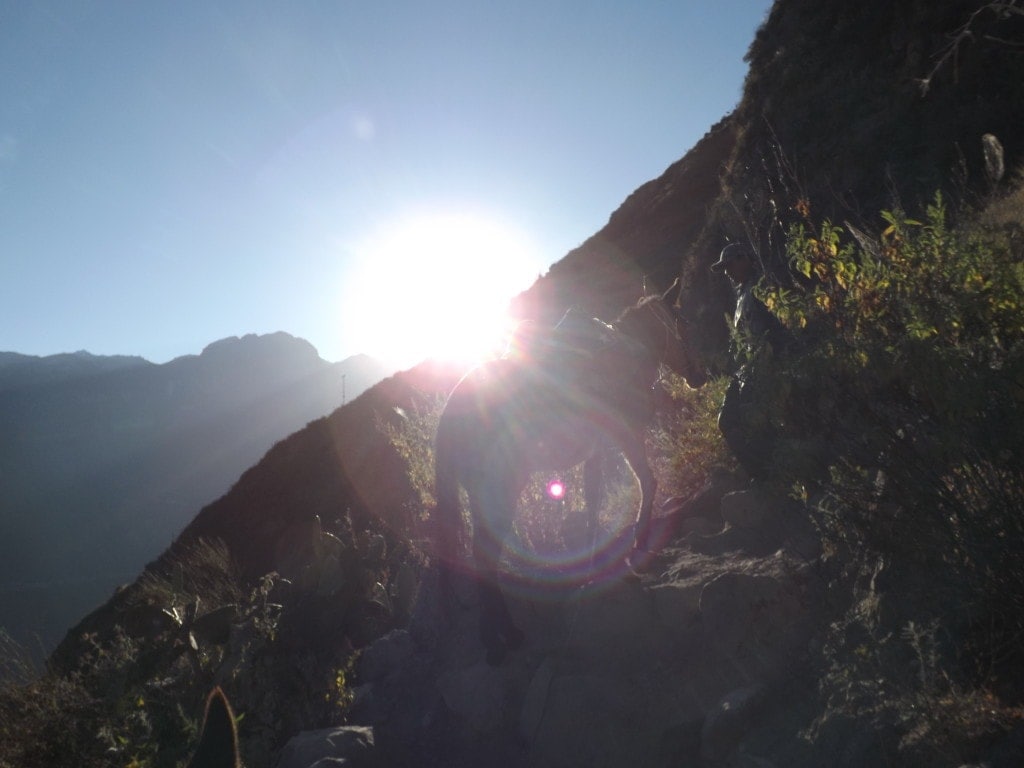
Sam, on the other hand, not only walked all the way but also reached the top in the impressive time of one hour forty. I had planned to ride smugly by on my mule while he huffed his way up, red and sweaty, but instead, he reached the top well before I did, and had already recovered by the time I got up there.
Honestly – I felt really bad for not having walked, especially after I dismounted and saw how sweat-soaked my poor, tired mule was, leaving me feeling super guilty for making him carry me when I could have walked myself, no matter how hard it might have been. I can only hope he had a nice big drink of water and a very long rest when he got home.
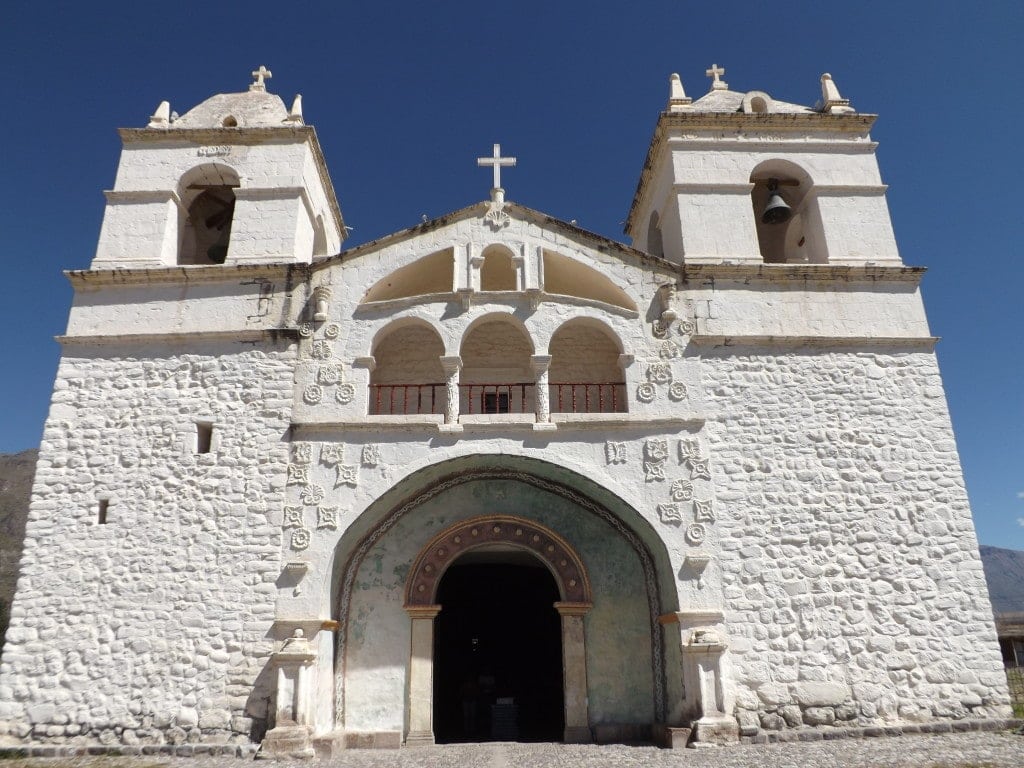
From Cabanaconde, we bundled back into our minivan and drove to the town of Maca to visit Santa Ana church, followed by the hot springs at Chivay. Thanks to our early start and the group walking up the canyon in record time, we got to the springs about 11am, when they were still empty; most other groups didn’t arrive until nearer 12.
Down in a valley beside a freezing cold river – which all the boys decided to jump into first, for some unknown reason – the several pools of bathlike warm water were the perfect way to relax our aching muscles after the three days of trekking (and, for me, mule riding).
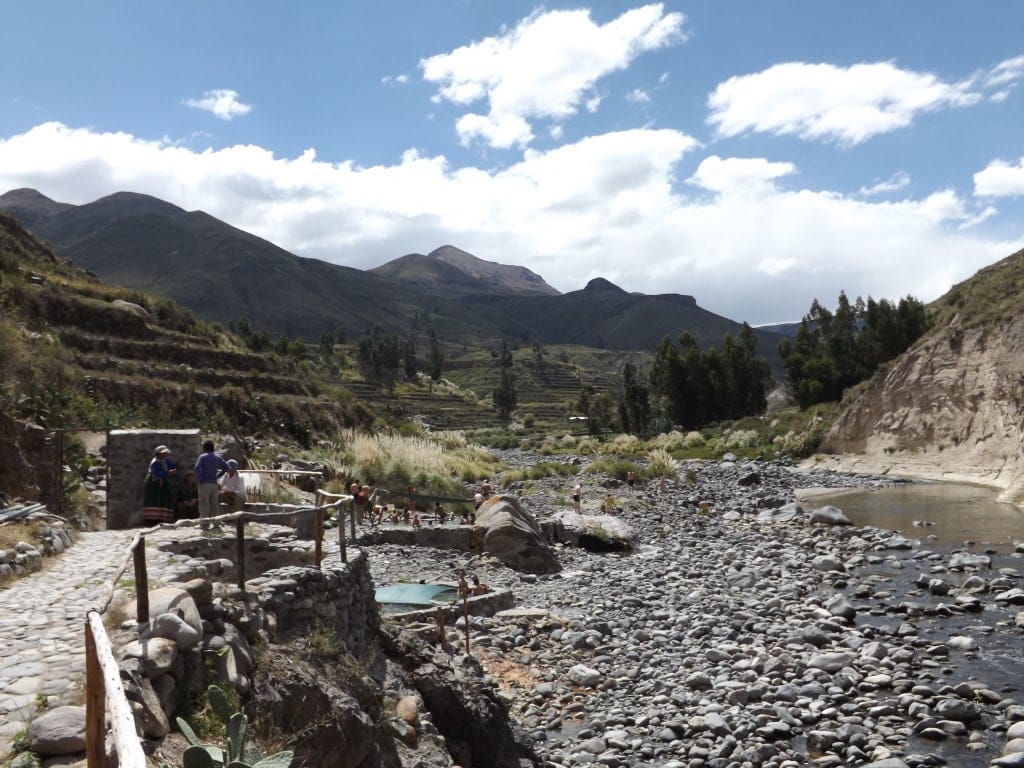
After another huge buffet lunch in Chivay, and a brief, impromptu tour of the town’s plaza from Christian while we waited for a guide from another group to swap with us, we headed back to Arequipa. En route, we stopped again at the Mirador de los Andes, because the sky was much clearer and from there we could see the enormous grey ash cloud above Ubinas volcano, which had erupted the week before.
We arrived home in Arequipa exhausted, but having had the most fantastic three days of exploration, adventure and stunning scenery.
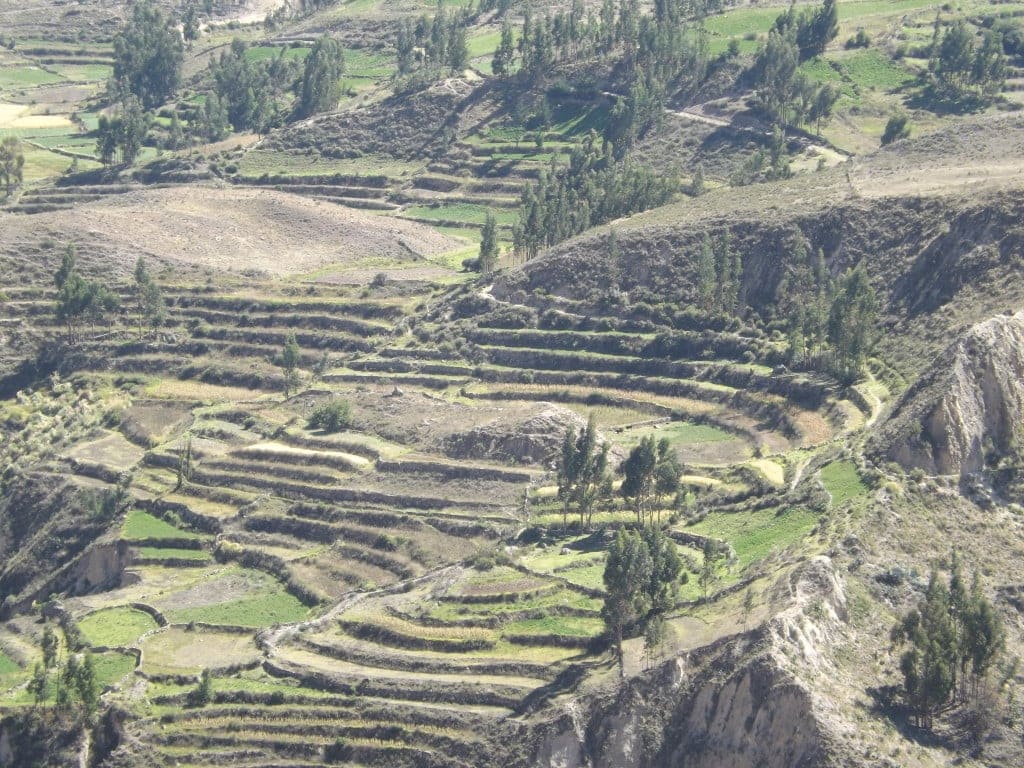
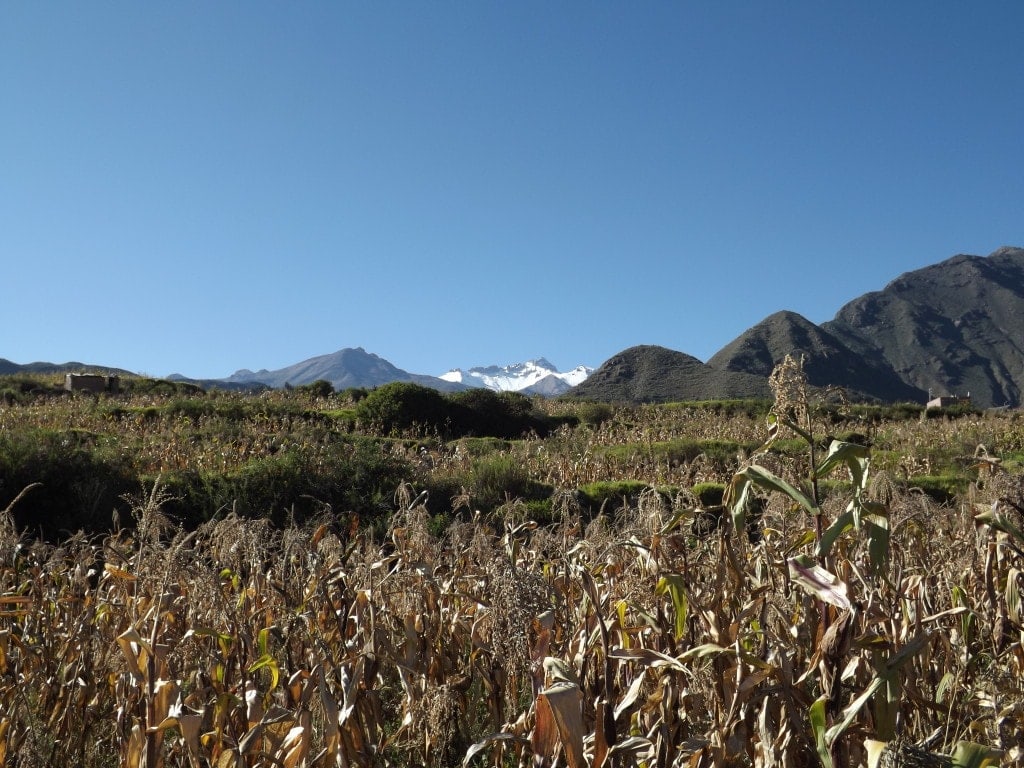
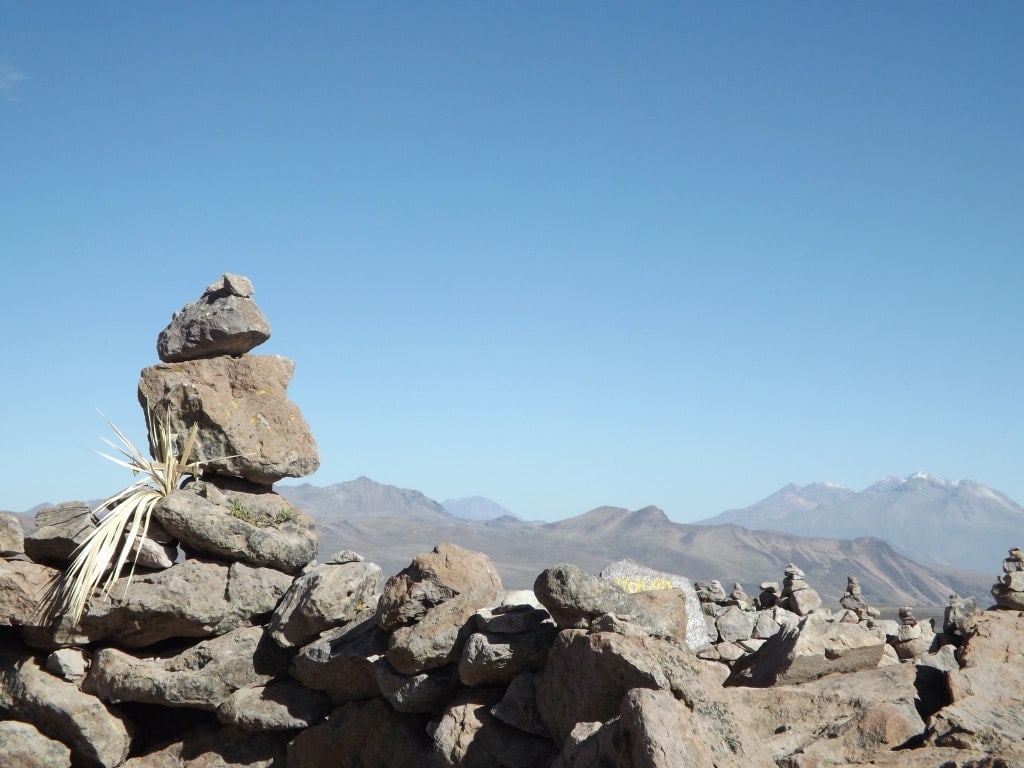
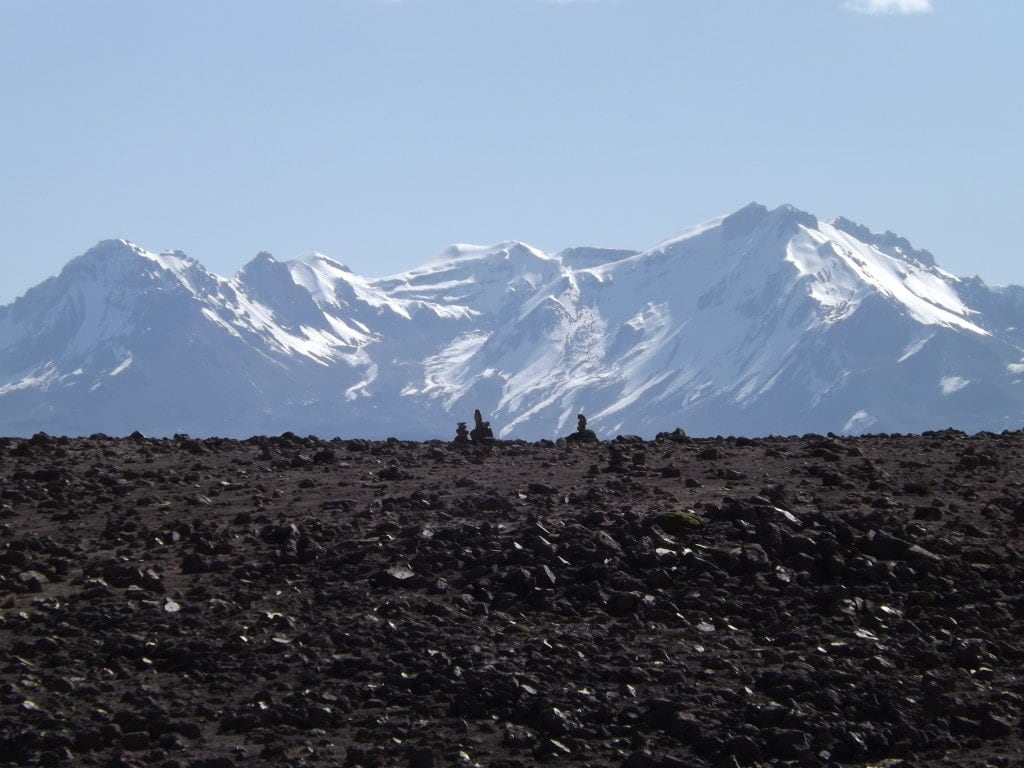
Colca Canyon Trek Information
We did the three-day tour with Colca Trek, a company I would highly recommend, and paid £140 GBP each for the two night/three-day tour including accommodation, food, snacks, water, guide and all entrance fees.
Arequipa Walking Tour
25th April 2014
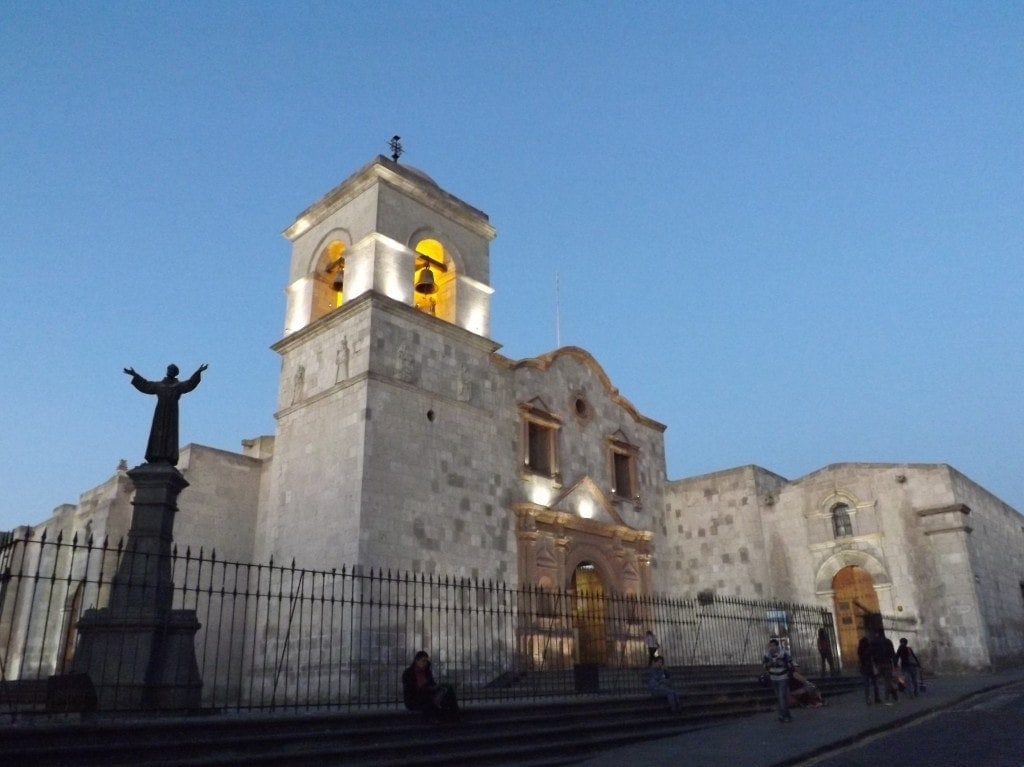
Arequipa, the white-painted colonial city we stayed in either side of our three day Colca Canyon trek, was a beautiful, relaxed place with loads of pretty architecture.
The whole city centre doesn’t stand much taller than two storeys, and almost every building is painted white, giving it a very small-town feel, in spite of how big the city actually is.
In the distance, the huge grey shape of El Misti Volcano, a mountain sacred to the town, can be seen brooding over the town, sometimes smoking ominously.
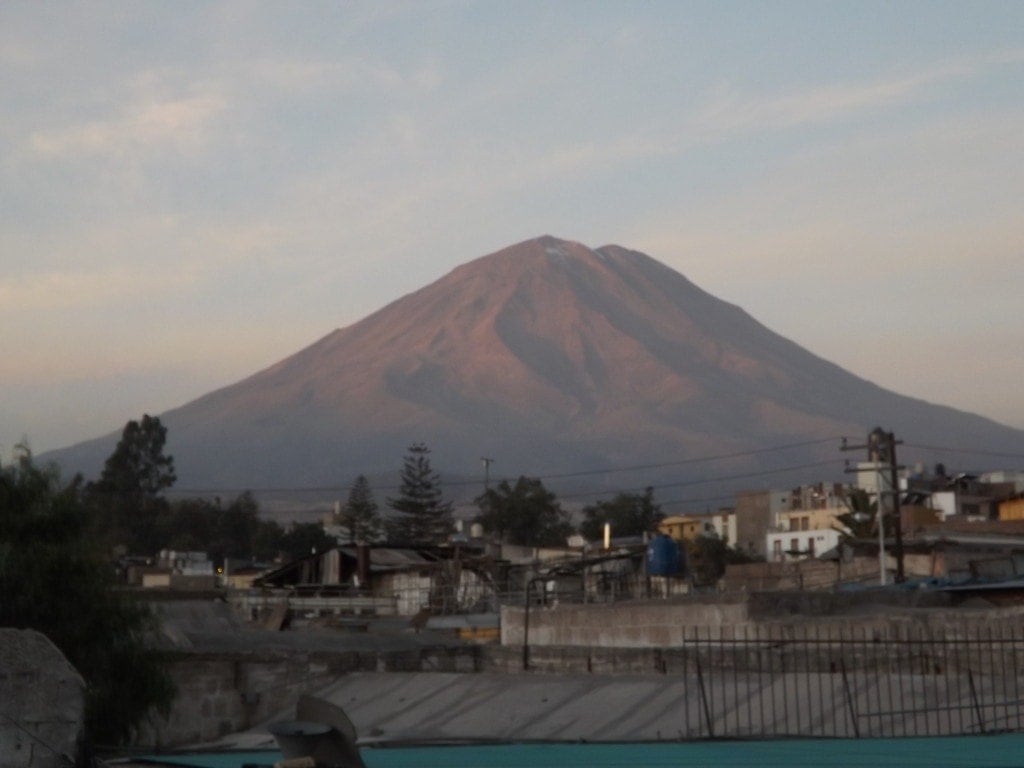
Arequipa Downtown Walking Tour
The best way to explore the city was with the free city tour. Unfortunately, Free Walking Tour Peru – who’d shown us around Cusco – were not running on the day we decided to do the tour.
So we went with Arequipa Downtown Walking Tour instead, who were also really cool. Our guide, whose name I never caught because he introduced himself so quickly, was the most enthusiastic tour guide I’ve had yet, and threw so many facts at us that I’m surprised I’m not a qualified expert on Arequipa now.
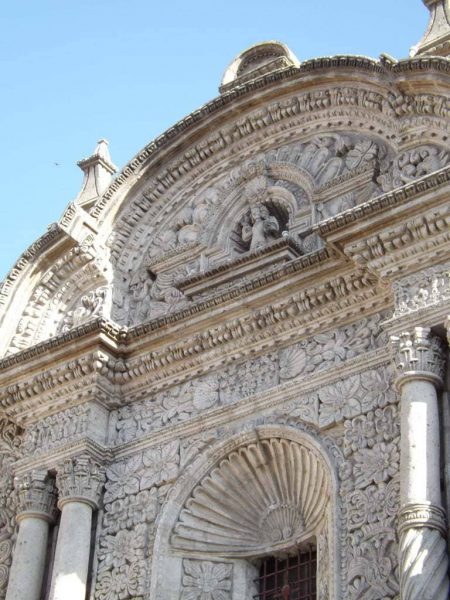
As per usual, though, I forgot almost everything and only retained the most outstanding or humorous facts; for example that Arequipa is known as the White City not because of all the pretty white buildings, but because of the number of white people that made a home there in Colonial times.
Main Plaza and Arequipa Cathedral
We started in the main plaza, where we were able to view the impressive, bright white cathedral from the outside, and learnt about one of Arequipa’s most precious relics, the Black Jesus
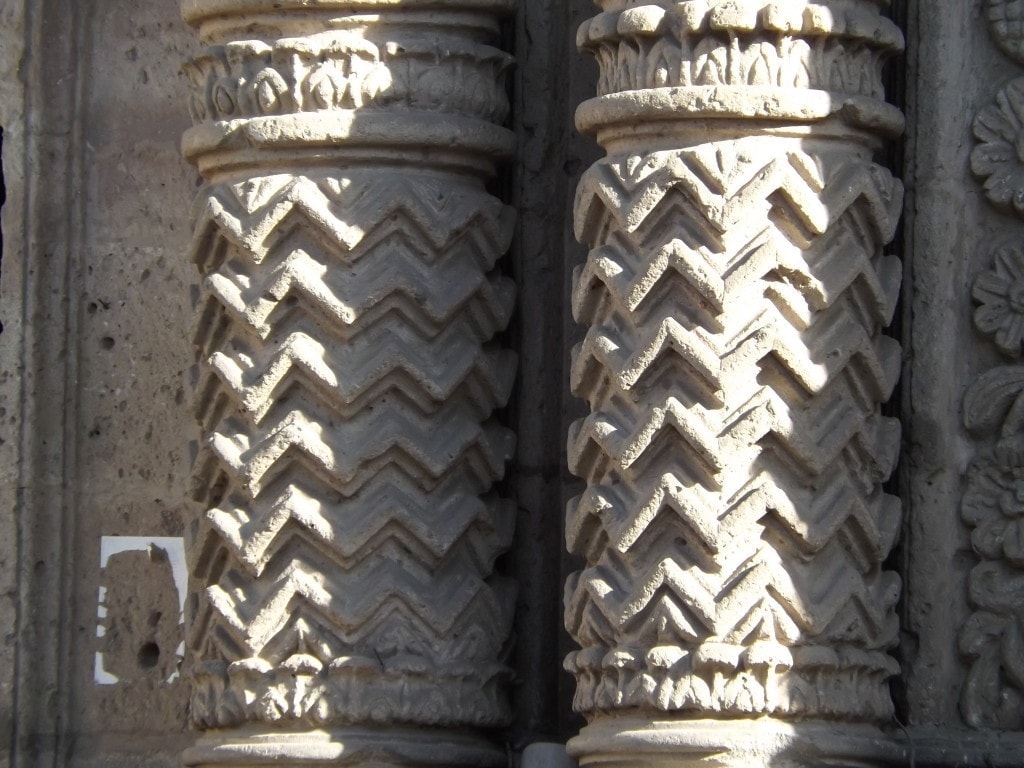
Apparently, this statue of Christ was the only thing to survive a fire in the cathedral, albeit badly burnt and blackened, so the locals decided it must be a sacred artefact, and worship it proudly.
We also viewed the nearby Jesuit church, again brilliantly white and with an ornately decorated façade which contains one of the best examples of Baroque architecture mixed with Inca symbolism; our guide pointed out the jaguar faces, maize, and snakes lurking amongst the Christian carvings.
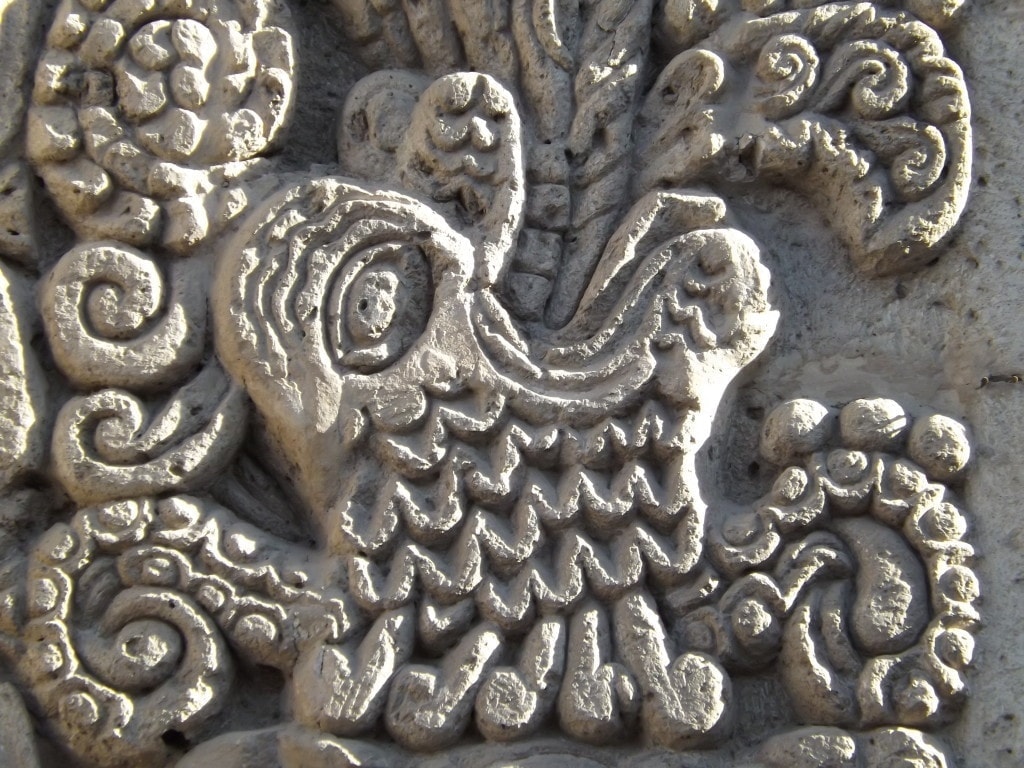
This mixture continued inside, where a huge sun – the main god of the Inca people – can be seen at the centre of the golden alter, proving to the Incas that their god was inside the Jesuit church, and half tricking them into conversion.
The baroque-Inca hybrid continued throughout the city; in a nearby courtyard with a pretty central fountain, we found still more Inca symbols and faces worked in amongst the carvings around the walls.
Exploring Downtown Arequipa

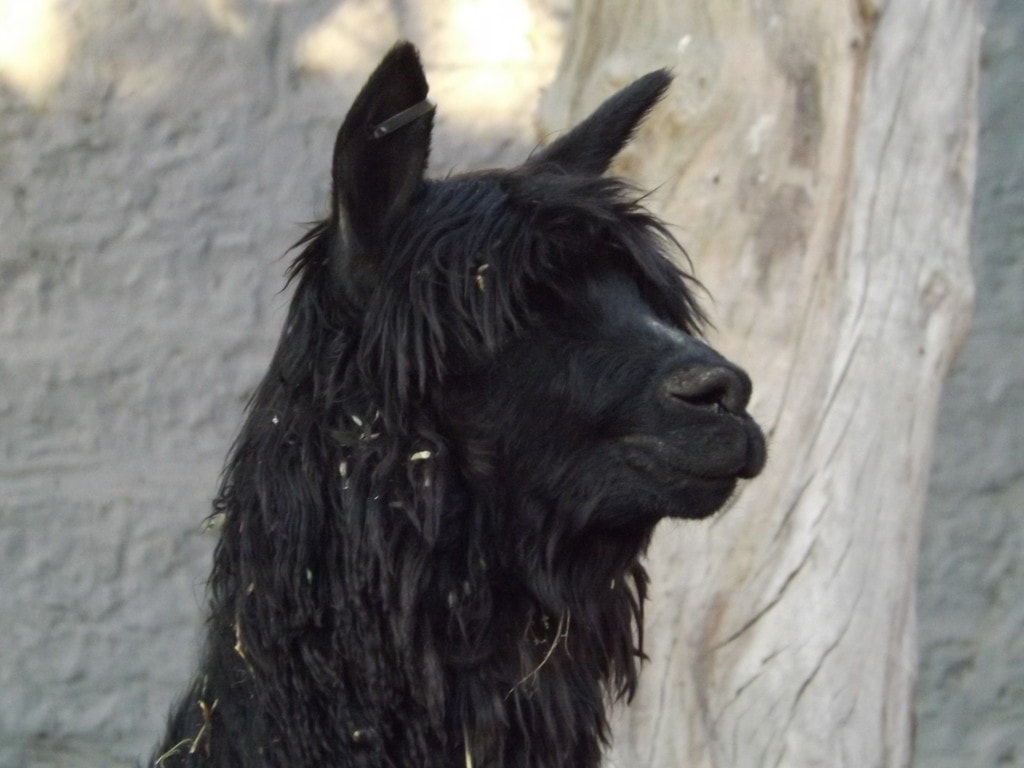
There were so many stops on the city tour. The old university, now a language school, which has a nice, quiet, garden filled courtyard. The Catholic Museum, where Juanita’s ‘mummy’ (that’s a nickname, it’s actually a corpse preserved in a glacier) is usually on display except in January-May.
A traditional colonial house, built around a central courtyard, with huge high doors and impossible-to-reach door knockers designed to be knocked by visitors on horses, and where the first-floor windows were the colonials’ daughters’ “version of Facebook”, their only outlet to the outside world because they were locked in all day for protection.
Next we visited the convent, and the Mario Vargas Llosa library, to which the author himself had donated thousands of books.
Alpaca Farm Arequipa
We also toured a small alpaca farm attached to a shop selling high-quality alpaca wool goods, where we saw alpacas and lamas, felt the high-quality vicuna wool, and watched two Andean women in traditional dress weave colourful products from alpaca wool.
Apparently, the women are from a small Andean village in the area, and take turns working at the ‘farm’ for tourists to raise extra money for their families, so I happily donated a coin each to them in exchange for a photo.
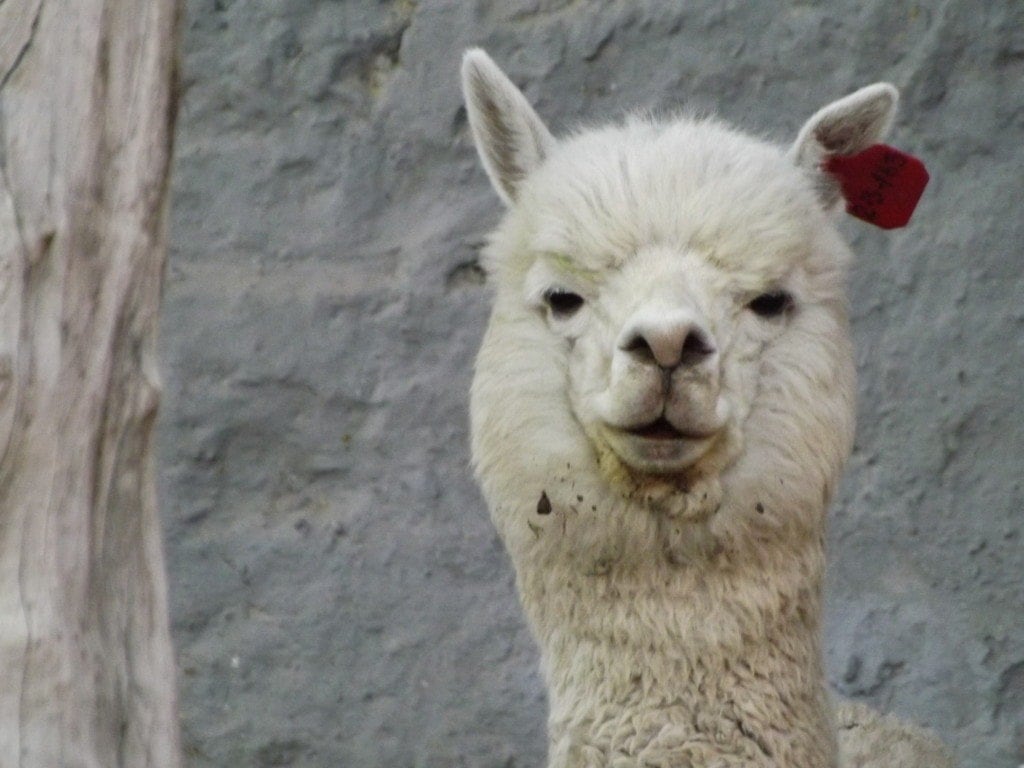
We finished on the roof terrace of a nice bar, where we learnt how to make the perfect pisco sour (the recipe calls for glucose syrup and a lot of sugar, as well as lemons, pisco and an egg white), and sampled a small one, before tipping our guide and saying goodbye.
As always, now that I’m writing this I wish I could remember more of the interesting facts I learnt during the tour, because Arequipa had a really rich and interesting history, a vibrant culture and a lot of beautiful buildings.
Free Arequipa Walking Tour
The free Downtown Arequipa Walking Tour starts in the tourist information office on the main plaza at 3pm Monday – Friday.
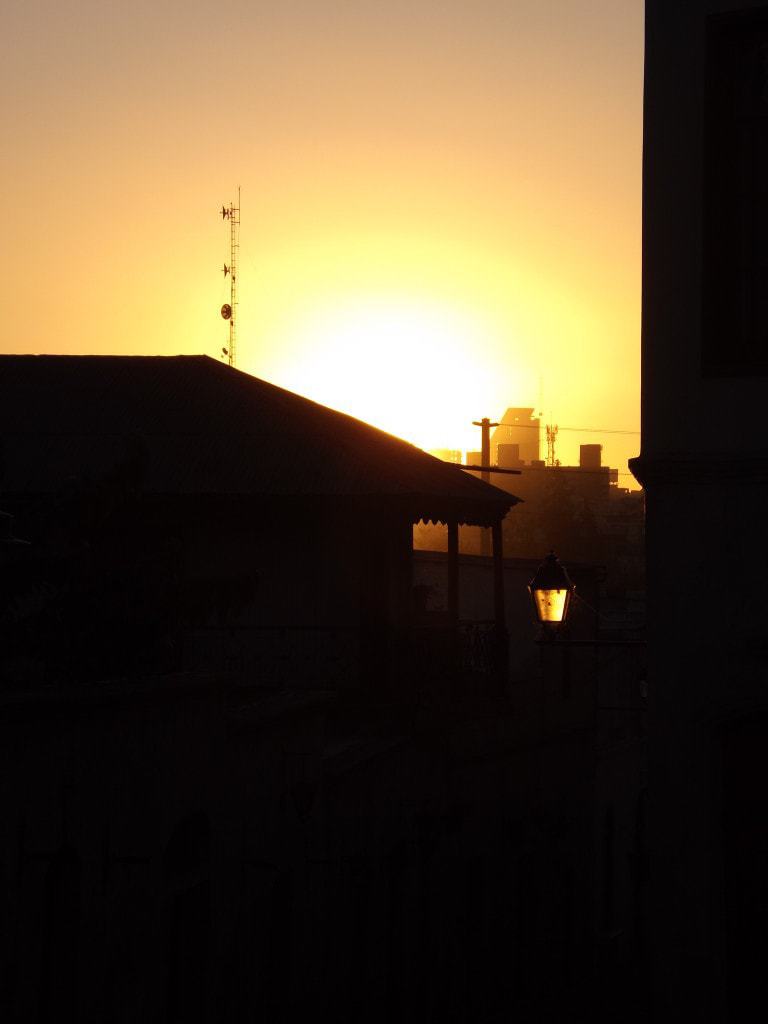
Floating Islands, Lake Titicaca
27th April 2014
After so many awesome tours, cities, and sights of the last few weeks, our final day in Peru was a tiny bit of a letdown, because we spent it taking a tour of the overly-touristy, disappointingly staged, floating islands in Lake Titicaca.
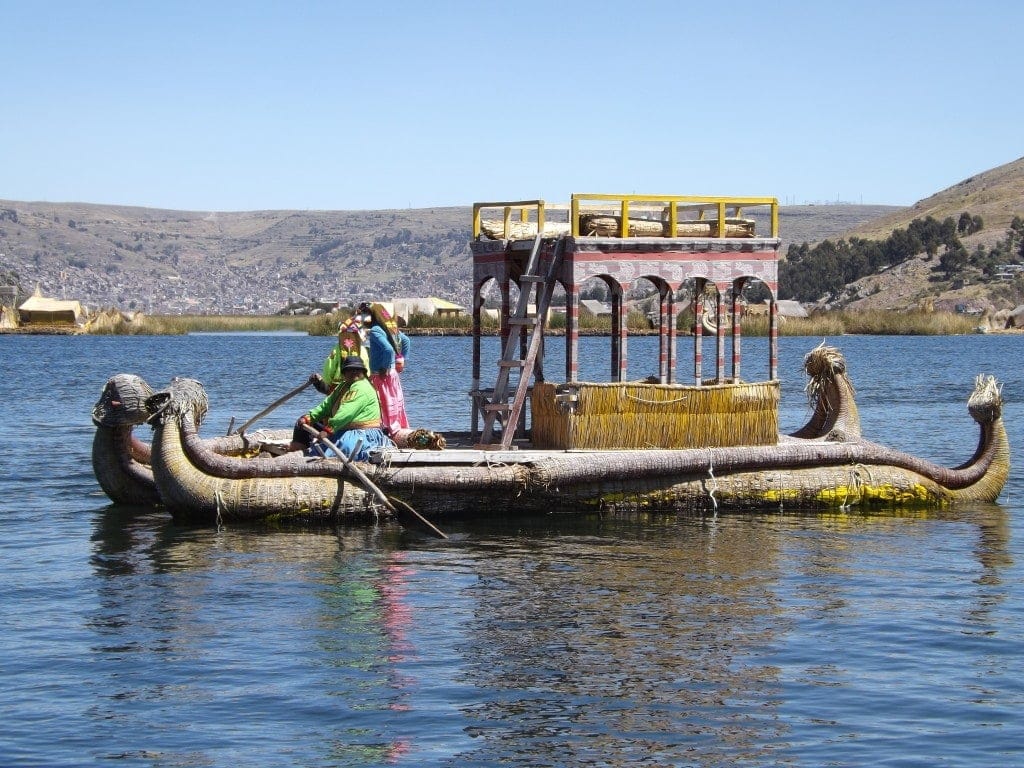
I’d been looking forward to Lake Titicaca , the highest navigable lake in the world, since reading about it in Motorcycle Diaries.
It seemed the iconic way to cross the border. But although the enormous, bright blue lake surrounded by green cliffs and mountains really blew me away – the famous “floating islands” were, sadly, not particularly amazing.
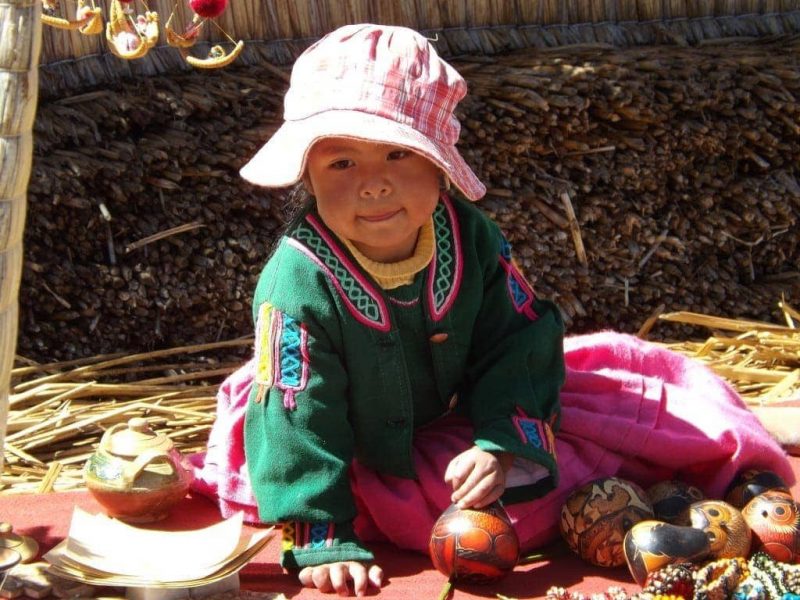
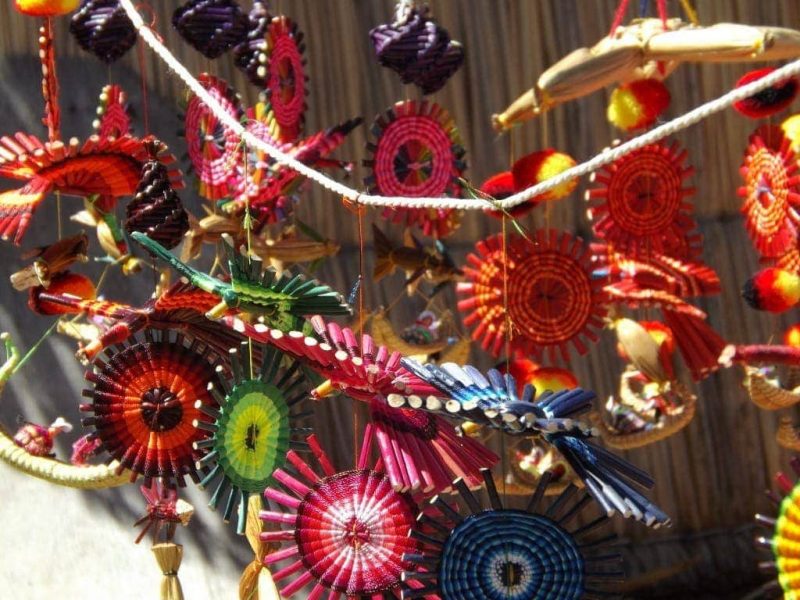
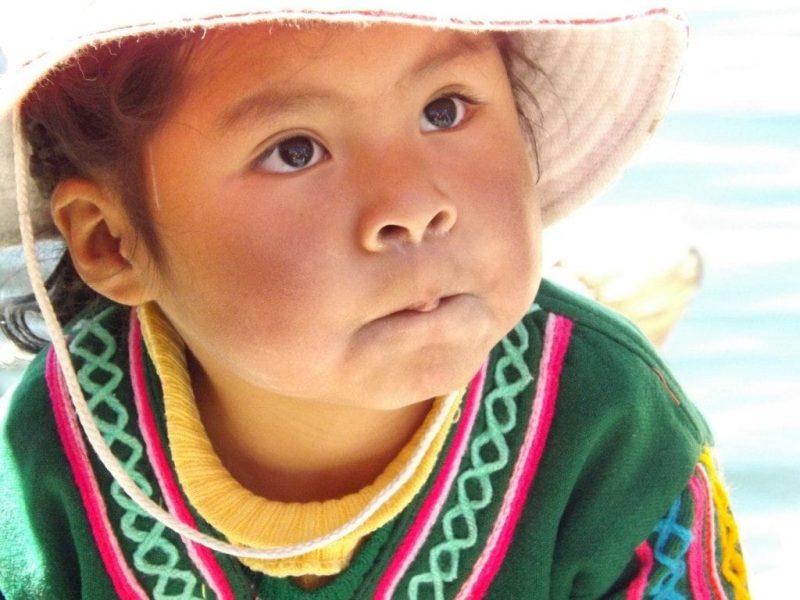
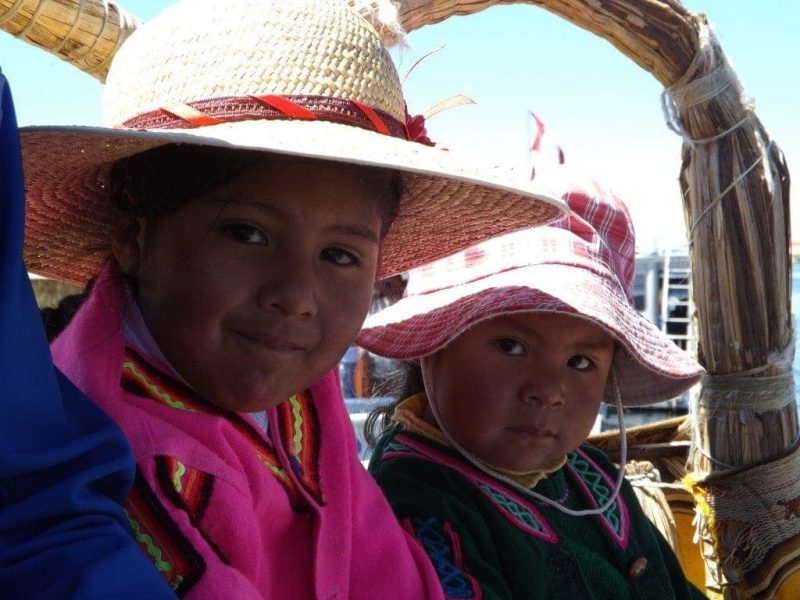
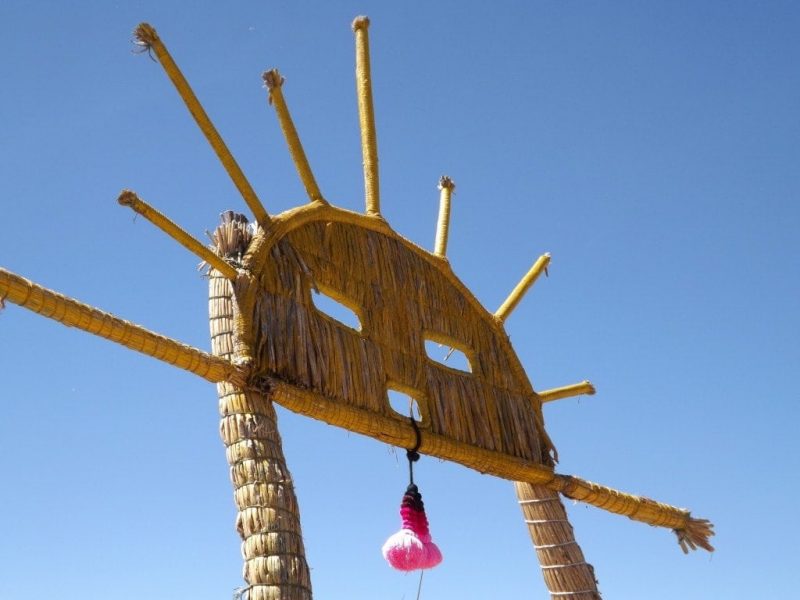
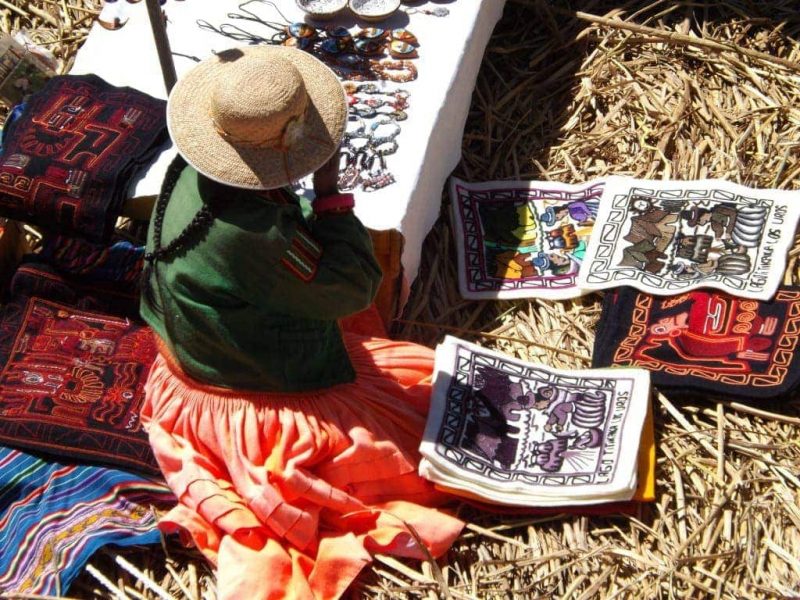
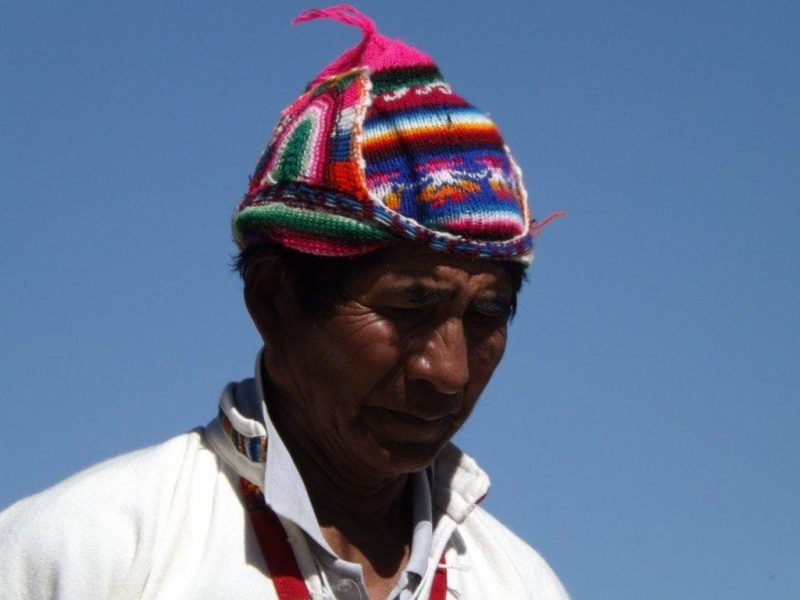
Our tour started around 9am, although the boat didn’t leave the small port in Puno for at least half an hour.
Eventually, though, we set off into the lake, which is pronounced Titi-ha-ha and means rock puma, passing the tall, straight reeds which are used to build the islands and almost everything on them.
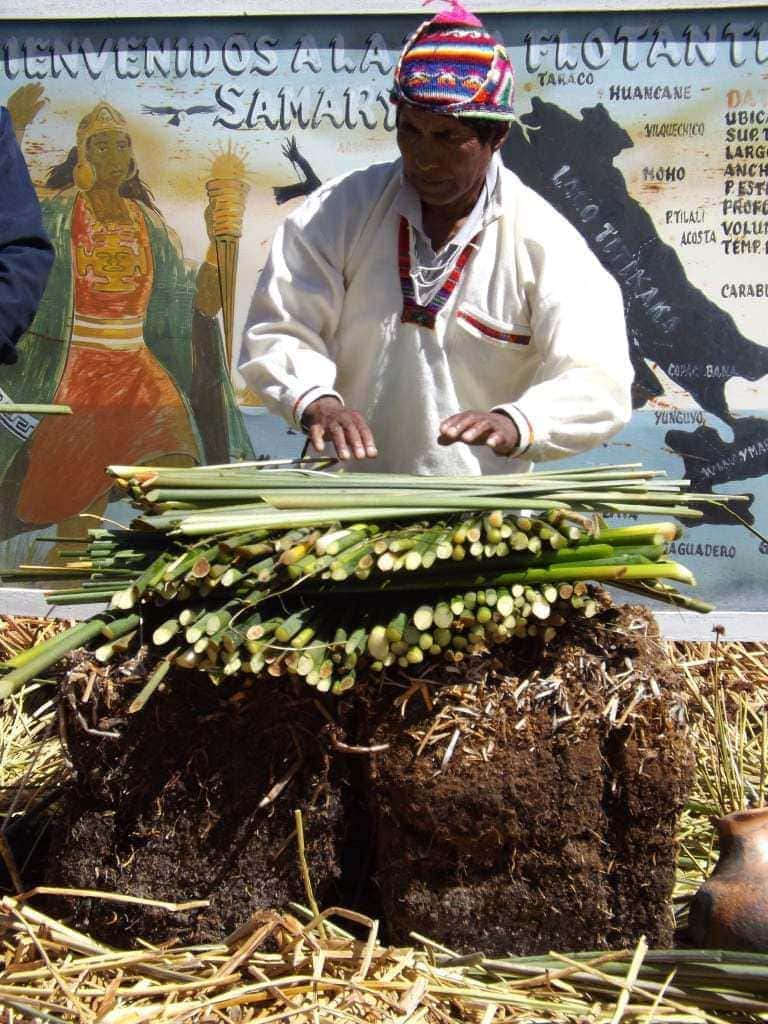
We arrived at one of a long line of small, roughly-rectangular islands built from compacted reeds, and jumped on from the boat. The ground underfoot was strangely bouncy, although thanks to the placid lake we couldn’t really feel that we were floating.
On arrival, we were greeted by the chief of that island, which has about six families living on it in small reed houses, and he helped our guide with a demonstration of how the islands were built, with the reeds being layered in alternating directions to create a thick grid. Apparently, these structures need maintenance at least twice a month, and we did see other islands being repaired or built up around the lake.
After the demonstration, the six ladies of the island divided us up into small groups and invited us, somewhat forcefully, into their homes. Sam and I, along with a Russian couple, went with a lady named Melissa, who was really sweet, but the experience as we sat on the edge of her bed and looked around her small, hut-like house was a little forced and very awkward.
She dressed us up in traditional outfits so that we could pose for photos; a baggy, embroidered shirt for Sam with a brightly coloured woolly hat, and a big, yellow skirt, cropped pink jacket and wide-brimmed hat for me.
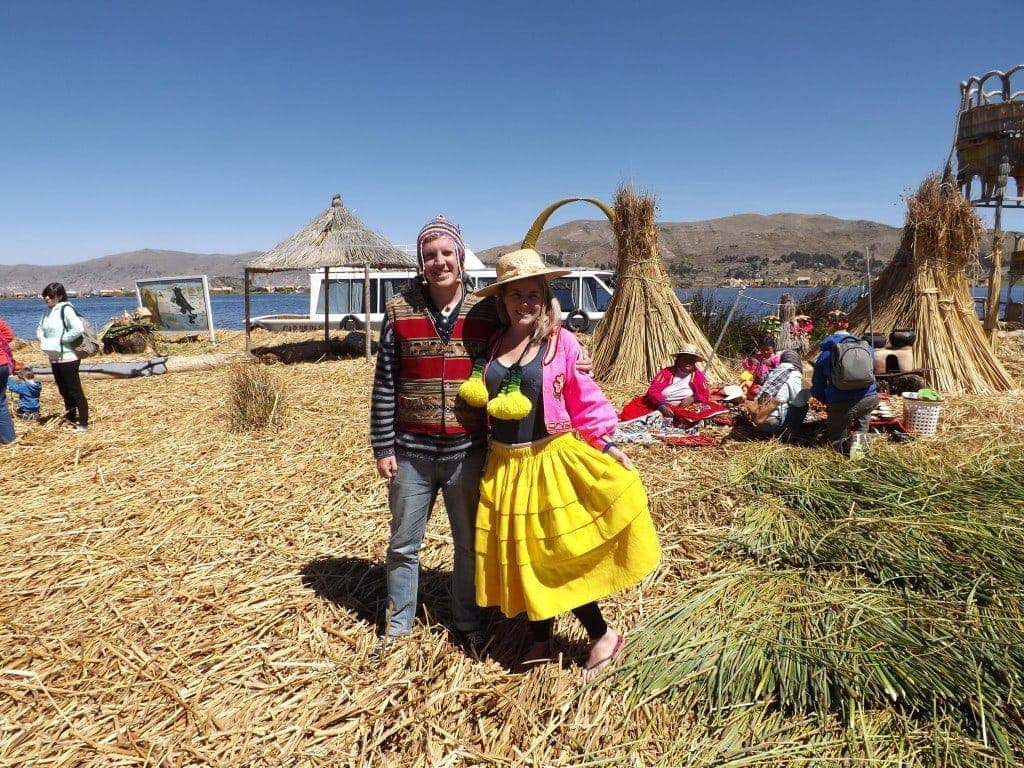
It was good fun, but everything felt so staged and so well rehearsed, and all of it led to a big salespitch for numerous handmade jewellery, mobiles and tapestries (which we felt slightly compelled to buy), that it sort of spoiled the experience.
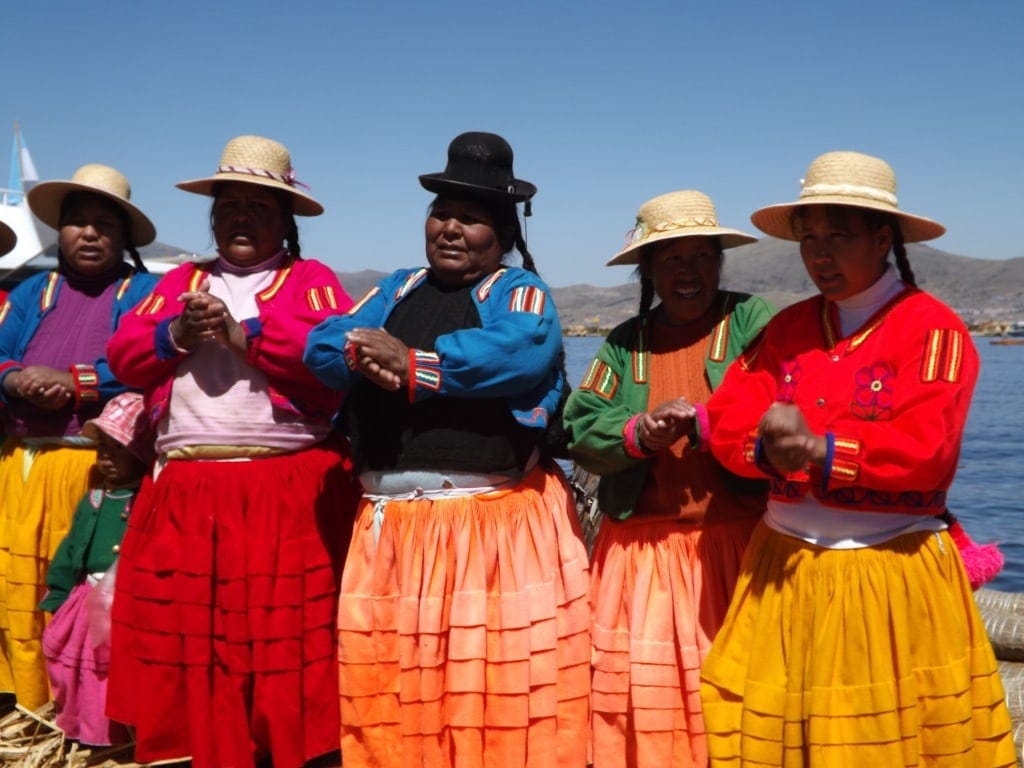
The most awkward part came when the six women of the village lined up to sing for us, all of them with thunderous, grimacing faces which clearly showed how little they wanted to. Afterwards, they shuffled around shaking hands with everyone, listless and bored, so that I almost couldn’t wait to leave. The best part of the day came when, for an extra S./10 each, we rode the gondola, a structure made from two reed canoes combined with a circular turret type thing to sit on, and spent the whole journey talking and playing with the two very cute, very shy little girls from the island.
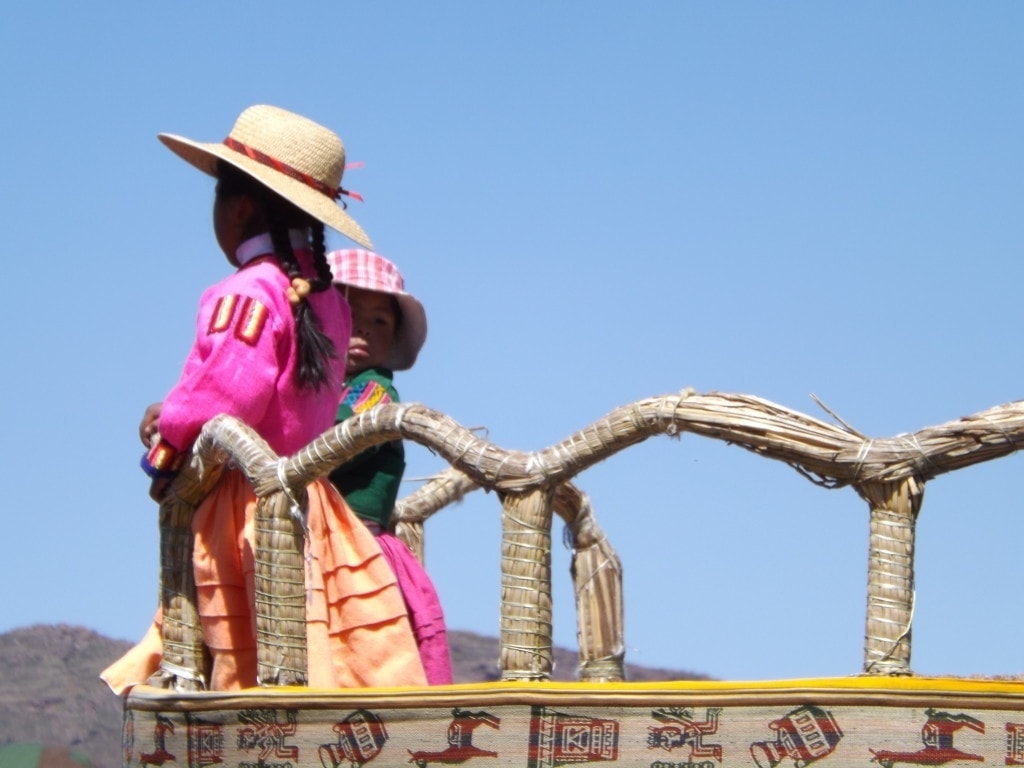
Although it was nice to see the lake, we later discovered that the Bolivian side is much nicer, and the whole forced, touristy experience of the Floating Islands seemed like a bit of a waste of time and money.
Read More
Read more about my South American Adventure in this timeline post.
Check out my Colombia Diaries for stories from the first leg of my trip.
Find out how to travel from Colombia to Peru on the Amazon River in my guide.
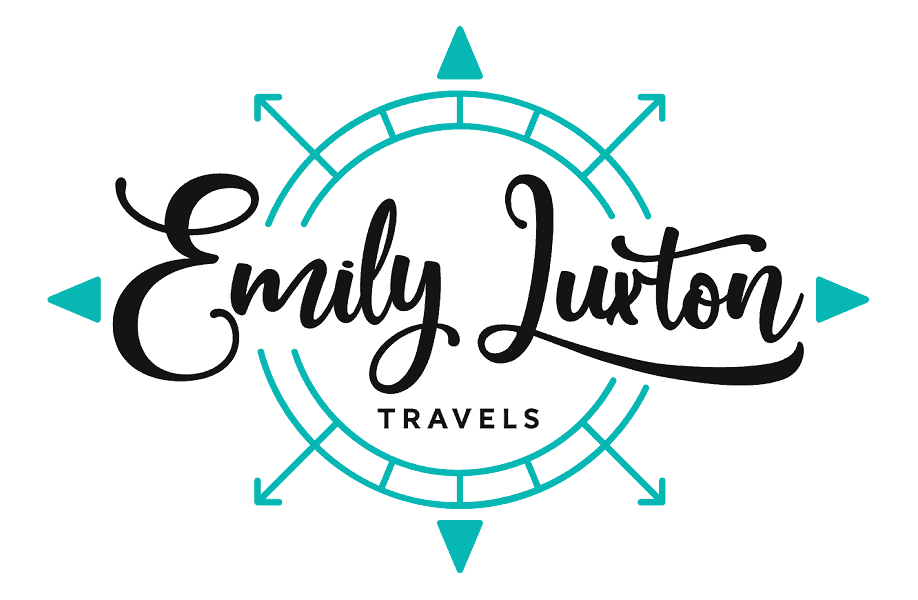

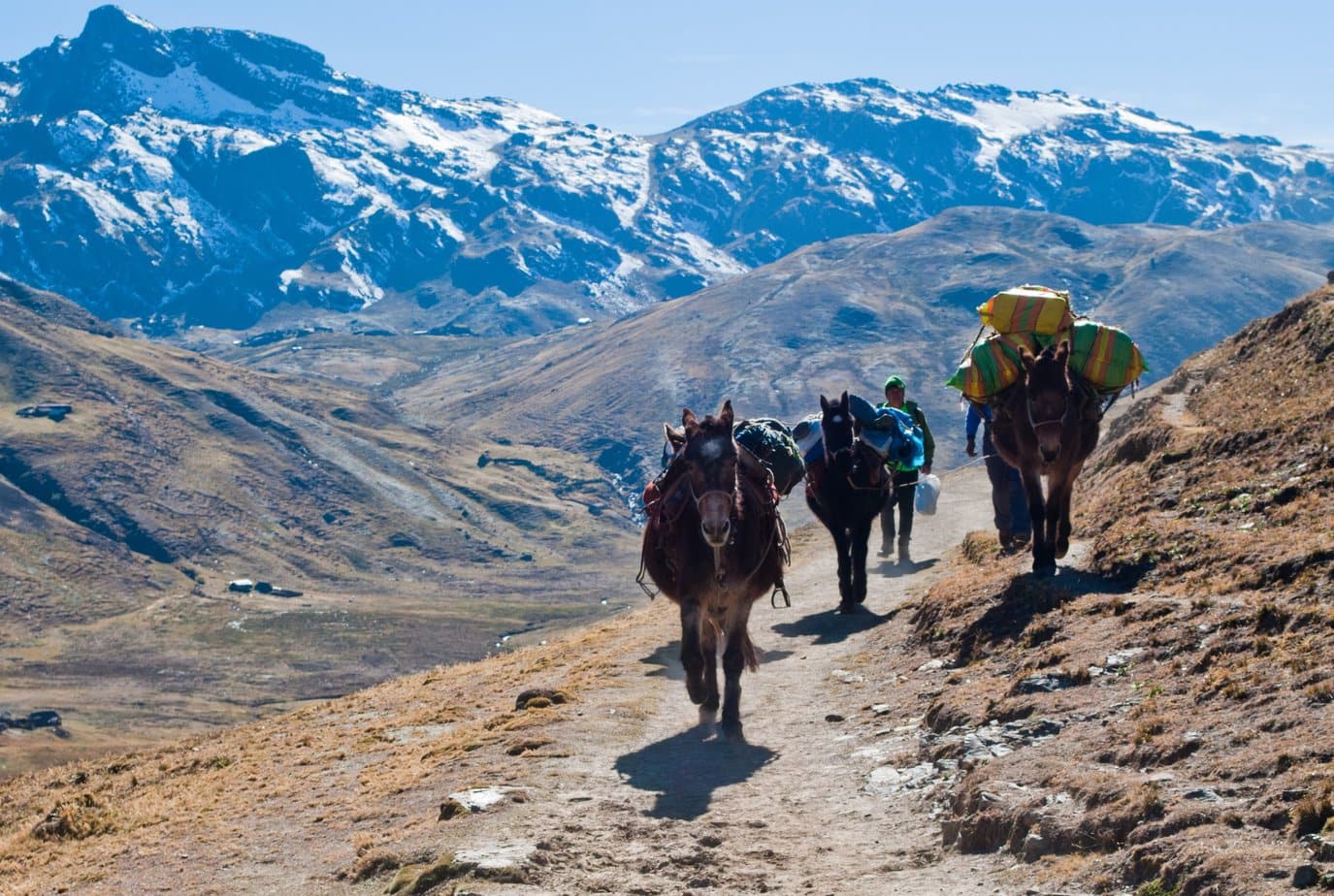
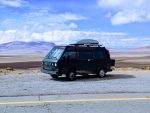
That turtle is freaky strange. Love the wildlife shots.
Thank you! Definitely the weirdest turtle I’ve ever seen – it looks like mud came to life!
So many beautiful animals you met there except for the snake. Aaaaa! :D
I have a weird thing for snakes so actually thought he was pretty – but it’s the biggest one I’ve ever held so it was pretty scary, too! Such a cool experience – especially loved the monkeys :)
My kids would love seeing all of those animals. Sloths are the cutest! And that turtle is wild. What an amazing looking creature.
It’s so cool – definitely worth a trip if you’re ever in Peru :)
Rosita the sloth may be the cutest animal I’ve seen in my life – wish I could have taken her with me!!
The Amazon is always one of those mysterious places that seems like an ambitious trip. How much planning and cost go into getting there and experiencing it to its fullest, do you think? It’s great you got to do this. That turtle is indeed bizarre looking. Cheers!
Thanks for commenting! Actually, we were already in South America so it wasn’t too expensive to get into the Amazon – just a flight from Cali to Leticia and a boat from Leticia to Iquitos. I think both were about £50 each. Accommodations in both Leticia and Iquitos were cheap, and then our jungle day tour cost about £40 ish. Flying out of Iquitos was the fastest but most expensive way out – I think that was about £40 again. Fairly expensive compared to our normal travel costs but still quite low! We made the whole thing up as we went along so no planning really!! If you get a chance to visit the Amazon don’t miss it, such a cool and strange place! :)
I fell in love with the rainforest in Costa Rica so visiting the Amazon is definitely on my list. That sloth is adorable!
She was the cutest thing ever :) Definitely visit the Amazon if you can – it’s such a cool experience (if a little tough and stressful to get to!!)
Love the last shot with the little monkey. I always get scared with doing shots like that thinking that I would probably get nervous and end up getting scratched by them.
He was only a baby and had been raised by humans so was super docile – he didn’t try to scratch or bite at all!! I am a bit wary of getting scratched but I knew this little guy was safe – the other ones we weren’t allowed to cuddle because they were a bit less tame!
Nice photos Emily! Reminded me to my trip to Iquitos (only that I sailed from Yurimaguas, Peru). And I didn´t get to hug a baby sloth :(
Thank you! How long was the trip from Yurinaguas? We were going to sail the other way, but heard varying reports of 2,3,5 day trips and didn’t have time!!
I’m dying for a shot of jungle wine – but only one. That monkey seems much friendlier than the one’s I’ve encountered in East Africa. Looking forward to part 2.
One is all you need – and I’m definitely not drinking it every morning as recommended by our guide! The monkey was a baby and had been raised by humans which is why he was so friendly, the other monkeys were much wilder and not really up for cuddles :)
This looks like a great trip – so many of the ‘accessible’ Amazon villages are very touristy, but you seem to have got into the real forest.
Thanks for the lovely post Emily! We went to the Amazon in Ecuador and it was great, but I never got to hug a sloth! Now I want to go back!
Thank you! The sloth was a definite highlight, head to the Peruvian Amazon next :)
Like the wildlife shots too. Cool snake and turtle. Another interesting sidenote from the region’s rubber boom history, one that’s both fascinating and tragic.
Thank you! The wildlife at the rescue centre was awesome – made the trip fantastic!
Ah we didn’t make to Iquitos when we were in Peru :(! However, I feel we missed out after reading your post!
Aw that’s too bad – it was awesome! Quite tricky to get too, though! Did you see the Amazon anywhere else in Peru?
Those animals are awesome, especially the monkey, although he looks unhappy about the photo haha. I love the idea of a city that can’t be reached by road – sounds exotic!
Haha, it was pretty exotic – but also very strange! The monkey was a little camera shy, too busy playing I think :)
This looks fantastic! I have always wanted to visit the amazon and hold a baby sloth. Looking forward to see what else you were able to see and do on the tour!
Thank you! It was such a cool trip :)
Aw, baby sloth! I hope to meet one some day. They are so adorable.
It really was the cutest animal I’ve seen!!
It makes such a difference to a trip when you have a great guide with a ton of facts. Sounds like a great trip!
Yeah, it’s so much more interesting. Wish I could remember more of the facts though!